Quick filters:
Liu bei Stock Photos and Images
 Gilt clay statue of Liu Bei, Wuhou Temple (Wuhouci), Chengdu, China Stock Photohttps://www.alamy.com/image-license-details/?v=1https://www.alamy.com/stock-photo-gilt-clay-statue-of-liu-bei-wuhou-temple-wuhouci-chengdu-china-38449298.html
Gilt clay statue of Liu Bei, Wuhou Temple (Wuhouci), Chengdu, China Stock Photohttps://www.alamy.com/image-license-details/?v=1https://www.alamy.com/stock-photo-gilt-clay-statue-of-liu-bei-wuhou-temple-wuhouci-chengdu-china-38449298.htmlRMC6FED6–Gilt clay statue of Liu Bei, Wuhou Temple (Wuhouci), Chengdu, China
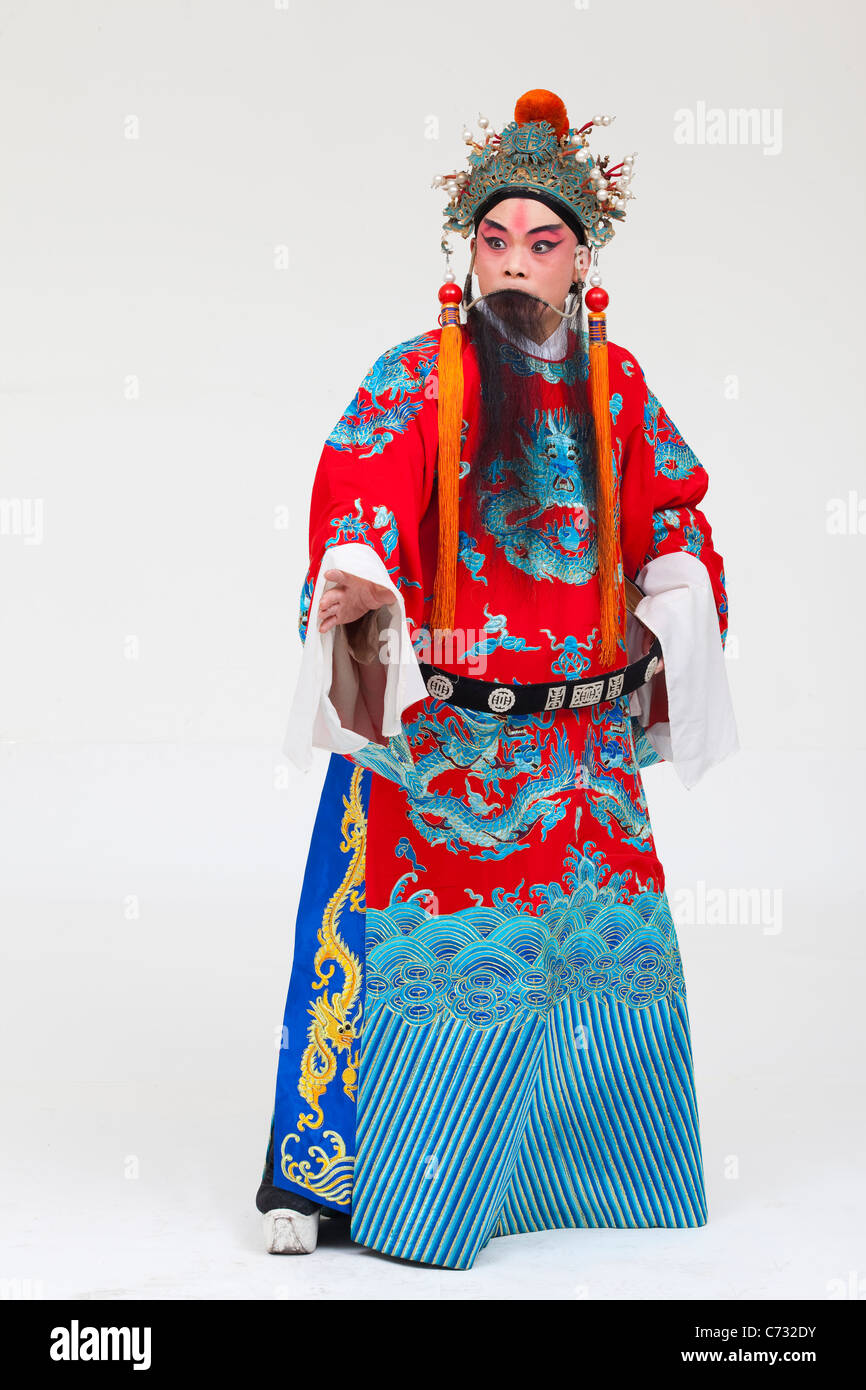 Liu Bei Opera Stock Photohttps://www.alamy.com/image-license-details/?v=1https://www.alamy.com/stock-photo-liu-bei-opera-38791143.html
Liu Bei Opera Stock Photohttps://www.alamy.com/image-license-details/?v=1https://www.alamy.com/stock-photo-liu-bei-opera-38791143.htmlRFC732DY–Liu Bei Opera
 Liu Bei (161 – 21 June 223 CE) was a warlord, military general and later as Emperor Zhaolie the founder of the state of Shu Han during the Three Kingdoms era of Chinese history. Despite having a later start than his rivals and lacking both the material resources and social status they commanded, Liu overcame his many defeats to carve out his own realm, which at its peak spanned modern day Sichuan, Guizhou, Hunan, part of Hubei and part of Gansu. Stock Photohttps://www.alamy.com/image-license-details/?v=1https://www.alamy.com/liu-bei-161-21-june-223-ce-was-a-warlord-military-general-and-later-as-emperor-zhaolie-the-founder-of-the-state-of-shu-han-during-the-three-kingdoms-era-of-chinese-history-despite-having-a-later-start-than-his-rivals-and-lacking-both-the-material-resources-and-social-status-they-commanded-liu-overcame-his-many-defeats-to-carve-out-his-own-realm-which-at-its-peak-spanned-modern-day-sichuan-guizhou-hunan-part-of-hubei-and-part-of-gansu-image344277330.html
Liu Bei (161 – 21 June 223 CE) was a warlord, military general and later as Emperor Zhaolie the founder of the state of Shu Han during the Three Kingdoms era of Chinese history. Despite having a later start than his rivals and lacking both the material resources and social status they commanded, Liu overcame his many defeats to carve out his own realm, which at its peak spanned modern day Sichuan, Guizhou, Hunan, part of Hubei and part of Gansu. Stock Photohttps://www.alamy.com/image-license-details/?v=1https://www.alamy.com/liu-bei-161-21-june-223-ce-was-a-warlord-military-general-and-later-as-emperor-zhaolie-the-founder-of-the-state-of-shu-han-during-the-three-kingdoms-era-of-chinese-history-despite-having-a-later-start-than-his-rivals-and-lacking-both-the-material-resources-and-social-status-they-commanded-liu-overcame-his-many-defeats-to-carve-out-his-own-realm-which-at-its-peak-spanned-modern-day-sichuan-guizhou-hunan-part-of-hubei-and-part-of-gansu-image344277330.htmlRM2B0356X–Liu Bei (161 – 21 June 223 CE) was a warlord, military general and later as Emperor Zhaolie the founder of the state of Shu Han during the Three Kingdoms era of Chinese history. Despite having a later start than his rivals and lacking both the material resources and social status they commanded, Liu overcame his many defeats to carve out his own realm, which at its peak spanned modern day Sichuan, Guizhou, Hunan, part of Hubei and part of Gansu.
 Liu Bei Tang detail Stock Photohttps://www.alamy.com/image-license-details/?v=1https://www.alamy.com/stock-photo-liu-bei-tang-detail-140209883.html
Liu Bei Tang detail Stock Photohttps://www.alamy.com/image-license-details/?v=1https://www.alamy.com/stock-photo-liu-bei-tang-detail-140209883.htmlRMJ4333R–Liu Bei Tang detail
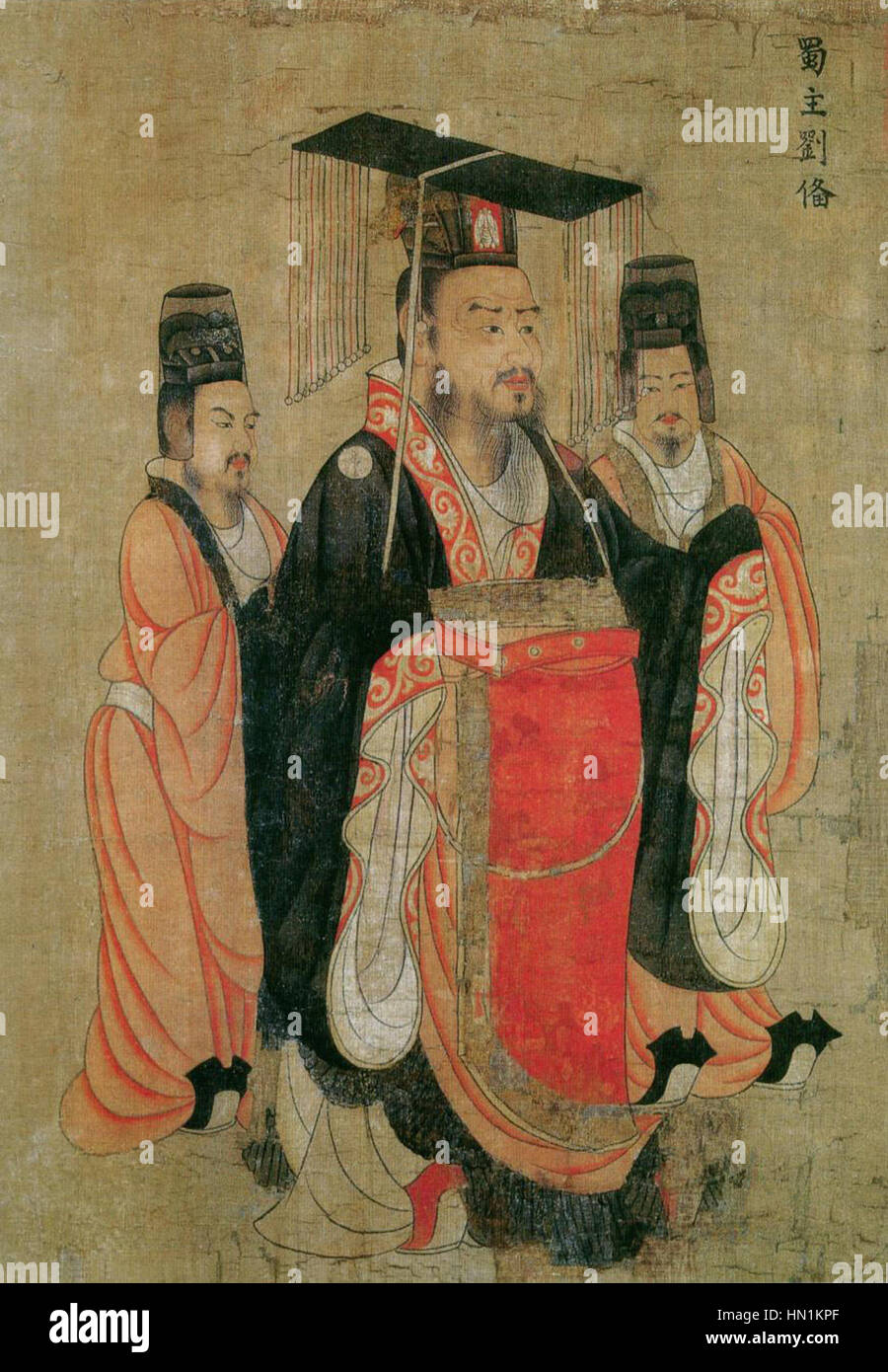 Liu Bei Tang Stock Photohttps://www.alamy.com/image-license-details/?v=1https://www.alamy.com/stock-photo-liu-bei-tang-133417831.html
Liu Bei Tang Stock Photohttps://www.alamy.com/image-license-details/?v=1https://www.alamy.com/stock-photo-liu-bei-tang-133417831.htmlRMHN1KPF–Liu Bei Tang
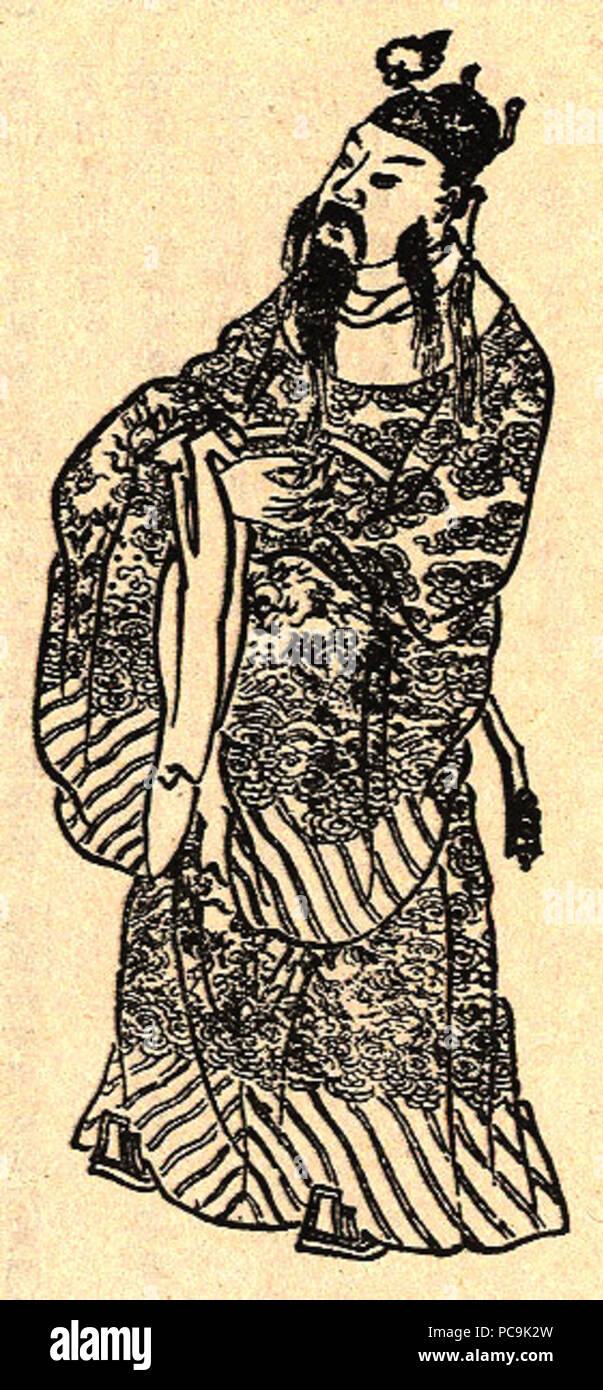 374 Liu Bei Portrait Stock Photohttps://www.alamy.com/image-license-details/?v=1https://www.alamy.com/374-liu-bei-portrait-image214112833.html
374 Liu Bei Portrait Stock Photohttps://www.alamy.com/image-license-details/?v=1https://www.alamy.com/374-liu-bei-portrait-image214112833.htmlRMPC9K2W–374 Liu Bei Portrait
 Romance of the Three Kingdoms, 1800s. Matsumura Goshun was trained in literati art by Yosa Buson and Maruyama Okyo. Here, he depicted "Oath of the Peach Garden," a scene from the classic Chinese historical novel Romance of the Three Kingdoms . The three warriors Liu Bei, Guan Yu, and Zhang Fei became sworn brothers in a ceremony amid peach blossom trees. Matsumura’s painting follows the example of Buson’s Evening Banquet at the Peach and Pear Blossom Garden , inspired by a 16th-century Li Bai poem. Stock Photohttps://www.alamy.com/image-license-details/?v=1https://www.alamy.com/romance-of-the-three-kingdoms-1800s-matsumura-goshun-was-trained-in-literati-art-by-yosa-buson-and-maruyama-okyo-here-he-depicted-quotoath-of-the-peach-gardenquot-a-scene-from-the-classic-chinese-historical-novel-romance-of-the-three-kingdoms-the-three-warriors-liu-bei-guan-yu-and-zhang-fei-became-sworn-brothers-in-a-ceremony-amid-peach-blossom-trees-matsumurax2019s-painting-follows-the-example-of-busonx2019s-evening-banquet-at-the-peach-and-pear-blossom-garden-inspired-by-a-16th-century-li-bai-poem-image330115709.html
Romance of the Three Kingdoms, 1800s. Matsumura Goshun was trained in literati art by Yosa Buson and Maruyama Okyo. Here, he depicted "Oath of the Peach Garden," a scene from the classic Chinese historical novel Romance of the Three Kingdoms . The three warriors Liu Bei, Guan Yu, and Zhang Fei became sworn brothers in a ceremony amid peach blossom trees. Matsumura’s painting follows the example of Buson’s Evening Banquet at the Peach and Pear Blossom Garden , inspired by a 16th-century Li Bai poem. Stock Photohttps://www.alamy.com/image-license-details/?v=1https://www.alamy.com/romance-of-the-three-kingdoms-1800s-matsumura-goshun-was-trained-in-literati-art-by-yosa-buson-and-maruyama-okyo-here-he-depicted-quotoath-of-the-peach-gardenquot-a-scene-from-the-classic-chinese-historical-novel-romance-of-the-three-kingdoms-the-three-warriors-liu-bei-guan-yu-and-zhang-fei-became-sworn-brothers-in-a-ceremony-amid-peach-blossom-trees-matsumurax2019s-painting-follows-the-example-of-busonx2019s-evening-banquet-at-the-peach-and-pear-blossom-garden-inspired-by-a-16th-century-li-bai-poem-image330115709.htmlRM2A521XN–Romance of the Three Kingdoms, 1800s. Matsumura Goshun was trained in literati art by Yosa Buson and Maruyama Okyo. Here, he depicted "Oath of the Peach Garden," a scene from the classic Chinese historical novel Romance of the Three Kingdoms . The three warriors Liu Bei, Guan Yu, and Zhang Fei became sworn brothers in a ceremony amid peach blossom trees. Matsumura’s painting follows the example of Buson’s Evening Banquet at the Peach and Pear Blossom Garden , inspired by a 16th-century Li Bai poem.
 Liu Bei Stone Statue Three Kingdoms Temple, Wuhou Memorial, Chengdu, Sichuan China Stock Photohttps://www.alamy.com/image-license-details/?v=1https://www.alamy.com/stock-photo-liu-bei-stone-statue-three-kingdoms-temple-wuhou-memorial-chengdu-19416931.html
Liu Bei Stone Statue Three Kingdoms Temple, Wuhou Memorial, Chengdu, Sichuan China Stock Photohttps://www.alamy.com/image-license-details/?v=1https://www.alamy.com/stock-photo-liu-bei-stone-statue-three-kingdoms-temple-wuhou-memorial-chengdu-19416931.htmlRFB3GEDR–Liu Bei Stone Statue Three Kingdoms Temple, Wuhou Memorial, Chengdu, Sichuan China
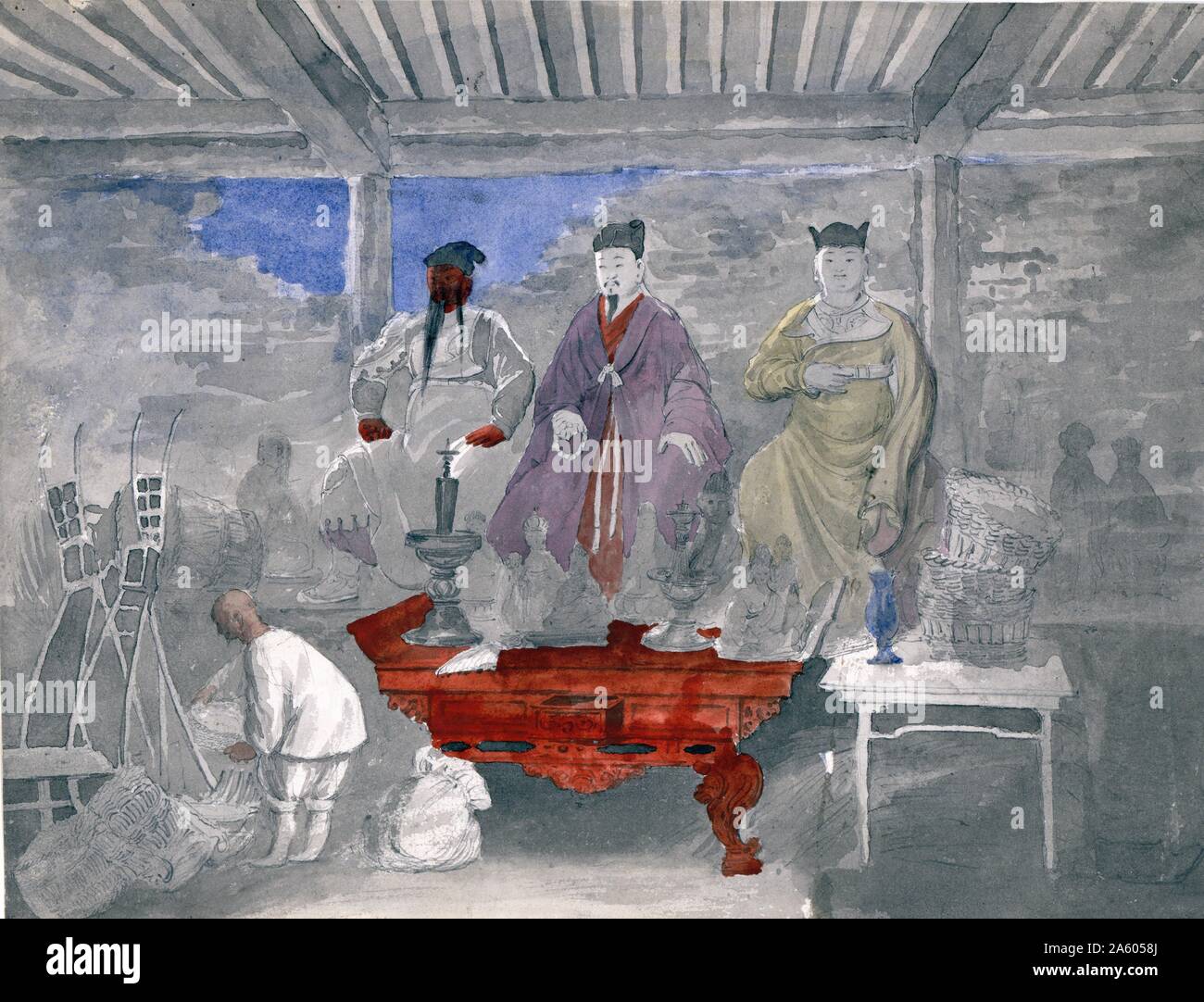 Illustration of a Buddhist temple or shrine, with statues of Guan Yu, Liu Bei, and Zhang Fei. Dated between 1860 and 1900. Stock Photohttps://www.alamy.com/image-license-details/?v=1https://www.alamy.com/illustration-of-a-buddhist-temple-or-shrine-with-statues-of-guan-yu-liu-bei-and-zhang-fei-dated-between-1860-and-1900-image330689090.html
Illustration of a Buddhist temple or shrine, with statues of Guan Yu, Liu Bei, and Zhang Fei. Dated between 1860 and 1900. Stock Photohttps://www.alamy.com/image-license-details/?v=1https://www.alamy.com/illustration-of-a-buddhist-temple-or-shrine-with-statues-of-guan-yu-liu-bei-and-zhang-fei-dated-between-1860-and-1900-image330689090.htmlRM2A6058J–Illustration of a Buddhist temple or shrine, with statues of Guan Yu, Liu Bei, and Zhang Fei. Dated between 1860 and 1900.
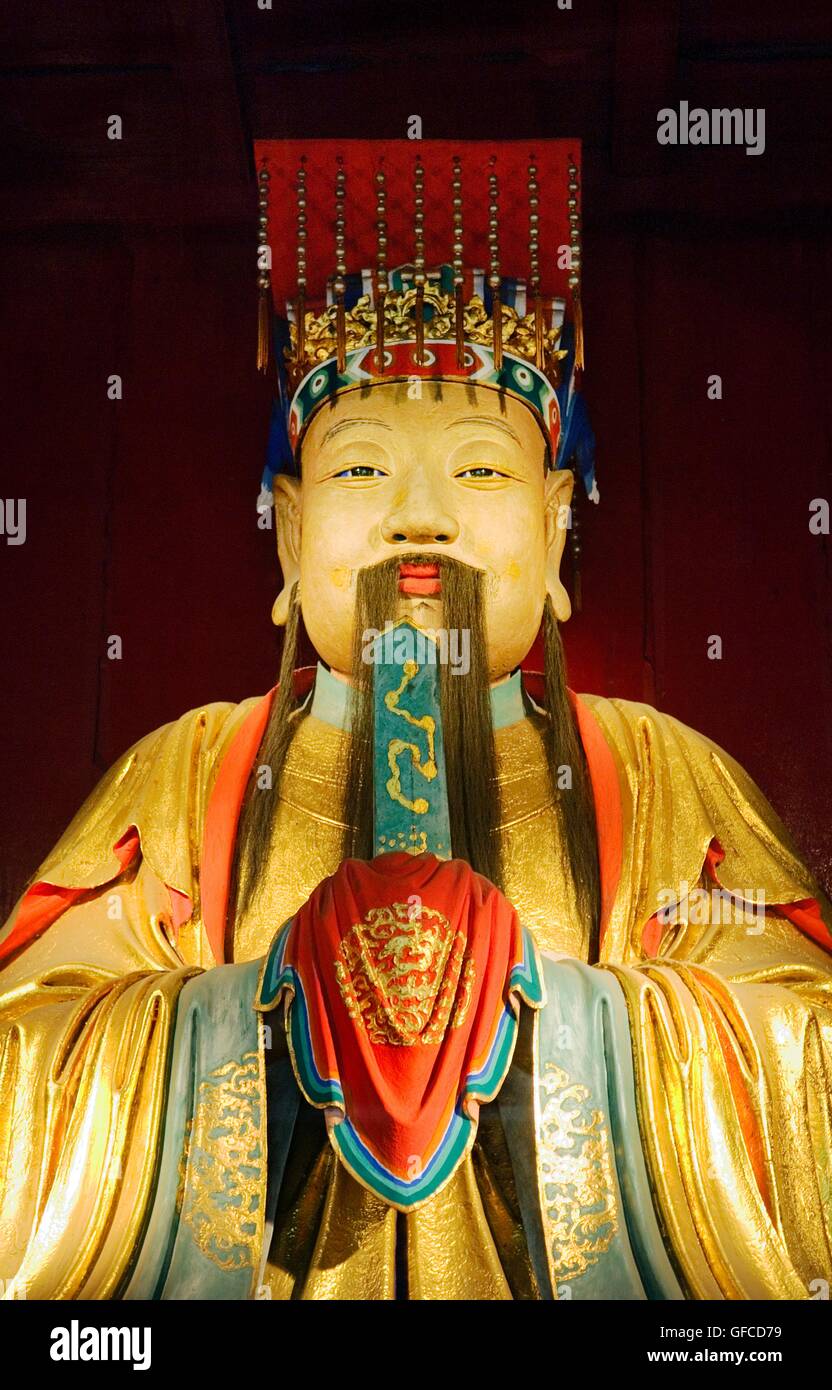 Wu Hou Shrine, Chengdu, Sichuan, China. Statue of Liu Bei army commander and founder of the Shu Kingdom. Statue made in 1672 Stock Photohttps://www.alamy.com/image-license-details/?v=1https://www.alamy.com/stock-photo-wu-hou-shrine-chengdu-sichuan-china-statue-of-liu-bei-army-commander-112755869.html
Wu Hou Shrine, Chengdu, Sichuan, China. Statue of Liu Bei army commander and founder of the Shu Kingdom. Statue made in 1672 Stock Photohttps://www.alamy.com/image-license-details/?v=1https://www.alamy.com/stock-photo-wu-hou-shrine-chengdu-sichuan-china-statue-of-liu-bei-army-commander-112755869.htmlRMGFCD79–Wu Hou Shrine, Chengdu, Sichuan, China. Statue of Liu Bei army commander and founder of the Shu Kingdom. Statue made in 1672
 Wolong Hill, Supposed site in Nanyang, Henan Province, China, where Zhuge Liang was visited by Liu Bei three times before he accepted Liu Bei's offer to be his Prime Minister. Another city makes the same claim Stock Photohttps://www.alamy.com/image-license-details/?v=1https://www.alamy.com/wolong-hill-supposed-site-in-nanyang-henan-province-china-where-zhuge-liang-was-visited-by-liu-bei-three-times-before-he-accepted-liu-beis-offer-to-be-his-prime-minister-another-city-makes-the-same-claim-image573369383.html
Wolong Hill, Supposed site in Nanyang, Henan Province, China, where Zhuge Liang was visited by Liu Bei three times before he accepted Liu Bei's offer to be his Prime Minister. Another city makes the same claim Stock Photohttps://www.alamy.com/image-license-details/?v=1https://www.alamy.com/wolong-hill-supposed-site-in-nanyang-henan-province-china-where-zhuge-liang-was-visited-by-liu-bei-three-times-before-he-accepted-liu-beis-offer-to-be-his-prime-minister-another-city-makes-the-same-claim-image573369383.htmlRM2T8R6DY–Wolong Hill, Supposed site in Nanyang, Henan Province, China, where Zhuge Liang was visited by Liu Bei three times before he accepted Liu Bei's offer to be his Prime Minister. Another city makes the same claim
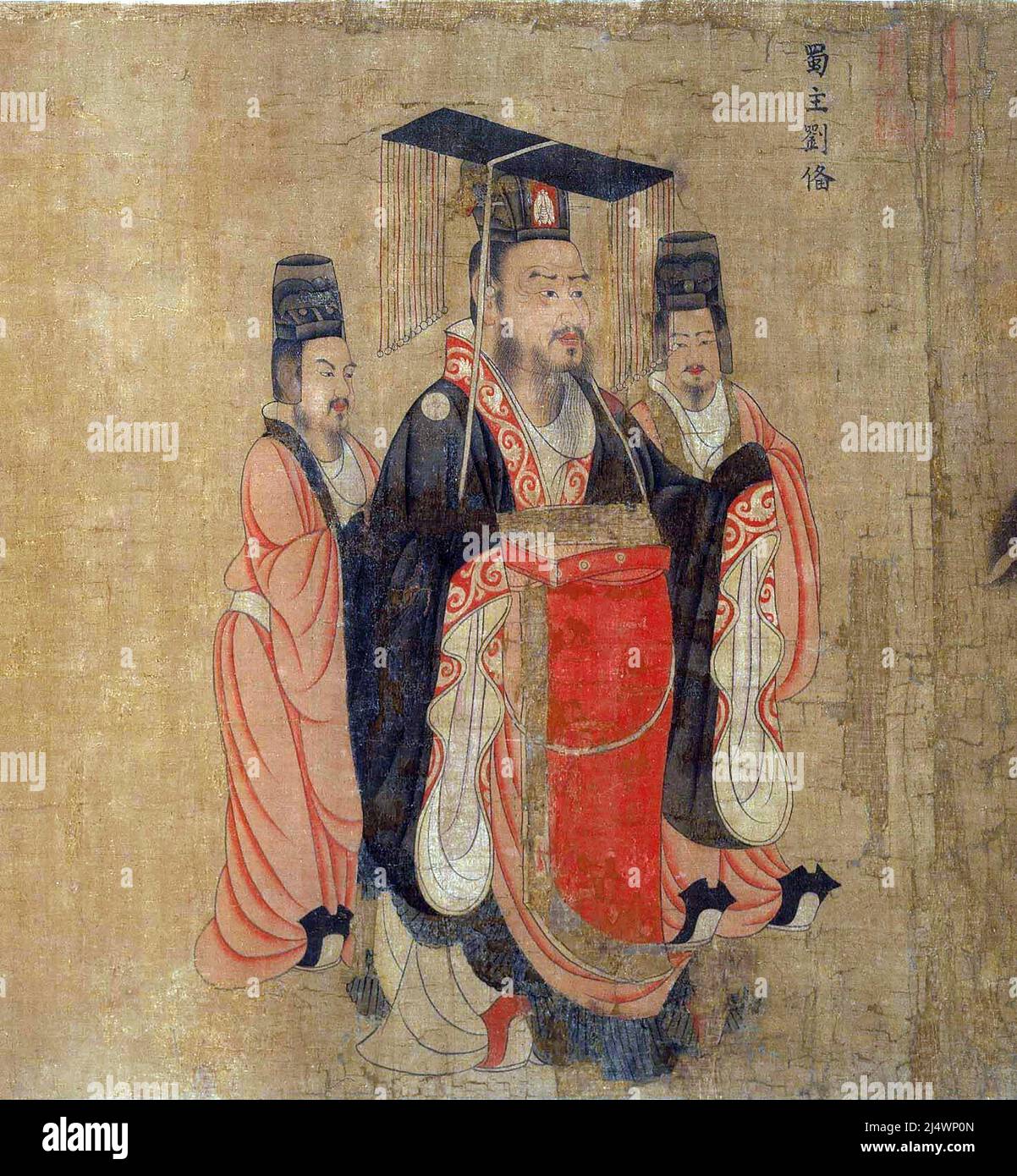 Portrait of Liu Bei (161 – 223), first emperor of Shu Ha Stock Photohttps://www.alamy.com/image-license-details/?v=1https://www.alamy.com/portrait-of-liu-bei-161-223-first-emperor-of-shu-ha-image467704629.html
Portrait of Liu Bei (161 – 223), first emperor of Shu Ha Stock Photohttps://www.alamy.com/image-license-details/?v=1https://www.alamy.com/portrait-of-liu-bei-161-223-first-emperor-of-shu-ha-image467704629.htmlRM2J4WP0N–Portrait of Liu Bei (161 – 223), first emperor of Shu Ha
 Wujiawu shrine Tomb of Liu Bei Xuande Stock Photohttps://www.alamy.com/image-license-details/?v=1https://www.alamy.com/wujiawu-shrine-tomb-of-liu-bei-xuande-image631731211.html
Wujiawu shrine Tomb of Liu Bei Xuande Stock Photohttps://www.alamy.com/image-license-details/?v=1https://www.alamy.com/wujiawu-shrine-tomb-of-liu-bei-xuande-image631731211.htmlRF2YKNRGY–Wujiawu shrine Tomb of Liu Bei Xuande
 Illustration of a Buddhist temple or shrine, with statues of Guan Yu, Liu Bei, and Zhang Fei. Dated between 1860 and 1900. Stock Photohttps://www.alamy.com/image-license-details/?v=1https://www.alamy.com/stock-photo-illustration-of-a-buddhist-temple-or-shrine-with-statues-of-guan-yu-76390745.html
Illustration of a Buddhist temple or shrine, with statues of Guan Yu, Liu Bei, and Zhang Fei. Dated between 1860 and 1900. Stock Photohttps://www.alamy.com/image-license-details/?v=1https://www.alamy.com/stock-photo-illustration-of-a-buddhist-temple-or-shrine-with-statues-of-guan-yu-76390745.htmlRMEC7W4W–Illustration of a Buddhist temple or shrine, with statues of Guan Yu, Liu Bei, and Zhang Fei. Dated between 1860 and 1900.
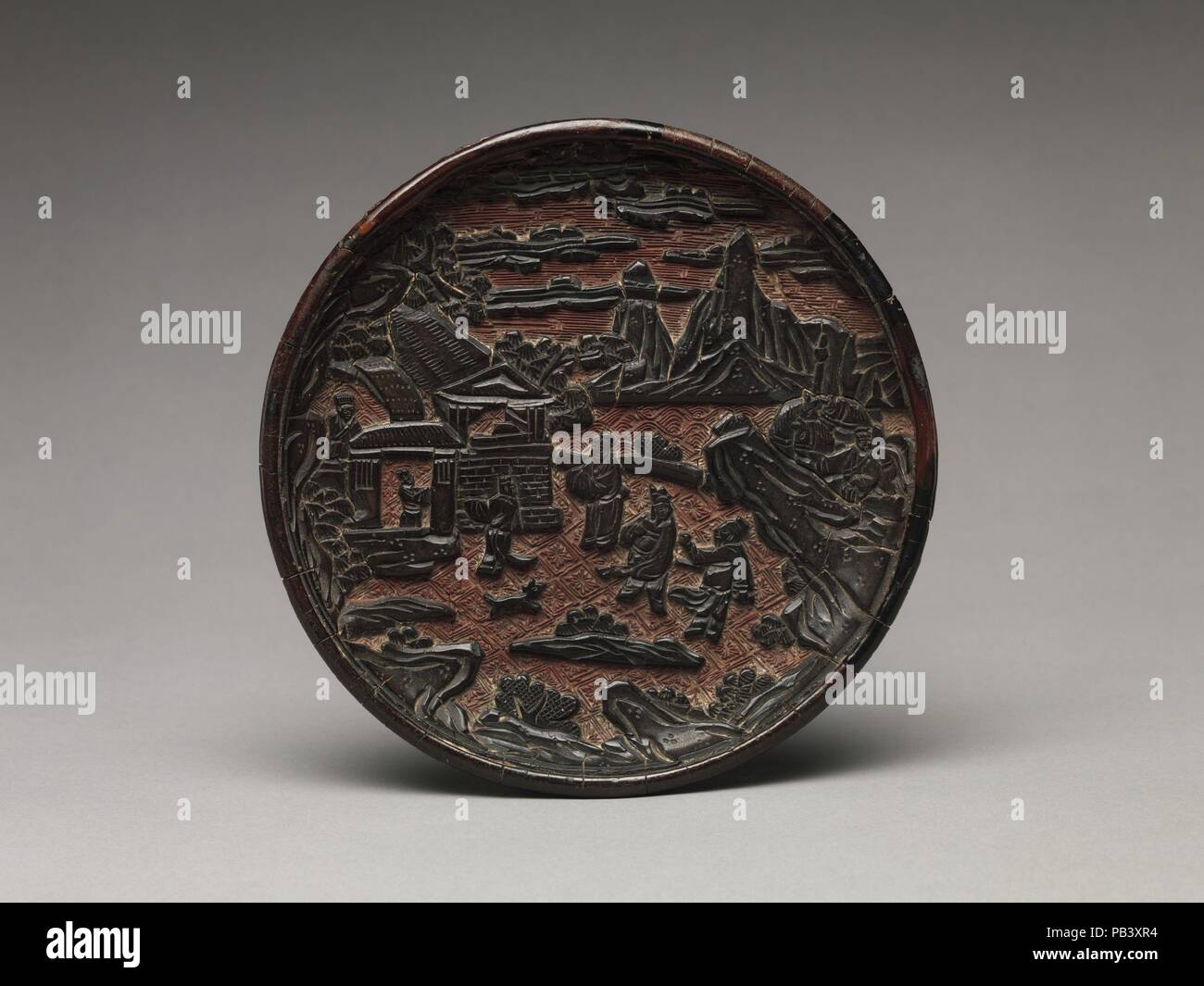 Pair of Dishes with Scenes from the Romance of the Three Kingdoms. Culture: China. Dimensions: Each: Diam. 6 in. (15.2 cm). Date: late 14th century. The narrative scenes on this pair of dishes derive from Chinese history. At the center of one of the dishes, three figures stand before a hut. They are most likely Liu Bei and his two brothers, visiting the learned scholar Zhuge Liang. Liu Bei was the founder of one of the primary polities in China during the Three Kingdoms period (220-65), a tumultuous era that plays a prominent role in Chinese literature. It is likely that the scene was derived Stock Photohttps://www.alamy.com/image-license-details/?v=1https://www.alamy.com/pair-of-dishes-with-scenes-from-the-romance-of-the-three-kingdoms-culture-china-dimensions-each-diam-6-in-152-cm-date-late-14th-century-the-narrative-scenes-on-this-pair-of-dishes-derive-from-chinese-history-at-the-center-of-one-of-the-dishes-three-figures-stand-before-a-hut-they-are-most-likely-liu-bei-and-his-two-brothers-visiting-the-learned-scholar-zhuge-liang-liu-bei-was-the-founder-of-one-of-the-primary-polities-in-china-during-the-three-kingdoms-period-220-65-a-tumultuous-era-that-plays-a-prominent-role-in-chinese-literature-it-is-likely-that-the-scene-was-derived-image213372520.html
Pair of Dishes with Scenes from the Romance of the Three Kingdoms. Culture: China. Dimensions: Each: Diam. 6 in. (15.2 cm). Date: late 14th century. The narrative scenes on this pair of dishes derive from Chinese history. At the center of one of the dishes, three figures stand before a hut. They are most likely Liu Bei and his two brothers, visiting the learned scholar Zhuge Liang. Liu Bei was the founder of one of the primary polities in China during the Three Kingdoms period (220-65), a tumultuous era that plays a prominent role in Chinese literature. It is likely that the scene was derived Stock Photohttps://www.alamy.com/image-license-details/?v=1https://www.alamy.com/pair-of-dishes-with-scenes-from-the-romance-of-the-three-kingdoms-culture-china-dimensions-each-diam-6-in-152-cm-date-late-14th-century-the-narrative-scenes-on-this-pair-of-dishes-derive-from-chinese-history-at-the-center-of-one-of-the-dishes-three-figures-stand-before-a-hut-they-are-most-likely-liu-bei-and-his-two-brothers-visiting-the-learned-scholar-zhuge-liang-liu-bei-was-the-founder-of-one-of-the-primary-polities-in-china-during-the-three-kingdoms-period-220-65-a-tumultuous-era-that-plays-a-prominent-role-in-chinese-literature-it-is-likely-that-the-scene-was-derived-image213372520.htmlRMPB3XR4–Pair of Dishes with Scenes from the Romance of the Three Kingdoms. Culture: China. Dimensions: Each: Diam. 6 in. (15.2 cm). Date: late 14th century. The narrative scenes on this pair of dishes derive from Chinese history. At the center of one of the dishes, three figures stand before a hut. They are most likely Liu Bei and his two brothers, visiting the learned scholar Zhuge Liang. Liu Bei was the founder of one of the primary polities in China during the Three Kingdoms period (220-65), a tumultuous era that plays a prominent role in Chinese literature. It is likely that the scene was derived
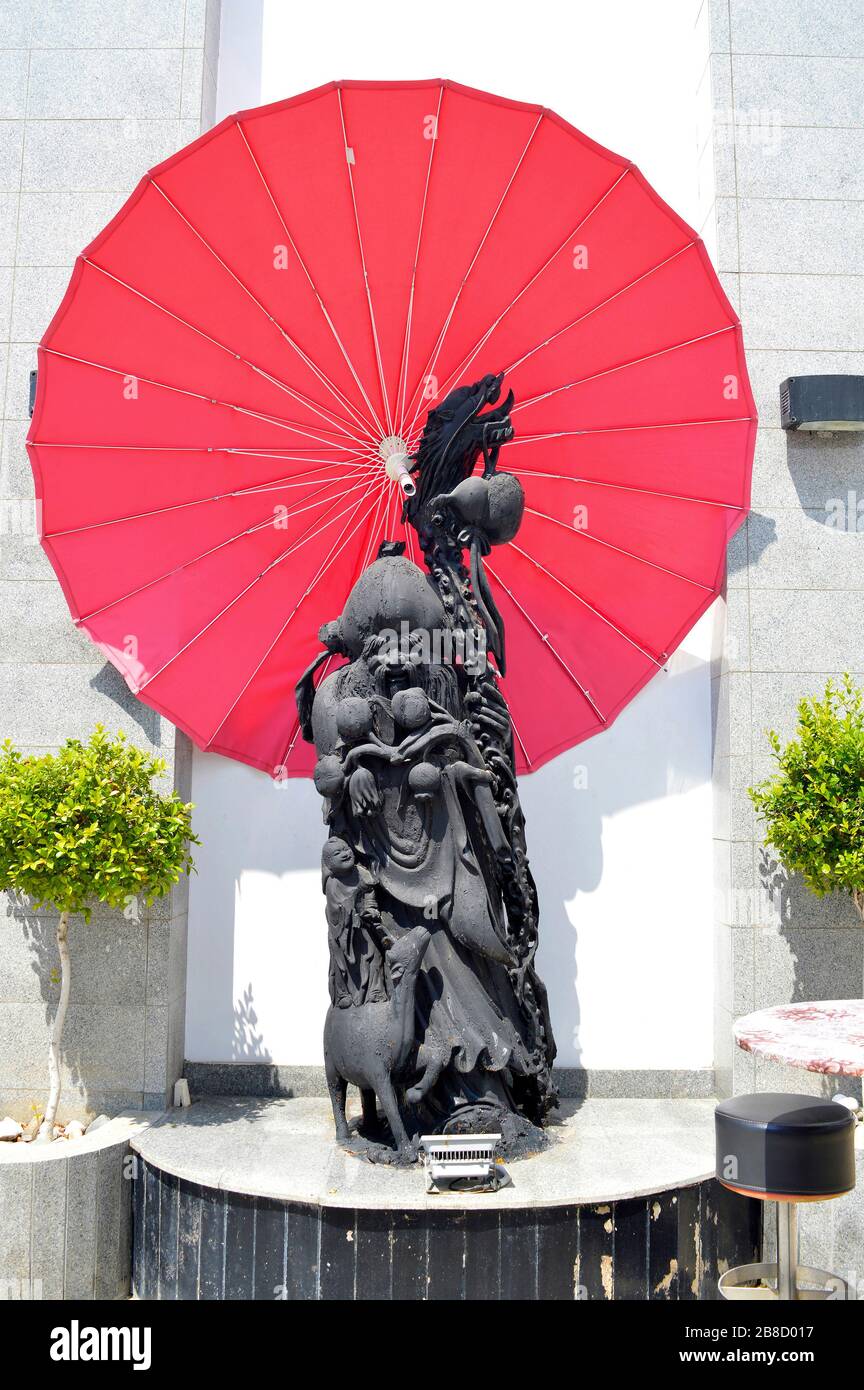 Statue of Guan Yu, a Chinese general serving under the warlord Liu Bei during the late Eastern Han dynasty of Stock Photohttps://www.alamy.com/image-license-details/?v=1https://www.alamy.com/statue-of-guan-yu-a-chinese-general-serving-under-the-warlord-liu-bei-during-the-late-eastern-han-dynasty-of-image349410019.html
Statue of Guan Yu, a Chinese general serving under the warlord Liu Bei during the late Eastern Han dynasty of Stock Photohttps://www.alamy.com/image-license-details/?v=1https://www.alamy.com/statue-of-guan-yu-a-chinese-general-serving-under-the-warlord-liu-bei-during-the-late-eastern-han-dynasty-of-image349410019.htmlRF2B8D017–Statue of Guan Yu, a Chinese general serving under the warlord Liu Bei during the late Eastern Han dynasty of
 Interior of Buddhist temple or shrine with statues of (from left) Guan Yu, Liu Bei, and Zhang Fei Stock Photohttps://www.alamy.com/image-license-details/?v=1https://www.alamy.com/interior-of-buddhist-temple-or-shrine-with-statues-of-from-left-guan-yu-liu-bei-and-zhang-fei-image364600103.html
Interior of Buddhist temple or shrine with statues of (from left) Guan Yu, Liu Bei, and Zhang Fei Stock Photohttps://www.alamy.com/image-license-details/?v=1https://www.alamy.com/interior-of-buddhist-temple-or-shrine-with-statues-of-from-left-guan-yu-liu-bei-and-zhang-fei-image364600103.htmlRM2C54Y47–Interior of Buddhist temple or shrine with statues of (from left) Guan Yu, Liu Bei, and Zhang Fei
 Interior of Buddhist temple or shrine with statues of (from left) Guan Yu, Liu Bei, and Zhang Fei Stock Photohttps://www.alamy.com/image-license-details/?v=1https://www.alamy.com/interior-of-buddhist-temple-or-shrine-with-statues-of-from-left-guan-yu-liu-bei-and-zhang-fei-image269893238.html
Interior of Buddhist temple or shrine with statues of (from left) Guan Yu, Liu Bei, and Zhang Fei Stock Photohttps://www.alamy.com/image-license-details/?v=1https://www.alamy.com/interior-of-buddhist-temple-or-shrine-with-statues-of-from-left-guan-yu-liu-bei-and-zhang-fei-image269893238.htmlRMWK2KG6–Interior of Buddhist temple or shrine with statues of (from left) Guan Yu, Liu Bei, and Zhang Fei
 Linyi, Shandong, China. 18th July, 2014. shows a 'transformer' which is designed to be an image of Guan Yu, a Chinese general serving under the warlord Liu Bei in the late Eastern Han Dynasty (A.D. 25-220), in Linyi, east China's Shandong Province. The transformer, made of a veteran truck, is a works of Biheng, a contemporary young artist of China Central Academy of Fine Arts. It is 9.7 meters high and six meters wide, weighs about 10 metric tons. Credit: Xinhua/Alamy Live News Stock Photohttps://www.alamy.com/image-license-details/?v=1https://www.alamy.com/stock-photo-linyi-shandong-china-18th-july-2014-shows-a-transformer-which-is-designed-71964444.html
Linyi, Shandong, China. 18th July, 2014. shows a 'transformer' which is designed to be an image of Guan Yu, a Chinese general serving under the warlord Liu Bei in the late Eastern Han Dynasty (A.D. 25-220), in Linyi, east China's Shandong Province. The transformer, made of a veteran truck, is a works of Biheng, a contemporary young artist of China Central Academy of Fine Arts. It is 9.7 meters high and six meters wide, weighs about 10 metric tons. Credit: Xinhua/Alamy Live News Stock Photohttps://www.alamy.com/image-license-details/?v=1https://www.alamy.com/stock-photo-linyi-shandong-china-18th-july-2014-shows-a-transformer-which-is-designed-71964444.htmlRME527AM–Linyi, Shandong, China. 18th July, 2014. shows a 'transformer' which is designed to be an image of Guan Yu, a Chinese general serving under the warlord Liu Bei in the late Eastern Han Dynasty (A.D. 25-220), in Linyi, east China's Shandong Province. The transformer, made of a veteran truck, is a works of Biheng, a contemporary young artist of China Central Academy of Fine Arts. It is 9.7 meters high and six meters wide, weighs about 10 metric tons. Credit: Xinhua/Alamy Live News
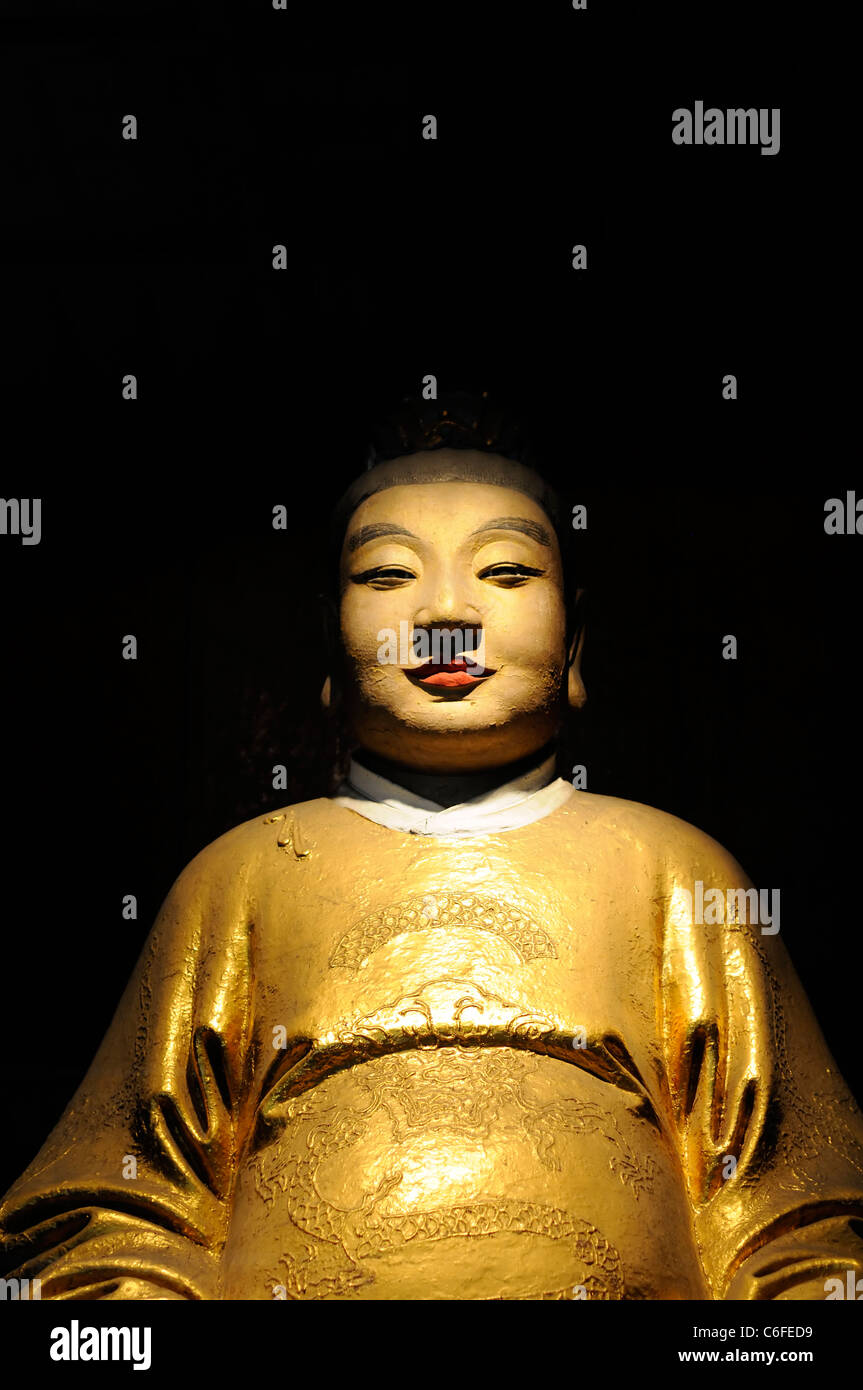 Liu Chen, grandson of Liu Bei, Wuhou Temple (Wuhouci), Chengdu, China Stock Photohttps://www.alamy.com/image-license-details/?v=1https://www.alamy.com/stock-photo-liu-chen-grandson-of-liu-bei-wuhou-temple-wuhouci-chengdu-china-38449301.html
Liu Chen, grandson of Liu Bei, Wuhou Temple (Wuhouci), Chengdu, China Stock Photohttps://www.alamy.com/image-license-details/?v=1https://www.alamy.com/stock-photo-liu-chen-grandson-of-liu-bei-wuhou-temple-wuhouci-chengdu-china-38449301.htmlRMC6FED9–Liu Chen, grandson of Liu Bei, Wuhou Temple (Wuhouci), Chengdu, China
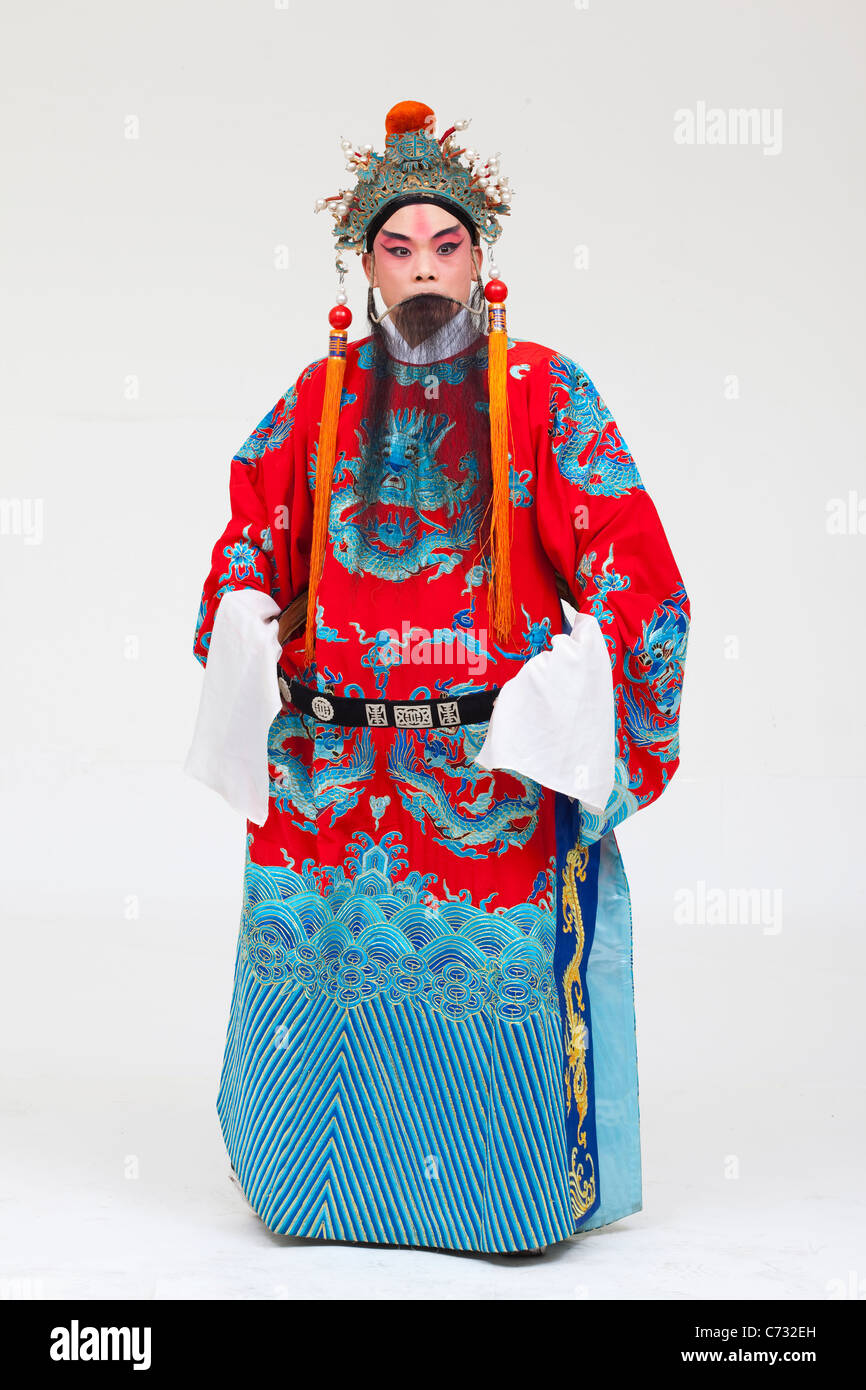 Liu Bei Opera Stock Photohttps://www.alamy.com/image-license-details/?v=1https://www.alamy.com/stock-photo-liu-bei-opera-38791161.html
Liu Bei Opera Stock Photohttps://www.alamy.com/image-license-details/?v=1https://www.alamy.com/stock-photo-liu-bei-opera-38791161.htmlRFC732EH–Liu Bei Opera
 Guan Yu (died 219), style name Yunchang, was a general serving under the warlord Liu Bei in the late Eastern Han Dynasty of China. He played a significant role in the civil war that led to the collapse of the Han Dynasty and the establishment of the state of Shu Han in the Three Kingdoms period, of which Liu Bei was the first emperor. As one of the best known Chinese historical figures throughout East Asia, Guan's true life stories have largely given way to fictionalised ones, most of which are found in the historical novel 'Romance of the Three Kingdoms' or passed down the generations, in wh Stock Photohttps://www.alamy.com/image-license-details/?v=1https://www.alamy.com/guan-yu-died-219-style-name-yunchang-was-a-general-serving-under-the-warlord-liu-bei-in-the-late-eastern-han-dynasty-of-china-he-played-a-significant-role-in-the-civil-war-that-led-to-the-collapse-of-the-han-dynasty-and-the-establishment-of-the-state-of-shu-han-in-the-three-kingdoms-period-of-which-liu-bei-was-the-first-emperor-as-one-of-the-best-known-chinese-historical-figures-throughout-east-asia-guans-true-life-stories-have-largely-given-way-to-fictionalised-ones-most-of-which-are-found-in-the-historical-novel-romance-of-the-three-kingdoms-or-passed-down-the-generations-in-wh-image344255818.html
Guan Yu (died 219), style name Yunchang, was a general serving under the warlord Liu Bei in the late Eastern Han Dynasty of China. He played a significant role in the civil war that led to the collapse of the Han Dynasty and the establishment of the state of Shu Han in the Three Kingdoms period, of which Liu Bei was the first emperor. As one of the best known Chinese historical figures throughout East Asia, Guan's true life stories have largely given way to fictionalised ones, most of which are found in the historical novel 'Romance of the Three Kingdoms' or passed down the generations, in wh Stock Photohttps://www.alamy.com/image-license-details/?v=1https://www.alamy.com/guan-yu-died-219-style-name-yunchang-was-a-general-serving-under-the-warlord-liu-bei-in-the-late-eastern-han-dynasty-of-china-he-played-a-significant-role-in-the-civil-war-that-led-to-the-collapse-of-the-han-dynasty-and-the-establishment-of-the-state-of-shu-han-in-the-three-kingdoms-period-of-which-liu-bei-was-the-first-emperor-as-one-of-the-best-known-chinese-historical-figures-throughout-east-asia-guans-true-life-stories-have-largely-given-way-to-fictionalised-ones-most-of-which-are-found-in-the-historical-novel-romance-of-the-three-kingdoms-or-passed-down-the-generations-in-wh-image344255818.htmlRM2B025PJ–Guan Yu (died 219), style name Yunchang, was a general serving under the warlord Liu Bei in the late Eastern Han Dynasty of China. He played a significant role in the civil war that led to the collapse of the Han Dynasty and the establishment of the state of Shu Han in the Three Kingdoms period, of which Liu Bei was the first emperor. As one of the best known Chinese historical figures throughout East Asia, Guan's true life stories have largely given way to fictionalised ones, most of which are found in the historical novel 'Romance of the Three Kingdoms' or passed down the generations, in wh
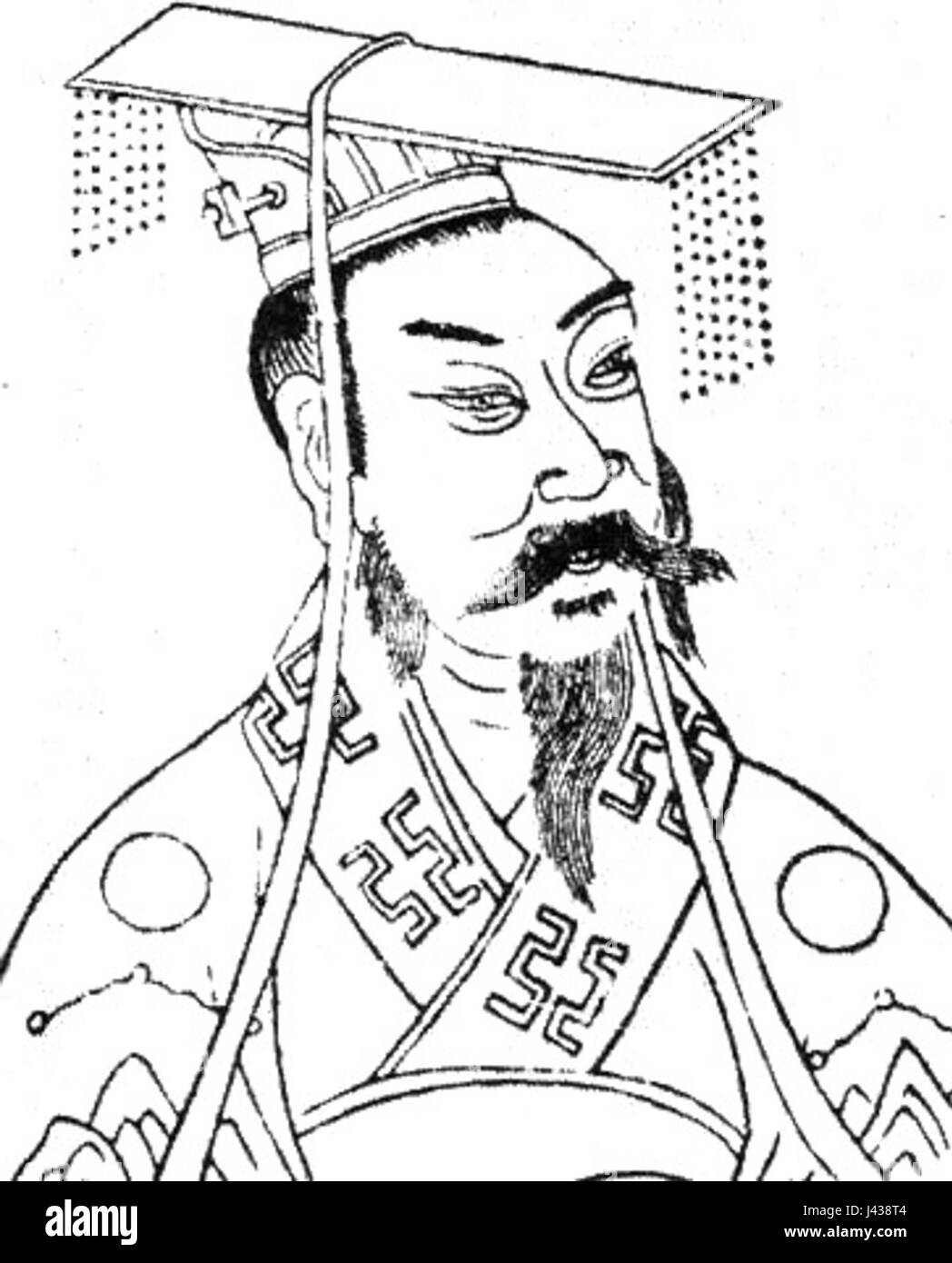 Liu Bei Portrait 2 Stock Photohttps://www.alamy.com/image-license-details/?v=1https://www.alamy.com/stock-photo-liu-bei-portrait-2-140214372.html
Liu Bei Portrait 2 Stock Photohttps://www.alamy.com/image-license-details/?v=1https://www.alamy.com/stock-photo-liu-bei-portrait-2-140214372.htmlRMJ438T4–Liu Bei Portrait 2
 Liu Bei Tang detail Stock Photohttps://www.alamy.com/image-license-details/?v=1https://www.alamy.com/stock-photo-liu-bei-tang-detail-132451809.html
Liu Bei Tang detail Stock Photohttps://www.alamy.com/image-license-details/?v=1https://www.alamy.com/stock-photo-liu-bei-tang-detail-132451809.htmlRMHKDKHN–Liu Bei Tang detail
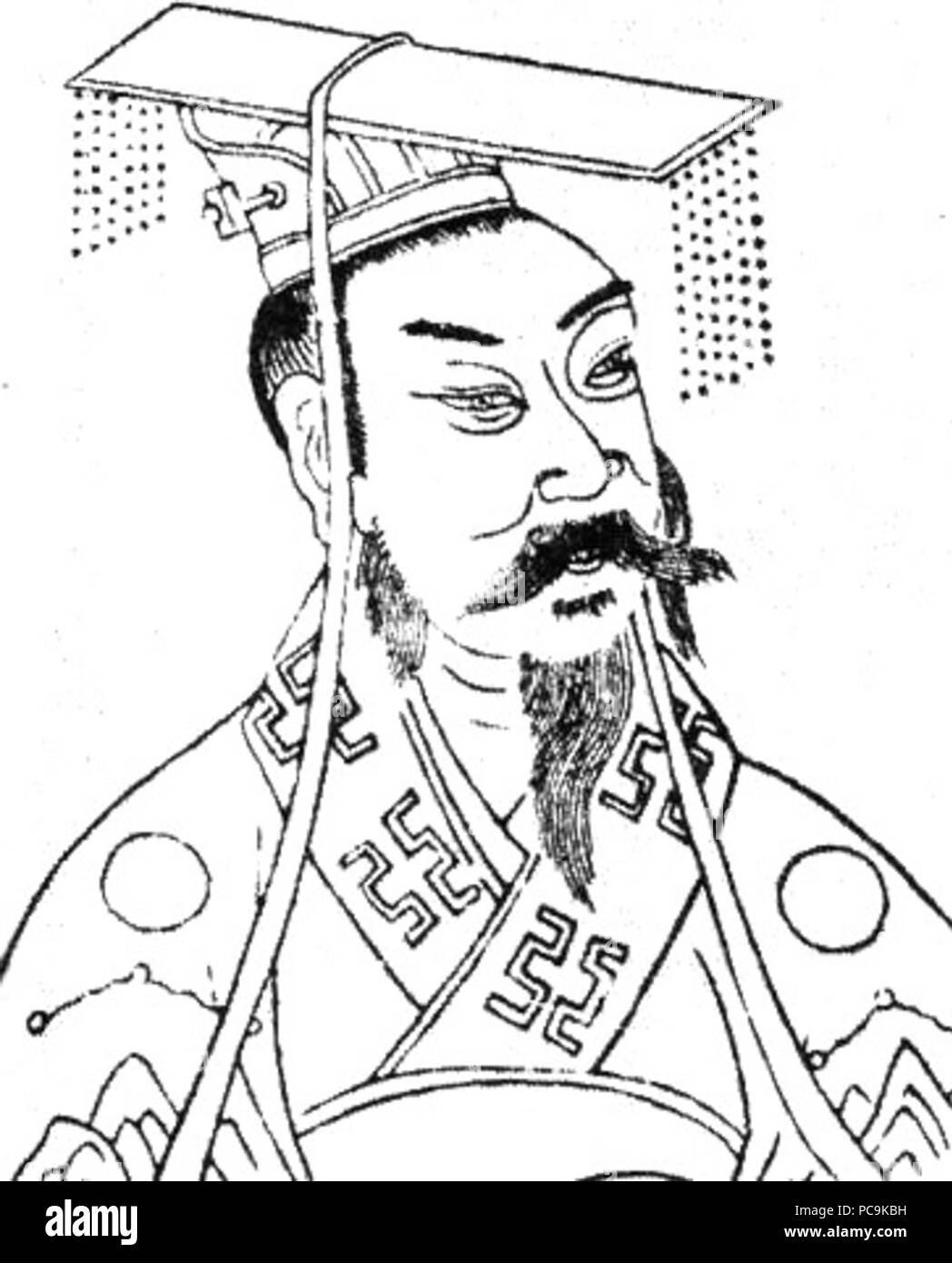 374 Liu Bei Portrait 2 Stock Photohttps://www.alamy.com/image-license-details/?v=1https://www.alamy.com/374-liu-bei-portrait-2-image214113077.html
374 Liu Bei Portrait 2 Stock Photohttps://www.alamy.com/image-license-details/?v=1https://www.alamy.com/374-liu-bei-portrait-2-image214113077.htmlRMPC9KBH–374 Liu Bei Portrait 2
 Guan Yu, Liu Bei, and Zhang Fei, 1825. Stock Photohttps://www.alamy.com/image-license-details/?v=1https://www.alamy.com/guan-yu-liu-bei-and-zhang-fei-1825-image457040561.html
Guan Yu, Liu Bei, and Zhang Fei, 1825. Stock Photohttps://www.alamy.com/image-license-details/?v=1https://www.alamy.com/guan-yu-liu-bei-and-zhang-fei-1825-image457040561.htmlRM2HFFYW5–Guan Yu, Liu Bei, and Zhang Fei, 1825.
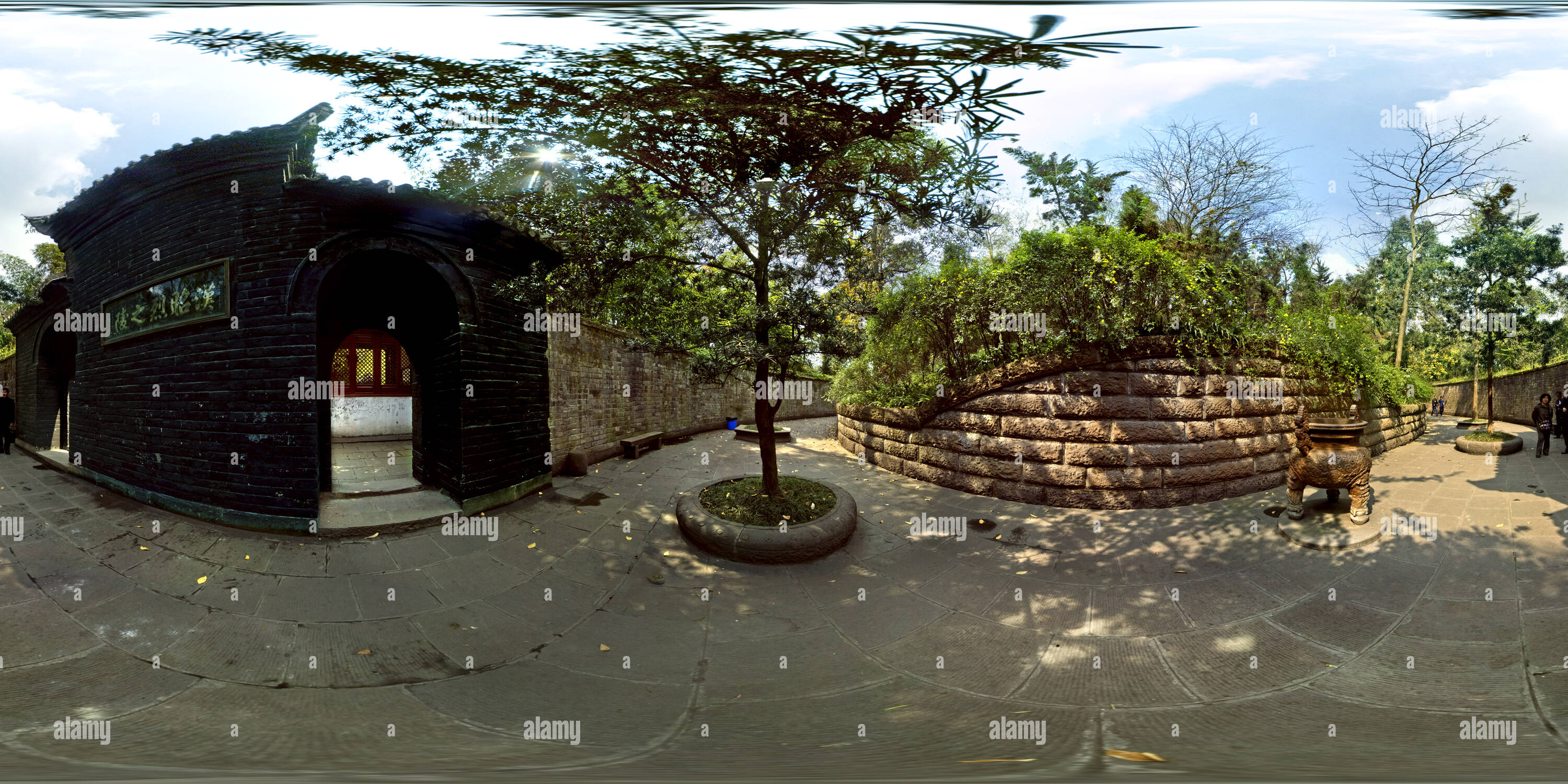 360 degree panoramic view of The tomb of the founder(Liu Bei)of the Shu dynasty wuhouci chengdouhttps://www.alamy.com/image-license-details/?v=1https://www.alamy.com/360-degree-panoramic-view-of-the-tomb-of-the-founderliu-beiof-the-shu-dynasty-wuhouci-chengdou-image219341389.html
360 degree panoramic view of The tomb of the founder(Liu Bei)of the Shu dynasty wuhouci chengdouhttps://www.alamy.com/image-license-details/?v=1https://www.alamy.com/360-degree-panoramic-view-of-the-tomb-of-the-founderliu-beiof-the-shu-dynasty-wuhouci-chengdou-image219341389.htmlRF360°PMRT51–The tomb of the founder(Liu Bei)of the Shu dynasty wuhouci chengdou
 Interior of Buddhist temple or shrine with statues of (from left) Guan Yu, Liu Bei, and Zhang Fei by Gennadii Vasil'evich, 1840-1912 Stock Photohttps://www.alamy.com/image-license-details/?v=1https://www.alamy.com/interior-of-buddhist-temple-or-shrine-with-statues-of-from-left-guan-yu-liu-bei-and-zhang-fei-by-gennadii-vasilevich-1840-1912-image210363142.html
Interior of Buddhist temple or shrine with statues of (from left) Guan Yu, Liu Bei, and Zhang Fei by Gennadii Vasil'evich, 1840-1912 Stock Photohttps://www.alamy.com/image-license-details/?v=1https://www.alamy.com/interior-of-buddhist-temple-or-shrine-with-statues-of-from-left-guan-yu-liu-bei-and-zhang-fei-by-gennadii-vasilevich-1840-1912-image210363142.htmlRMP66T9A–Interior of Buddhist temple or shrine with statues of (from left) Guan Yu, Liu Bei, and Zhang Fei by Gennadii Vasil'evich, 1840-1912
 Wu Hou Shrine, Chengdu, Sichuan Province, China. Set of ornate bronze hanging temple prayer bells chimes gongs Stock Photohttps://www.alamy.com/image-license-details/?v=1https://www.alamy.com/stock-photo-wu-hou-shrine-chengdu-sichuan-province-china-set-of-ornate-bronze-112765981.html
Wu Hou Shrine, Chengdu, Sichuan Province, China. Set of ornate bronze hanging temple prayer bells chimes gongs Stock Photohttps://www.alamy.com/image-license-details/?v=1https://www.alamy.com/stock-photo-wu-hou-shrine-chengdu-sichuan-province-china-set-of-ornate-bronze-112765981.htmlRMGFCX4D–Wu Hou Shrine, Chengdu, Sichuan Province, China. Set of ornate bronze hanging temple prayer bells chimes gongs
 Wolong Hill, Supposed site in Nanyang, Henan Province, China, where Zhuge Liang was visited by Liu Bei three times before he accepted Liu Bei's offer to be his Prime Minister. Another city makes the same claim Stock Photohttps://www.alamy.com/image-license-details/?v=1https://www.alamy.com/wolong-hill-supposed-site-in-nanyang-henan-province-china-where-zhuge-liang-was-visited-by-liu-bei-three-times-before-he-accepted-liu-beis-offer-to-be-his-prime-minister-another-city-makes-the-same-claim-image573369351.html
Wolong Hill, Supposed site in Nanyang, Henan Province, China, where Zhuge Liang was visited by Liu Bei three times before he accepted Liu Bei's offer to be his Prime Minister. Another city makes the same claim Stock Photohttps://www.alamy.com/image-license-details/?v=1https://www.alamy.com/wolong-hill-supposed-site-in-nanyang-henan-province-china-where-zhuge-liang-was-visited-by-liu-bei-three-times-before-he-accepted-liu-beis-offer-to-be-his-prime-minister-another-city-makes-the-same-claim-image573369351.htmlRM2T8R6CR–Wolong Hill, Supposed site in Nanyang, Henan Province, China, where Zhuge Liang was visited by Liu Bei three times before he accepted Liu Bei's offer to be his Prime Minister. Another city makes the same claim
 Scene of Three visits of Liu Bei for Zhuge Liang, from The Romance of Three Kingdoms Location The Summer Palace, Beijing, China Stock Photohttps://www.alamy.com/image-license-details/?v=1https://www.alamy.com/scene-of-three-visits-of-liu-bei-for-zhuge-liang-from-the-romance-of-three-kingdoms-location-the-summer-palace-beijing-china-image365435326.html
Scene of Three visits of Liu Bei for Zhuge Liang, from The Romance of Three Kingdoms Location The Summer Palace, Beijing, China Stock Photohttps://www.alamy.com/image-license-details/?v=1https://www.alamy.com/scene-of-three-visits-of-liu-bei-for-zhuge-liang-from-the-romance-of-three-kingdoms-location-the-summer-palace-beijing-china-image365435326.htmlRM2C6F0DJ–Scene of Three visits of Liu Bei for Zhuge Liang, from The Romance of Three Kingdoms Location The Summer Palace, Beijing, China
 Liu Bei, Lau Pei,dancing,Nian,Spring festival, lion, dance,Chinese New Year, celebrations, Manchester,event,Chinatown,performers Stock Photohttps://www.alamy.com/image-license-details/?v=1https://www.alamy.com/stock-photo-liu-bei-lau-peidancingnianspring-festival-lion-dancechinese-new-year-130401946.html
Liu Bei, Lau Pei,dancing,Nian,Spring festival, lion, dance,Chinese New Year, celebrations, Manchester,event,Chinatown,performers Stock Photohttps://www.alamy.com/image-license-details/?v=1https://www.alamy.com/stock-photo-liu-bei-lau-peidancingnianspring-festival-lion-dancechinese-new-year-130401946.htmlRMHG490A–Liu Bei, Lau Pei,dancing,Nian,Spring festival, lion, dance,Chinese New Year, celebrations, Manchester,event,Chinatown,performers
 Interior of Buddhist temple or shrine with statues of (from left) Guan Yu, Liu Bei, and Zhang Fei by Gennadii Vasil'evich, 1840-1912 Stock Photohttps://www.alamy.com/image-license-details/?v=1https://www.alamy.com/interior-of-buddhist-temple-or-shrine-with-statues-of-from-left-guan-image68557562.html
Interior of Buddhist temple or shrine with statues of (from left) Guan Yu, Liu Bei, and Zhang Fei by Gennadii Vasil'evich, 1840-1912 Stock Photohttps://www.alamy.com/image-license-details/?v=1https://www.alamy.com/interior-of-buddhist-temple-or-shrine-with-statues-of-from-left-guan-image68557562.htmlRMDYF1TA–Interior of Buddhist temple or shrine with statues of (from left) Guan Yu, Liu Bei, and Zhang Fei by Gennadii Vasil'evich, 1840-1912
 No. 1: Liu Bei (Sono ichi: Ryubi), from the series 'Three Heroes of Shu (Shoku sanketsu)'. Yashima Gakutei; Japanese, 1786 (?)-1868. Date: 1819-1829. Dimensions: 22.4 x 19.8 cm. Color woodblock print; shikishiban, surimono. Origin: Japan. Museum: The Chicago Art Institute. Stock Photohttps://www.alamy.com/image-license-details/?v=1https://www.alamy.com/no-1-liu-bei-sono-ichi-ryubi-from-the-series-three-heroes-of-shu-shoku-sanketsu-yashima-gakutei-japanese-1786-1868-date-1819-1829-dimensions-224-x-198-cm-color-woodblock-print-shikishiban-surimono-origin-japan-museum-the-chicago-art-institute-image240133356.html
No. 1: Liu Bei (Sono ichi: Ryubi), from the series 'Three Heroes of Shu (Shoku sanketsu)'. Yashima Gakutei; Japanese, 1786 (?)-1868. Date: 1819-1829. Dimensions: 22.4 x 19.8 cm. Color woodblock print; shikishiban, surimono. Origin: Japan. Museum: The Chicago Art Institute. Stock Photohttps://www.alamy.com/image-license-details/?v=1https://www.alamy.com/no-1-liu-bei-sono-ichi-ryubi-from-the-series-three-heroes-of-shu-shoku-sanketsu-yashima-gakutei-japanese-1786-1868-date-1819-1829-dimensions-224-x-198-cm-color-woodblock-print-shikishiban-surimono-origin-japan-museum-the-chicago-art-institute-image240133356.htmlRMRXK0F8–No. 1: Liu Bei (Sono ichi: Ryubi), from the series 'Three Heroes of Shu (Shoku sanketsu)'. Yashima Gakutei; Japanese, 1786 (?)-1868. Date: 1819-1829. Dimensions: 22.4 x 19.8 cm. Color woodblock print; shikishiban, surimono. Origin: Japan. Museum: The Chicago Art Institute.
 The Chinese general Gentoku (Liu Bei) Netsuge figurine Stock Photohttps://www.alamy.com/image-license-details/?v=1https://www.alamy.com/stock-image-the-chinese-general-gentoku-liu-bei-netsuge-figurine-164097550.html
The Chinese general Gentoku (Liu Bei) Netsuge figurine Stock Photohttps://www.alamy.com/image-license-details/?v=1https://www.alamy.com/stock-image-the-chinese-general-gentoku-liu-bei-netsuge-figurine-164097550.htmlRMKEY82P–The Chinese general Gentoku (Liu Bei) Netsuge figurine
 Liu Bei Tang. Stock Photohttps://www.alamy.com/image-license-details/?v=1https://www.alamy.com/liu-bei-tang-image396449150.html
Liu Bei Tang. Stock Photohttps://www.alamy.com/image-license-details/?v=1https://www.alamy.com/liu-bei-tang-image396449150.htmlRM2E0YPX6–Liu Bei Tang.
 Utagawa Kunisada I (Toyokuni III). Guan Yu, Liu Bei, and Zhang Fei. 1825. Japan. Color woodblock print; shikishiban, surimono Stock Photohttps://www.alamy.com/image-license-details/?v=1https://www.alamy.com/utagawa-kunisada-i-toyokuni-iii-guan-yu-liu-bei-and-zhang-fei-1825-japan-color-woodblock-print-shikishiban-surimono-image337995069.html
Utagawa Kunisada I (Toyokuni III). Guan Yu, Liu Bei, and Zhang Fei. 1825. Japan. Color woodblock print; shikishiban, surimono Stock Photohttps://www.alamy.com/image-license-details/?v=1https://www.alamy.com/utagawa-kunisada-i-toyokuni-iii-guan-yu-liu-bei-and-zhang-fei-1825-japan-color-woodblock-print-shikishiban-surimono-image337995069.htmlRM2AHW04D–Utagawa Kunisada I (Toyokuni III). Guan Yu, Liu Bei, and Zhang Fei. 1825. Japan. Color woodblock print; shikishiban, surimono
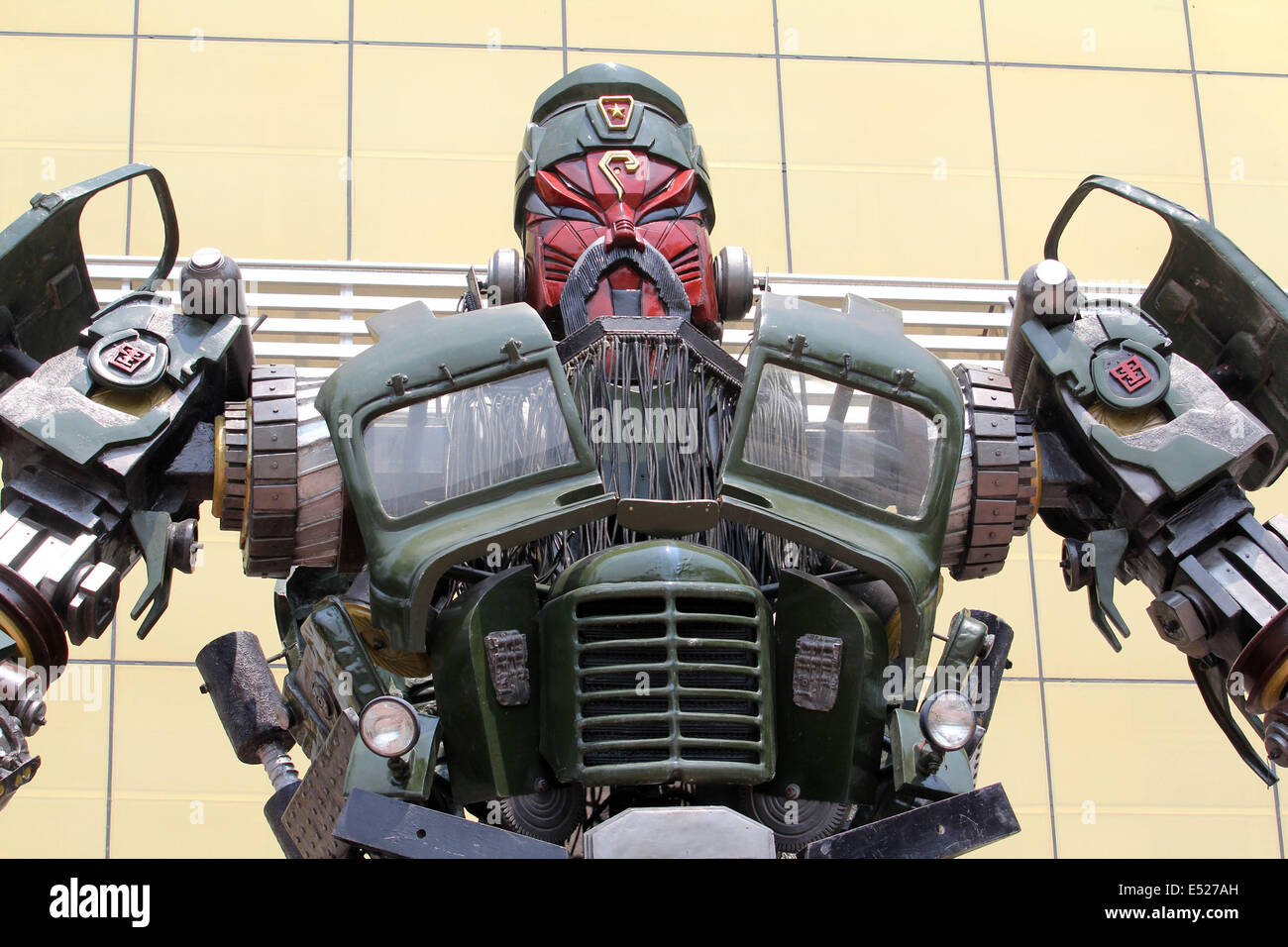 Linyi, Shandong, China. 18th July, 2014. shows a 'transformer' which is designed to be an image of Guan Yu, a Chinese general serving under the warlord Liu Bei in the late Eastern Han Dynasty (A.D. 25-220), in Linyi, east China's Shandong Province. The transformer, made of a veteran truck, is a works of Biheng, a contemporary young artist of China Central Academy of Fine Arts. It is 9.7 meters high and six meters wide, weighs about 10 metric tons. Credit: Xinhua/Alamy Live News Stock Photohttps://www.alamy.com/image-license-details/?v=1https://www.alamy.com/stock-photo-linyi-shandong-china-18th-july-2014-shows-a-transformer-which-is-designed-71964441.html
Linyi, Shandong, China. 18th July, 2014. shows a 'transformer' which is designed to be an image of Guan Yu, a Chinese general serving under the warlord Liu Bei in the late Eastern Han Dynasty (A.D. 25-220), in Linyi, east China's Shandong Province. The transformer, made of a veteran truck, is a works of Biheng, a contemporary young artist of China Central Academy of Fine Arts. It is 9.7 meters high and six meters wide, weighs about 10 metric tons. Credit: Xinhua/Alamy Live News Stock Photohttps://www.alamy.com/image-license-details/?v=1https://www.alamy.com/stock-photo-linyi-shandong-china-18th-july-2014-shows-a-transformer-which-is-designed-71964441.htmlRME527AH–Linyi, Shandong, China. 18th July, 2014. shows a 'transformer' which is designed to be an image of Guan Yu, a Chinese general serving under the warlord Liu Bei in the late Eastern Han Dynasty (A.D. 25-220), in Linyi, east China's Shandong Province. The transformer, made of a veteran truck, is a works of Biheng, a contemporary young artist of China Central Academy of Fine Arts. It is 9.7 meters high and six meters wide, weighs about 10 metric tons. Credit: Xinhua/Alamy Live News
 Old Liu Bei Statue and Iron Pot, Wuhou Memorial Three Kingdoms Temple Chengdu, Sichuan, China Stock Photohttps://www.alamy.com/image-license-details/?v=1https://www.alamy.com/stock-photo-old-liu-bei-statue-and-iron-pot-wuhou-memorial-three-kingdoms-temple-19416978.html
Old Liu Bei Statue and Iron Pot, Wuhou Memorial Three Kingdoms Temple Chengdu, Sichuan, China Stock Photohttps://www.alamy.com/image-license-details/?v=1https://www.alamy.com/stock-photo-old-liu-bei-statue-and-iron-pot-wuhou-memorial-three-kingdoms-temple-19416978.htmlRFB3GEFE–Old Liu Bei Statue and Iron Pot, Wuhou Memorial Three Kingdoms Temple Chengdu, Sichuan, China
 Stone statues of (from left) ancient Chinese warlord Liu Bei, military generals Guan Yu and Zhang Fei are pictured at the City of the Three Kingdoms o Stock Photohttps://www.alamy.com/image-license-details/?v=1https://www.alamy.com/stone-statues-of-from-left-ancient-chinese-warlord-liu-bei-military-generals-guan-yu-and-zhang-fei-are-pictured-at-the-city-of-the-three-kingdoms-o-image261739851.html
Stone statues of (from left) ancient Chinese warlord Liu Bei, military generals Guan Yu and Zhang Fei are pictured at the City of the Three Kingdoms o Stock Photohttps://www.alamy.com/image-license-details/?v=1https://www.alamy.com/stone-statues-of-from-left-ancient-chinese-warlord-liu-bei-military-generals-guan-yu-and-zhang-fei-are-pictured-at-the-city-of-the-three-kingdoms-o-image261739851.htmlRMW5R7RR–Stone statues of (from left) ancient Chinese warlord Liu Bei, military generals Guan Yu and Zhang Fei are pictured at the City of the Three Kingdoms o
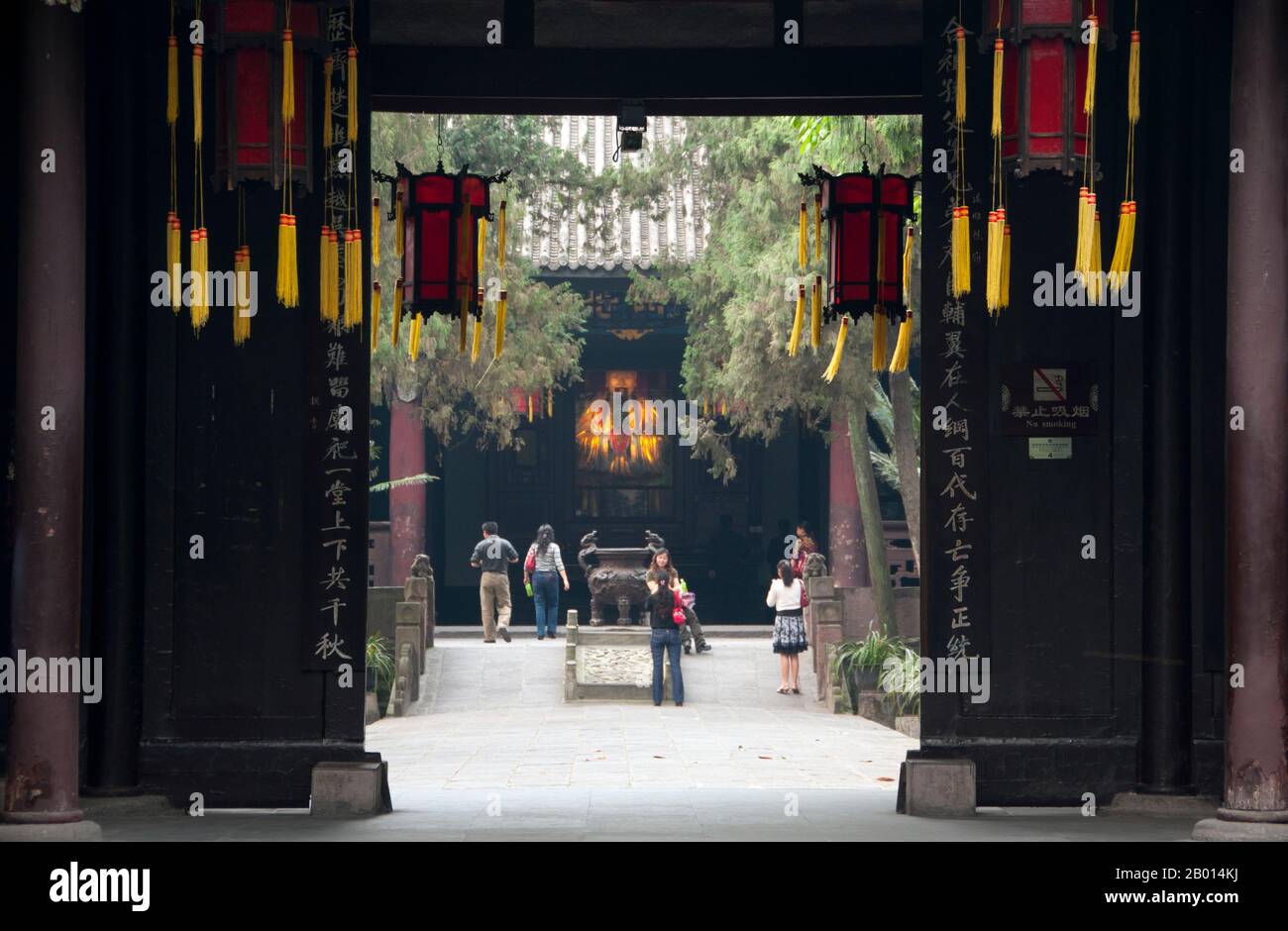 China: Gate leading to Liu Bei Palace, Wuhou Ci (Wuhou Ancestral or Memorial Hall), Chengdu, Sichuan Province. Liu Bei (161 – 21 June 223) was a warlord, military general and later as Emperor Zhaolie the founder of the state of Shu Han during the Three Kingdoms era of Chinese history. Despite having a later start than his rivals and lacking both the material resources and social status they commanded, Liu overcame his many defeats to carve out his own realm, which at its peak spanned modern day Sichuan, Guizhou, Hunan, part of Hubei and part of Gansu. Stock Photohttps://www.alamy.com/image-license-details/?v=1https://www.alamy.com/china-gate-leading-to-liu-bei-palace-wuhou-ci-wuhou-ancestral-or-memorial-hall-chengdu-sichuan-province-liu-bei-161-21-june-223-was-a-warlord-military-general-and-later-as-emperor-zhaolie-the-founder-of-the-state-of-shu-han-during-the-three-kingdoms-era-of-chinese-history-despite-having-a-later-start-than-his-rivals-and-lacking-both-the-material-resources-and-social-status-they-commanded-liu-overcame-his-many-defeats-to-carve-out-his-own-realm-which-at-its-peak-spanned-modern-day-sichuan-guizhou-hunan-part-of-hubei-and-part-of-gansu-image344232998.html
China: Gate leading to Liu Bei Palace, Wuhou Ci (Wuhou Ancestral or Memorial Hall), Chengdu, Sichuan Province. Liu Bei (161 – 21 June 223) was a warlord, military general and later as Emperor Zhaolie the founder of the state of Shu Han during the Three Kingdoms era of Chinese history. Despite having a later start than his rivals and lacking both the material resources and social status they commanded, Liu overcame his many defeats to carve out his own realm, which at its peak spanned modern day Sichuan, Guizhou, Hunan, part of Hubei and part of Gansu. Stock Photohttps://www.alamy.com/image-license-details/?v=1https://www.alamy.com/china-gate-leading-to-liu-bei-palace-wuhou-ci-wuhou-ancestral-or-memorial-hall-chengdu-sichuan-province-liu-bei-161-21-june-223-was-a-warlord-military-general-and-later-as-emperor-zhaolie-the-founder-of-the-state-of-shu-han-during-the-three-kingdoms-era-of-chinese-history-despite-having-a-later-start-than-his-rivals-and-lacking-both-the-material-resources-and-social-status-they-commanded-liu-overcame-his-many-defeats-to-carve-out-his-own-realm-which-at-its-peak-spanned-modern-day-sichuan-guizhou-hunan-part-of-hubei-and-part-of-gansu-image344232998.htmlRM2B014KJ–China: Gate leading to Liu Bei Palace, Wuhou Ci (Wuhou Ancestral or Memorial Hall), Chengdu, Sichuan Province. Liu Bei (161 – 21 June 223) was a warlord, military general and later as Emperor Zhaolie the founder of the state of Shu Han during the Three Kingdoms era of Chinese history. Despite having a later start than his rivals and lacking both the material resources and social status they commanded, Liu overcame his many defeats to carve out his own realm, which at its peak spanned modern day Sichuan, Guizhou, Hunan, part of Hubei and part of Gansu.
 Mask of Liu Bei Stock Photohttps://www.alamy.com/image-license-details/?v=1https://www.alamy.com/stock-photo-mask-of-liu-bei-140155435.html
Mask of Liu Bei Stock Photohttps://www.alamy.com/image-license-details/?v=1https://www.alamy.com/stock-photo-mask-of-liu-bei-140155435.htmlRMJ40HK7–Mask of Liu Bei
 Liu Bei Tang detail Stock Photohttps://www.alamy.com/image-license-details/?v=1https://www.alamy.com/stock-photo-liu-bei-tang-detail-136660837.html
Liu Bei Tang detail Stock Photohttps://www.alamy.com/image-license-details/?v=1https://www.alamy.com/stock-photo-liu-bei-tang-detail-136660837.htmlRMHX9C85–Liu Bei Tang detail
 . Thirteen Emperors Scroll (detail) . 7th century 374 Liu Bei Tang-detail Stock Photohttps://www.alamy.com/image-license-details/?v=1https://www.alamy.com/thirteen-emperors-scroll-detail-7th-century-374-liu-bei-tang-detail-image187535246.html
. Thirteen Emperors Scroll (detail) . 7th century 374 Liu Bei Tang-detail Stock Photohttps://www.alamy.com/image-license-details/?v=1https://www.alamy.com/thirteen-emperors-scroll-detail-7th-century-374-liu-bei-tang-detail-image187535246.htmlRMMW2Y3A–. Thirteen Emperors Scroll (detail) . 7th century 374 Liu Bei Tang-detail
 No. 1: Liu Bei (Sono ichi: Ryubi), from the series "Three Heroes of Shu (Shoku sanketsu)", c. 1824. Stock Photohttps://www.alamy.com/image-license-details/?v=1https://www.alamy.com/no-1-liu-bei-sono-ichi-ryubi-from-the-series-quotthree-heroes-of-shu-shoku-sanketsuquot-c-1824-image457041369.html
No. 1: Liu Bei (Sono ichi: Ryubi), from the series "Three Heroes of Shu (Shoku sanketsu)", c. 1824. Stock Photohttps://www.alamy.com/image-license-details/?v=1https://www.alamy.com/no-1-liu-bei-sono-ichi-ryubi-from-the-series-quotthree-heroes-of-shu-shoku-sanketsuquot-c-1824-image457041369.htmlRM2HFG0X1–No. 1: Liu Bei (Sono ichi: Ryubi), from the series "Three Heroes of Shu (Shoku sanketsu)", c. 1824.
 360 degree panoramic view of the Stone carving front the tomb of Liu Bei wuhouci chengdouhttps://www.alamy.com/image-license-details/?v=1https://www.alamy.com/360-degree-panoramic-view-of-the-stone-carving-front-the-tomb-of-liu-bei-wuhouci-chengdou-image219340712.html
360 degree panoramic view of the Stone carving front the tomb of Liu Bei wuhouci chengdouhttps://www.alamy.com/image-license-details/?v=1https://www.alamy.com/360-degree-panoramic-view-of-the-stone-carving-front-the-tomb-of-liu-bei-wuhouci-chengdou-image219340712.htmlRF360°PMRR8T–the Stone carving front the tomb of Liu Bei wuhouci chengdou
 Lucy Liu bei der Premiere des Kinofilms 'Red One' im UCI Luxe. Berlin, 03.11.2024 Stock Photohttps://www.alamy.com/image-license-details/?v=1https://www.alamy.com/lucy-liu-bei-der-premiere-des-kinofilms-red-one-im-uci-luxe-berlin-03112024-image629002752.html
Lucy Liu bei der Premiere des Kinofilms 'Red One' im UCI Luxe. Berlin, 03.11.2024 Stock Photohttps://www.alamy.com/image-license-details/?v=1https://www.alamy.com/lucy-liu-bei-der-premiere-des-kinofilms-red-one-im-uci-luxe-berlin-03112024-image629002752.htmlRM2YF9FC0–Lucy Liu bei der Premiere des Kinofilms 'Red One' im UCI Luxe. Berlin, 03.11.2024
 Liu Bei (Ry? Bi), from the series The Three Heroes of Shu, No. 1 (Shoku Sanketsu sono ichi). Artist: Yashima Gakutei, Japanese, ca. 1786–1868 Subject: Liu Bei, Chinese, 161–223 Stock Photohttps://www.alamy.com/image-license-details/?v=1https://www.alamy.com/liu-bei-ry-bi-from-the-series-the-three-heroes-of-shu-no-1-shoku-sanketsu-sonoichi-artist-yashima-gakutei-japanese-ca-17861868-subject-liu-bei-chinese-161223-image463291980.html
Liu Bei (Ry? Bi), from the series The Three Heroes of Shu, No. 1 (Shoku Sanketsu sono ichi). Artist: Yashima Gakutei, Japanese, ca. 1786–1868 Subject: Liu Bei, Chinese, 161–223 Stock Photohttps://www.alamy.com/image-license-details/?v=1https://www.alamy.com/liu-bei-ry-bi-from-the-series-the-three-heroes-of-shu-no-1-shoku-sanketsu-sonoichi-artist-yashima-gakutei-japanese-ca-17861868-subject-liu-bei-chinese-161223-image463291980.htmlRM2HWMNJ4–Liu Bei (Ry? Bi), from the series The Three Heroes of Shu, No. 1 (Shoku Sanketsu sono ichi). Artist: Yashima Gakutei, Japanese, ca. 1786–1868 Subject: Liu Bei, Chinese, 161–223
 Wolong Hill, Supposed site in Nanyang, Henan Province, China, where Zhuge Liang was visited by Liu Bei three times before he accepted Liu Bei's offer to be his Prime Minister. Another city makes the same claim Stock Photohttps://www.alamy.com/image-license-details/?v=1https://www.alamy.com/wolong-hill-supposed-site-in-nanyang-henan-province-china-where-zhuge-liang-was-visited-by-liu-bei-three-times-before-he-accepted-liu-beis-offer-to-be-his-prime-minister-another-city-makes-the-same-claim-image573369412.html
Wolong Hill, Supposed site in Nanyang, Henan Province, China, where Zhuge Liang was visited by Liu Bei three times before he accepted Liu Bei's offer to be his Prime Minister. Another city makes the same claim Stock Photohttps://www.alamy.com/image-license-details/?v=1https://www.alamy.com/wolong-hill-supposed-site-in-nanyang-henan-province-china-where-zhuge-liang-was-visited-by-liu-bei-three-times-before-he-accepted-liu-beis-offer-to-be-his-prime-minister-another-city-makes-the-same-claim-image573369412.htmlRM2T8R6F0–Wolong Hill, Supposed site in Nanyang, Henan Province, China, where Zhuge Liang was visited by Liu Bei three times before he accepted Liu Bei's offer to be his Prime Minister. Another city makes the same claim
 Lucy Liu bei der Premiere des Kinofilms Red One im UCI Luxe. Berlin, 03.11.2024 *** Lucy Liu at the premiere of the movie Red One at UCI Luxe Berlin, 03 11 2024 Foto:xD.xHerrickx/xFuturexImagex red 4174 Stock Photohttps://www.alamy.com/image-license-details/?v=1https://www.alamy.com/lucy-liu-bei-der-premiere-des-kinofilms-red-one-im-uci-luxe-berlin-03112024-lucy-liu-at-the-premiere-of-the-movie-red-one-at-uci-luxe-berlin-03-11-2024-fotoxdxherrickxxfutureximagex-red-4174-image628997961.html
Lucy Liu bei der Premiere des Kinofilms Red One im UCI Luxe. Berlin, 03.11.2024 *** Lucy Liu at the premiere of the movie Red One at UCI Luxe Berlin, 03 11 2024 Foto:xD.xHerrickx/xFuturexImagex red 4174 Stock Photohttps://www.alamy.com/image-license-details/?v=1https://www.alamy.com/lucy-liu-bei-der-premiere-des-kinofilms-red-one-im-uci-luxe-berlin-03112024-lucy-liu-at-the-premiere-of-the-movie-red-one-at-uci-luxe-berlin-03-11-2024-fotoxdxherrickxxfutureximagex-red-4174-image628997961.htmlRM2YF998W–Lucy Liu bei der Premiere des Kinofilms Red One im UCI Luxe. Berlin, 03.11.2024 *** Lucy Liu at the premiere of the movie Red One at UCI Luxe Berlin, 03 11 2024 Foto:xD.xHerrickx/xFuturexImagex red 4174
 Liu Bei,Lau Pei,dancing,Nian,Spring festival,diabolo,Chinese New Year, celebrations, Manchester,event,Chinatown,performers,girls Stock Photohttps://www.alamy.com/image-license-details/?v=1https://www.alamy.com/stock-photo-liu-beilau-peidancingnianspring-festivaldiabolochinese-new-year-celebrations-130401940.html
Liu Bei,Lau Pei,dancing,Nian,Spring festival,diabolo,Chinese New Year, celebrations, Manchester,event,Chinatown,performers,girls Stock Photohttps://www.alamy.com/image-license-details/?v=1https://www.alamy.com/stock-photo-liu-beilau-peidancingnianspring-festivaldiabolochinese-new-year-celebrations-130401940.htmlRMHG4904–Liu Bei,Lau Pei,dancing,Nian,Spring festival,diabolo,Chinese New Year, celebrations, Manchester,event,Chinatown,performers,girls
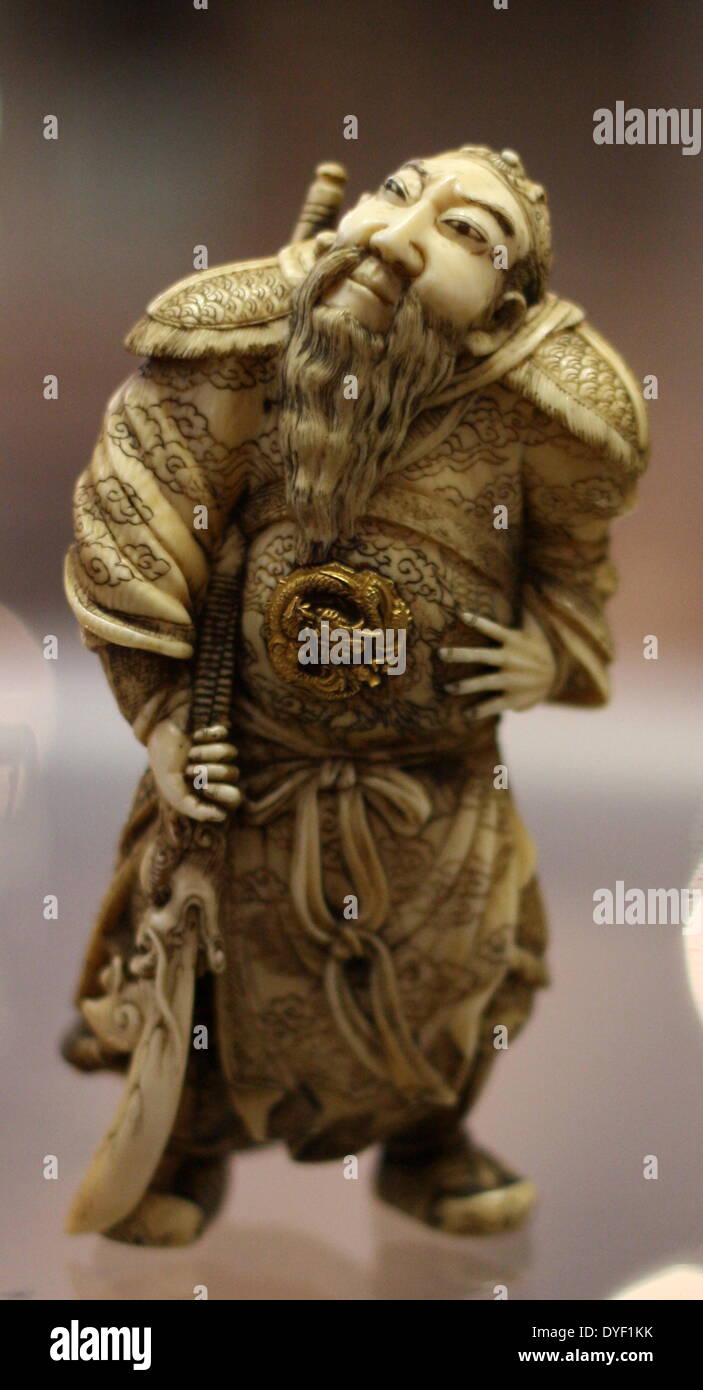 Japanese okimono representing legendary Chinese general Kanyu. Made from Ivory. Kanyu lived between 160-219 AD and was a general during the Three Kingdoms period in Chinese history. Stories of Kanyu (AKA Gaun Yu) are told in the 14th century novel 'Romance of the Three Kingdoms'. Was instrumental in helping Liu Bei to become the first emperor of the Kingdom of Shu. The artefact is highly detailed, and shows the artist had a great degree of skill. Stock Photohttps://www.alamy.com/image-license-details/?v=1https://www.alamy.com/japanese-okimono-representing-legendary-chinese-general-kanyu-made-image68557431.html
Japanese okimono representing legendary Chinese general Kanyu. Made from Ivory. Kanyu lived between 160-219 AD and was a general during the Three Kingdoms period in Chinese history. Stories of Kanyu (AKA Gaun Yu) are told in the 14th century novel 'Romance of the Three Kingdoms'. Was instrumental in helping Liu Bei to become the first emperor of the Kingdom of Shu. The artefact is highly detailed, and shows the artist had a great degree of skill. Stock Photohttps://www.alamy.com/image-license-details/?v=1https://www.alamy.com/japanese-okimono-representing-legendary-chinese-general-kanyu-made-image68557431.htmlRMDYF1KK–Japanese okimono representing legendary Chinese general Kanyu. Made from Ivory. Kanyu lived between 160-219 AD and was a general during the Three Kingdoms period in Chinese history. Stories of Kanyu (AKA Gaun Yu) are told in the 14th century novel 'Romance of the Three Kingdoms'. Was instrumental in helping Liu Bei to become the first emperor of the Kingdom of Shu. The artefact is highly detailed, and shows the artist had a great degree of skill.
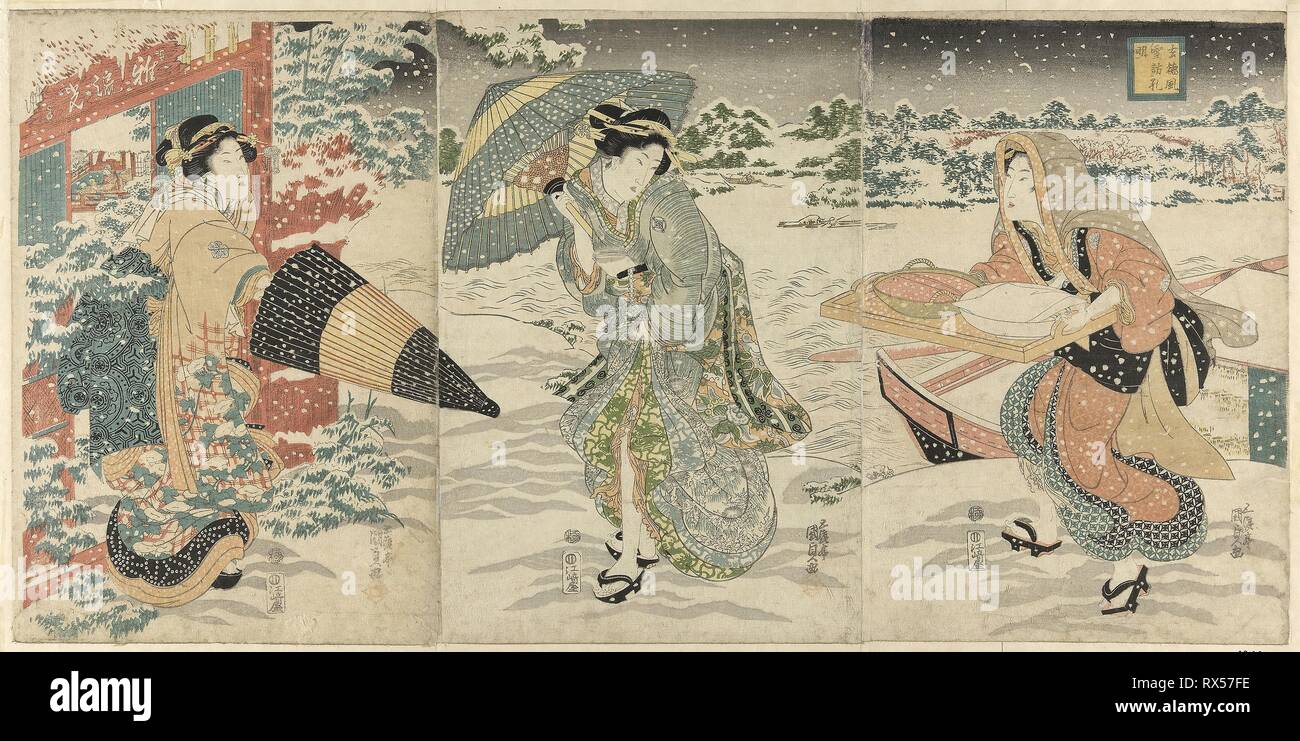 Parody of Liu Bei (J: Gentoku) Visiting Zhuge Liang (J: Komei) in Wind and Snow (Gentoku fusetsu ni Komei o tazureru). Utagawa Kunisada I (Toyokuni III); Japanese, 1786-1864. Date: 1839-1849. Dimensions: 38.4 x 78.1 cm (15 1/8 x 30 3/4 in.). Color woodblock print; oban triptych. Origin: Japan. Museum: The Chicago Art Institute. Stock Photohttps://www.alamy.com/image-license-details/?v=1https://www.alamy.com/parody-of-liu-bei-j-gentoku-visiting-zhuge-liang-j-komei-in-wind-and-snow-gentoku-fusetsu-ni-komei-o-tazureru-utagawa-kunisada-i-toyokuni-iii-japanese-1786-1864-date-1839-1849-dimensions-384-x-781-cm-15-18-x-30-34-in-color-woodblock-print-oban-triptych-origin-japan-museum-the-chicago-art-institute-image239831522.html
Parody of Liu Bei (J: Gentoku) Visiting Zhuge Liang (J: Komei) in Wind and Snow (Gentoku fusetsu ni Komei o tazureru). Utagawa Kunisada I (Toyokuni III); Japanese, 1786-1864. Date: 1839-1849. Dimensions: 38.4 x 78.1 cm (15 1/8 x 30 3/4 in.). Color woodblock print; oban triptych. Origin: Japan. Museum: The Chicago Art Institute. Stock Photohttps://www.alamy.com/image-license-details/?v=1https://www.alamy.com/parody-of-liu-bei-j-gentoku-visiting-zhuge-liang-j-komei-in-wind-and-snow-gentoku-fusetsu-ni-komei-o-tazureru-utagawa-kunisada-i-toyokuni-iii-japanese-1786-1864-date-1839-1849-dimensions-384-x-781-cm-15-18-x-30-34-in-color-woodblock-print-oban-triptych-origin-japan-museum-the-chicago-art-institute-image239831522.htmlRMRX57FE–Parody of Liu Bei (J: Gentoku) Visiting Zhuge Liang (J: Komei) in Wind and Snow (Gentoku fusetsu ni Komei o tazureru). Utagawa Kunisada I (Toyokuni III); Japanese, 1786-1864. Date: 1839-1849. Dimensions: 38.4 x 78.1 cm (15 1/8 x 30 3/4 in.). Color woodblock print; oban triptych. Origin: Japan. Museum: The Chicago Art Institute.
 Wushi. Chinese New Year Celebration. Liu Bei Lion performs acrobatics to scare away demons in Chinatown. Stock Photohttps://www.alamy.com/image-license-details/?v=1https://www.alamy.com/stock-photo-wushi-chinese-new-year-celebration-liu-bei-lion-performs-acrobatics-22245998.html
Wushi. Chinese New Year Celebration. Liu Bei Lion performs acrobatics to scare away demons in Chinatown. Stock Photohttps://www.alamy.com/image-license-details/?v=1https://www.alamy.com/stock-photo-wushi-chinese-new-year-celebration-liu-bei-lion-performs-acrobatics-22245998.htmlRMB85AYX–Wushi. Chinese New Year Celebration. Liu Bei Lion performs acrobatics to scare away demons in Chinatown.
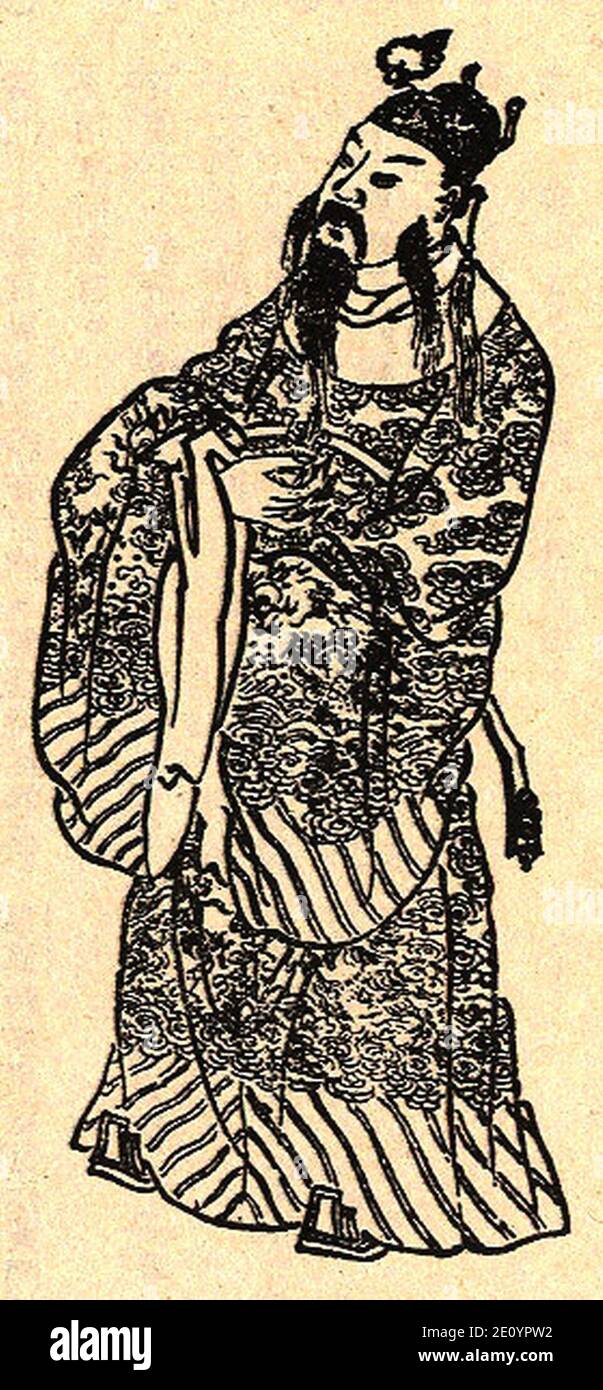 Liu Bei Portrait. Stock Photohttps://www.alamy.com/image-license-details/?v=1https://www.alamy.com/liu-bei-portrait-image396449118.html
Liu Bei Portrait. Stock Photohttps://www.alamy.com/image-license-details/?v=1https://www.alamy.com/liu-bei-portrait-image396449118.htmlRM2E0YPW2–Liu Bei Portrait.
 Yashima Gakutei. No. 1 Liu Bei (Sono ichi Ryubi), from the series Three Heroes of Shu (Shoku sanketsu). 1819–1829. Japan. Color woodblock print; shikishiban, surimono Stock Photohttps://www.alamy.com/image-license-details/?v=1https://www.alamy.com/yashima-gakutei-no-1-liu-bei-sono-ichi-ryubi-from-the-series-three-heroes-of-shu-shoku-sanketsu-18191829-japan-color-woodblock-print-shikishiban-surimono-image337994609.html
Yashima Gakutei. No. 1 Liu Bei (Sono ichi Ryubi), from the series Three Heroes of Shu (Shoku sanketsu). 1819–1829. Japan. Color woodblock print; shikishiban, surimono Stock Photohttps://www.alamy.com/image-license-details/?v=1https://www.alamy.com/yashima-gakutei-no-1-liu-bei-sono-ichi-ryubi-from-the-series-three-heroes-of-shu-shoku-sanketsu-18191829-japan-color-woodblock-print-shikishiban-surimono-image337994609.htmlRM2AHTYG1–Yashima Gakutei. No. 1 Liu Bei (Sono ichi Ryubi), from the series Three Heroes of Shu (Shoku sanketsu). 1819–1829. Japan. Color woodblock print; shikishiban, surimono
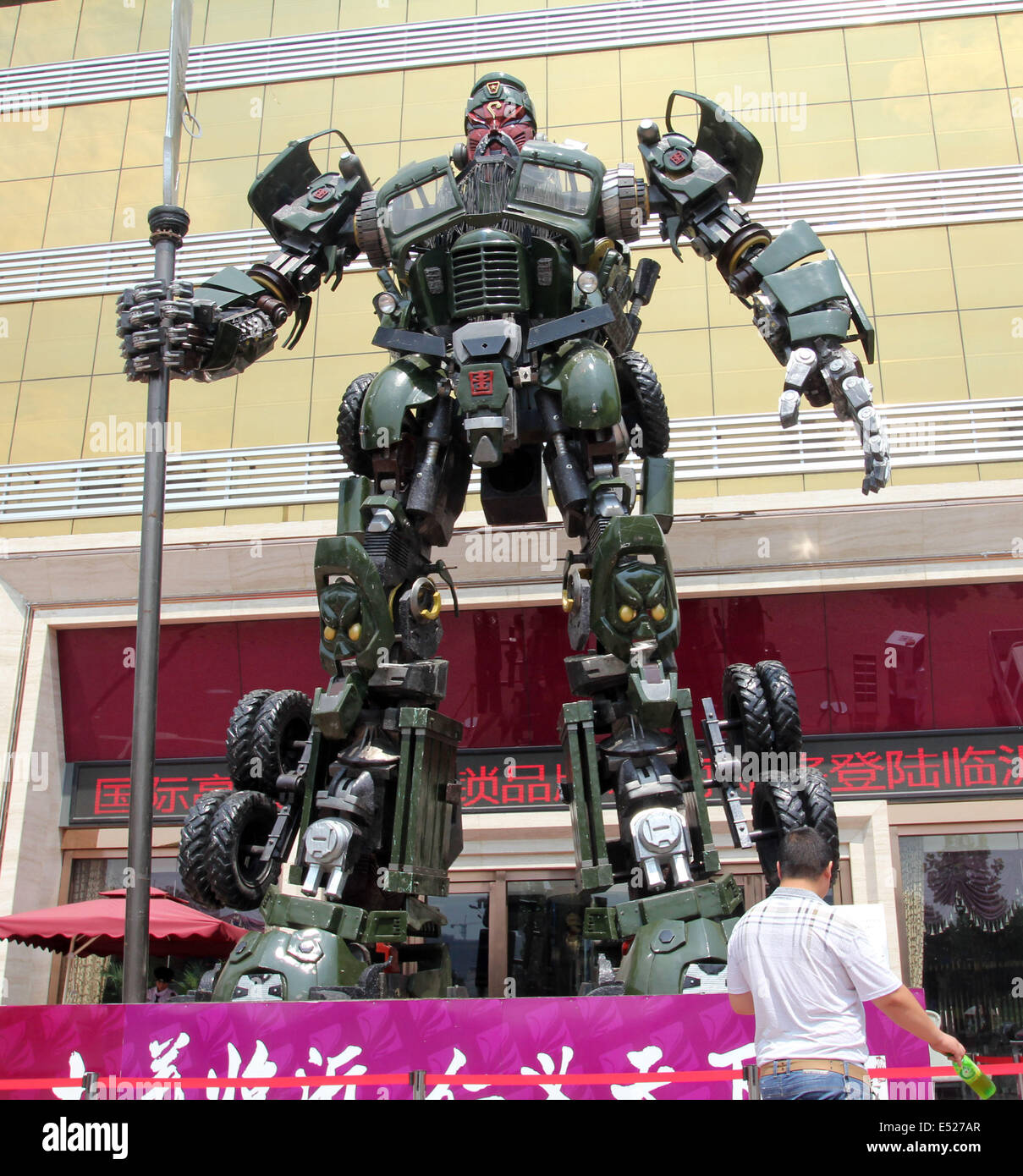 Linyi, Shandong, China. 18th July, 2014. shows a 'transformer' which is designed to be an image of Guan Yu, a Chinese general serving under the warlord Liu Bei in the late Eastern Han Dynasty (A.D. 25-220), in Linyi, east China's Shandong Province. The transformer, made of a veteran truck, is a works of Biheng, a contemporary young artist of China Central Academy of Fine Arts. It is 9.7 meters high and six meters wide, weighs about 10 metric tons. Credit: Xinhua/Alamy Live News Stock Photohttps://www.alamy.com/image-license-details/?v=1https://www.alamy.com/stock-photo-linyi-shandong-china-18th-july-2014-shows-a-transformer-which-is-designed-71964447.html
Linyi, Shandong, China. 18th July, 2014. shows a 'transformer' which is designed to be an image of Guan Yu, a Chinese general serving under the warlord Liu Bei in the late Eastern Han Dynasty (A.D. 25-220), in Linyi, east China's Shandong Province. The transformer, made of a veteran truck, is a works of Biheng, a contemporary young artist of China Central Academy of Fine Arts. It is 9.7 meters high and six meters wide, weighs about 10 metric tons. Credit: Xinhua/Alamy Live News Stock Photohttps://www.alamy.com/image-license-details/?v=1https://www.alamy.com/stock-photo-linyi-shandong-china-18th-july-2014-shows-a-transformer-which-is-designed-71964447.htmlRME527AR–Linyi, Shandong, China. 18th July, 2014. shows a 'transformer' which is designed to be an image of Guan Yu, a Chinese general serving under the warlord Liu Bei in the late Eastern Han Dynasty (A.D. 25-220), in Linyi, east China's Shandong Province. The transformer, made of a veteran truck, is a works of Biheng, a contemporary young artist of China Central Academy of Fine Arts. It is 9.7 meters high and six meters wide, weighs about 10 metric tons. Credit: Xinhua/Alamy Live News
 Beijing, Beijing, China. 10th Aug, 2018. Beijing, CHINA-A giant 'transformer' with the head of Guan Yu can be seen on street in Beijing, China.Guan Yu was a general serving under the warlord Liu Bei in the late Eastern Han dynasty. He played a significant role in the events that led to the end of the dynasty and the establishment of the state of Shu Han in the Three Kingdoms period. Credit: SIPA Asia/ZUMA Wire/Alamy Live News Stock Photohttps://www.alamy.com/image-license-details/?v=1https://www.alamy.com/beijing-beijing-china-10th-aug-2018-beijing-china-a-giant-transformer-with-the-head-of-guan-yu-can-be-seen-on-street-in-beijing-chinaguan-yu-was-a-general-serving-under-the-warlord-liu-bei-in-the-late-eastern-han-dynasty-he-played-a-significant-role-in-the-events-that-led-to-the-end-of-the-dynasty-and-the-establishment-of-the-state-of-shu-han-in-the-three-kingdoms-period-credit-sipa-asiazuma-wirealamy-live-news-image214899168.html
Beijing, Beijing, China. 10th Aug, 2018. Beijing, CHINA-A giant 'transformer' with the head of Guan Yu can be seen on street in Beijing, China.Guan Yu was a general serving under the warlord Liu Bei in the late Eastern Han dynasty. He played a significant role in the events that led to the end of the dynasty and the establishment of the state of Shu Han in the Three Kingdoms period. Credit: SIPA Asia/ZUMA Wire/Alamy Live News Stock Photohttps://www.alamy.com/image-license-details/?v=1https://www.alamy.com/beijing-beijing-china-10th-aug-2018-beijing-china-a-giant-transformer-with-the-head-of-guan-yu-can-be-seen-on-street-in-beijing-chinaguan-yu-was-a-general-serving-under-the-warlord-liu-bei-in-the-late-eastern-han-dynasty-he-played-a-significant-role-in-the-events-that-led-to-the-end-of-the-dynasty-and-the-establishment-of-the-state-of-shu-han-in-the-three-kingdoms-period-credit-sipa-asiazuma-wirealamy-live-news-image214899168.htmlRMPDHE28–Beijing, Beijing, China. 10th Aug, 2018. Beijing, CHINA-A giant 'transformer' with the head of Guan Yu can be seen on street in Beijing, China.Guan Yu was a general serving under the warlord Liu Bei in the late Eastern Han dynasty. He played a significant role in the events that led to the end of the dynasty and the establishment of the state of Shu Han in the Three Kingdoms period. Credit: SIPA Asia/ZUMA Wire/Alamy Live News
 Ornate Iron Pot Liu Bei Statue, Wuhou Memorial, Three Kingdoms, Temple, Chengdu, Sichuan, China Stock Photohttps://www.alamy.com/image-license-details/?v=1https://www.alamy.com/stock-image-ornate-iron-pot-liu-bei-statue-wuhou-memorial-three-kingdoms-temple-168780750.html
Ornate Iron Pot Liu Bei Statue, Wuhou Memorial, Three Kingdoms, Temple, Chengdu, Sichuan, China Stock Photohttps://www.alamy.com/image-license-details/?v=1https://www.alamy.com/stock-image-ornate-iron-pot-liu-bei-statue-wuhou-memorial-three-kingdoms-temple-168780750.htmlRFKPGHFX–Ornate Iron Pot Liu Bei Statue, Wuhou Memorial, Three Kingdoms, Temple, Chengdu, Sichuan, China
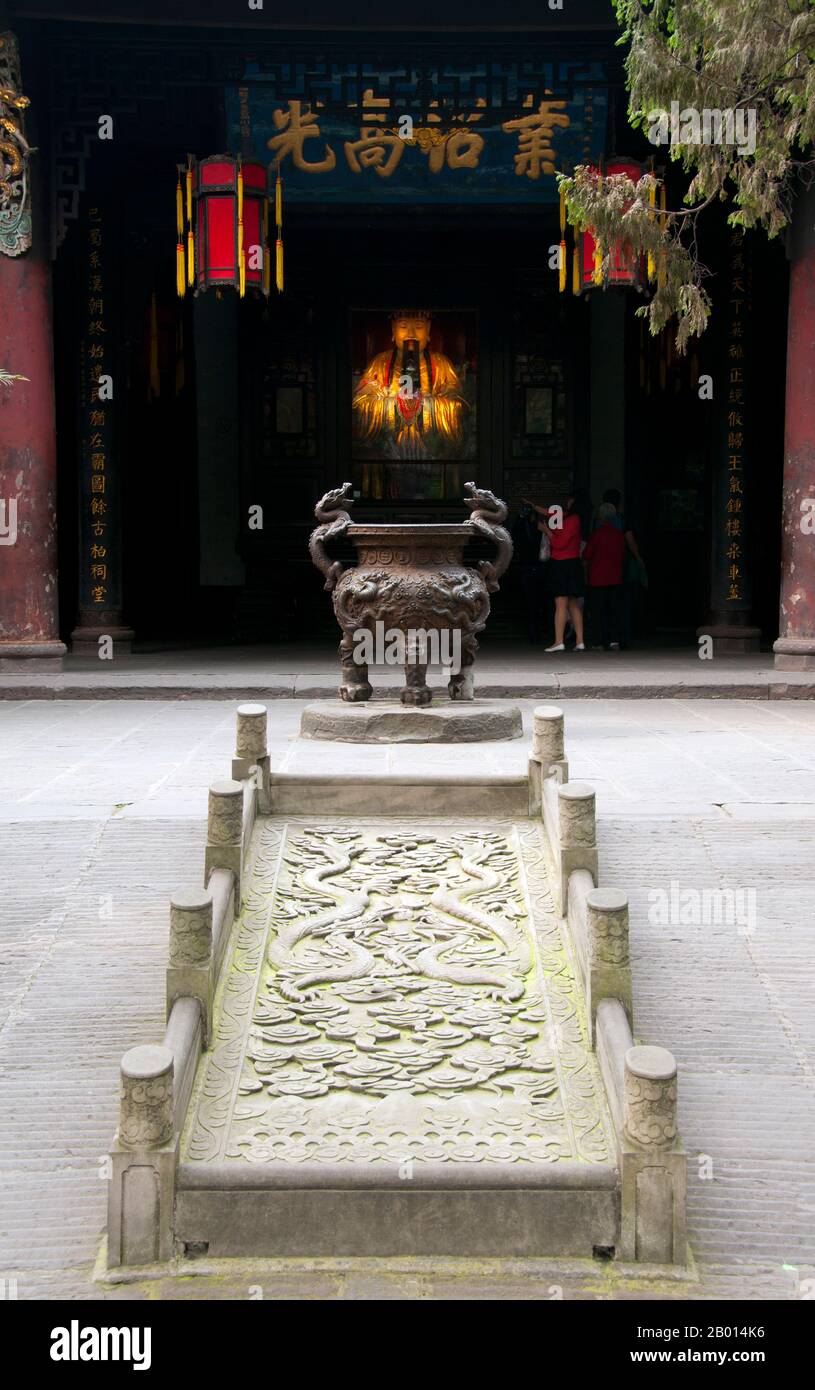 China: Liu Bei Palace, Wuhou Ci (Wuhou Ancestral or Memorial Hall), Chengdu, Sichuan Province. Liu Bei (161 – 21 June 223) was a warlord, military general and later as Emperor Zhaolie the founder of the state of Shu Han during the Three Kingdoms era of Chinese history. Despite having a later start than his rivals and lacking both the material resources and social status they commanded, Liu overcame his many defeats to carve out his own realm, which at its peak spanned modern day Sichuan, Guizhou, Hunan, part of Hubei and part of Gansu. Wuhou Ci is dedicated to Liu Bei and hero Zhuge Liang. Stock Photohttps://www.alamy.com/image-license-details/?v=1https://www.alamy.com/china-liu-bei-palace-wuhou-ci-wuhou-ancestral-or-memorial-hall-chengdu-sichuan-province-liu-bei-161-21-june-223-was-a-warlord-military-general-and-later-as-emperor-zhaolie-the-founder-of-the-state-of-shu-han-during-the-three-kingdoms-era-of-chinese-history-despite-having-a-later-start-than-his-rivals-and-lacking-both-the-material-resources-and-social-status-they-commanded-liu-overcame-his-many-defeats-to-carve-out-his-own-realm-which-at-its-peak-spanned-modern-day-sichuan-guizhou-hunan-part-of-hubei-and-part-of-gansu-wuhou-ci-is-dedicated-to-liu-bei-and-hero-zhuge-liang-image344232986.html
China: Liu Bei Palace, Wuhou Ci (Wuhou Ancestral or Memorial Hall), Chengdu, Sichuan Province. Liu Bei (161 – 21 June 223) was a warlord, military general and later as Emperor Zhaolie the founder of the state of Shu Han during the Three Kingdoms era of Chinese history. Despite having a later start than his rivals and lacking both the material resources and social status they commanded, Liu overcame his many defeats to carve out his own realm, which at its peak spanned modern day Sichuan, Guizhou, Hunan, part of Hubei and part of Gansu. Wuhou Ci is dedicated to Liu Bei and hero Zhuge Liang. Stock Photohttps://www.alamy.com/image-license-details/?v=1https://www.alamy.com/china-liu-bei-palace-wuhou-ci-wuhou-ancestral-or-memorial-hall-chengdu-sichuan-province-liu-bei-161-21-june-223-was-a-warlord-military-general-and-later-as-emperor-zhaolie-the-founder-of-the-state-of-shu-han-during-the-three-kingdoms-era-of-chinese-history-despite-having-a-later-start-than-his-rivals-and-lacking-both-the-material-resources-and-social-status-they-commanded-liu-overcame-his-many-defeats-to-carve-out-his-own-realm-which-at-its-peak-spanned-modern-day-sichuan-guizhou-hunan-part-of-hubei-and-part-of-gansu-wuhou-ci-is-dedicated-to-liu-bei-and-hero-zhuge-liang-image344232986.htmlRM2B014K6–China: Liu Bei Palace, Wuhou Ci (Wuhou Ancestral or Memorial Hall), Chengdu, Sichuan Province. Liu Bei (161 – 21 June 223) was a warlord, military general and later as Emperor Zhaolie the founder of the state of Shu Han during the Three Kingdoms era of Chinese history. Despite having a later start than his rivals and lacking both the material resources and social status they commanded, Liu overcame his many defeats to carve out his own realm, which at its peak spanned modern day Sichuan, Guizhou, Hunan, part of Hubei and part of Gansu. Wuhou Ci is dedicated to Liu Bei and hero Zhuge Liang.
 Liu Bei Portrait Stock Photohttps://www.alamy.com/image-license-details/?v=1https://www.alamy.com/stock-photo-liu-bei-portrait-140214281.html
Liu Bei Portrait Stock Photohttps://www.alamy.com/image-license-details/?v=1https://www.alamy.com/stock-photo-liu-bei-portrait-140214281.htmlRMJ438MW–Liu Bei Portrait
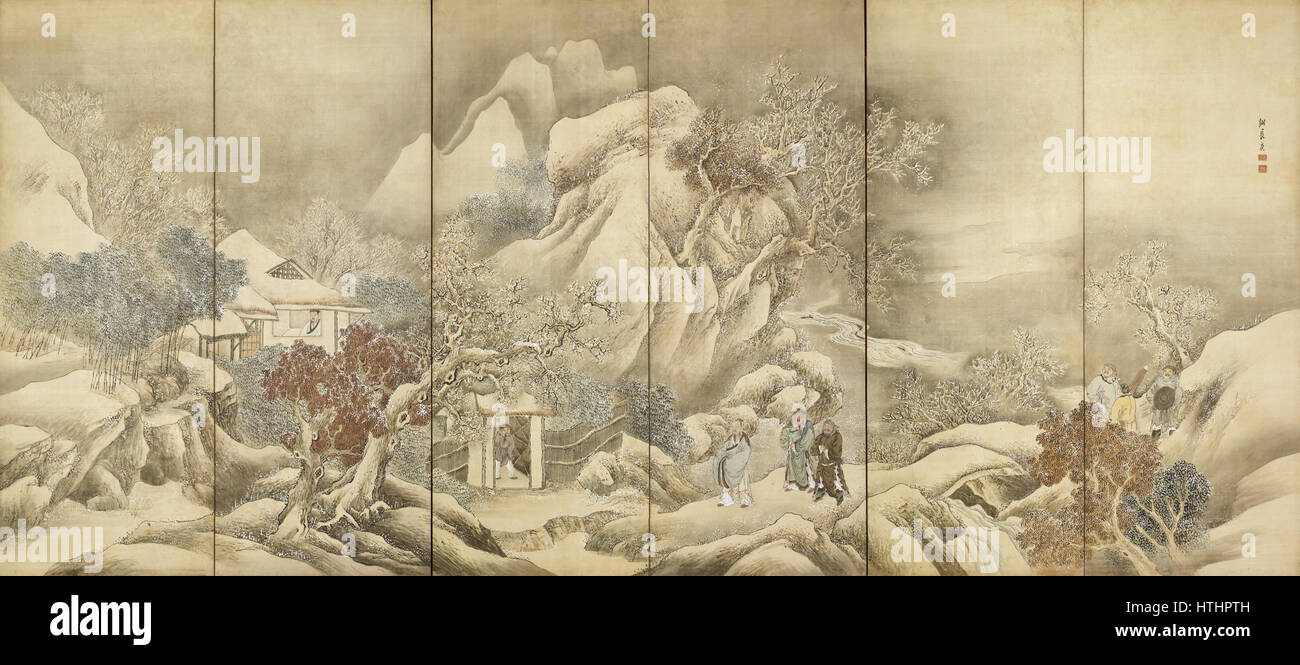 Liu Bei Visiting Zhuge Liang by Yosa Buson (Nomura Art Museum) Stock Photohttps://www.alamy.com/image-license-details/?v=1https://www.alamy.com/stock-photo-liu-bei-visiting-zhuge-liang-by-yosa-buson-nomura-art-museum-135615441.html
Liu Bei Visiting Zhuge Liang by Yosa Buson (Nomura Art Museum) Stock Photohttps://www.alamy.com/image-license-details/?v=1https://www.alamy.com/stock-photo-liu-bei-visiting-zhuge-liang-by-yosa-buson-nomura-art-museum-135615441.htmlRMHTHPTH–Liu Bei Visiting Zhuge Liang by Yosa Buson (Nomura Art Museum)
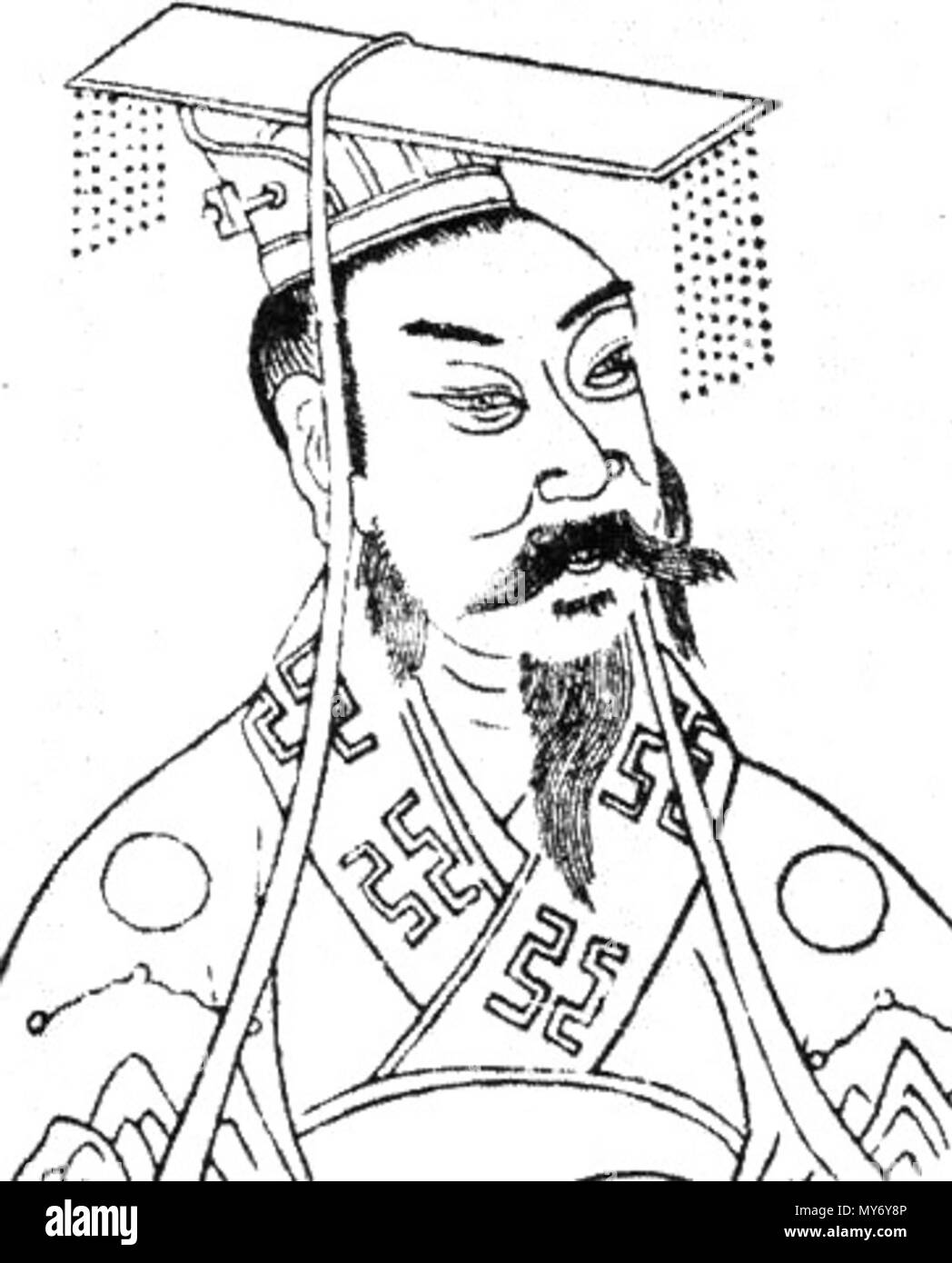 . English: Portrait of Liu Bei, maybe Ming Dynasty. Unknown date. Unknown 326 Liu Bei Portrait 2 Stock Photohttps://www.alamy.com/image-license-details/?v=1https://www.alamy.com/english-portrait-of-liu-bei-maybe-ming-dynasty-unknown-date-unknown-326-liu-bei-portrait-2-image188852518.html
. English: Portrait of Liu Bei, maybe Ming Dynasty. Unknown date. Unknown 326 Liu Bei Portrait 2 Stock Photohttps://www.alamy.com/image-license-details/?v=1https://www.alamy.com/english-portrait-of-liu-bei-maybe-ming-dynasty-unknown-date-unknown-326-liu-bei-portrait-2-image188852518.htmlRMMY6Y8P–. English: Portrait of Liu Bei, maybe Ming Dynasty. Unknown date. Unknown 326 Liu Bei Portrait 2
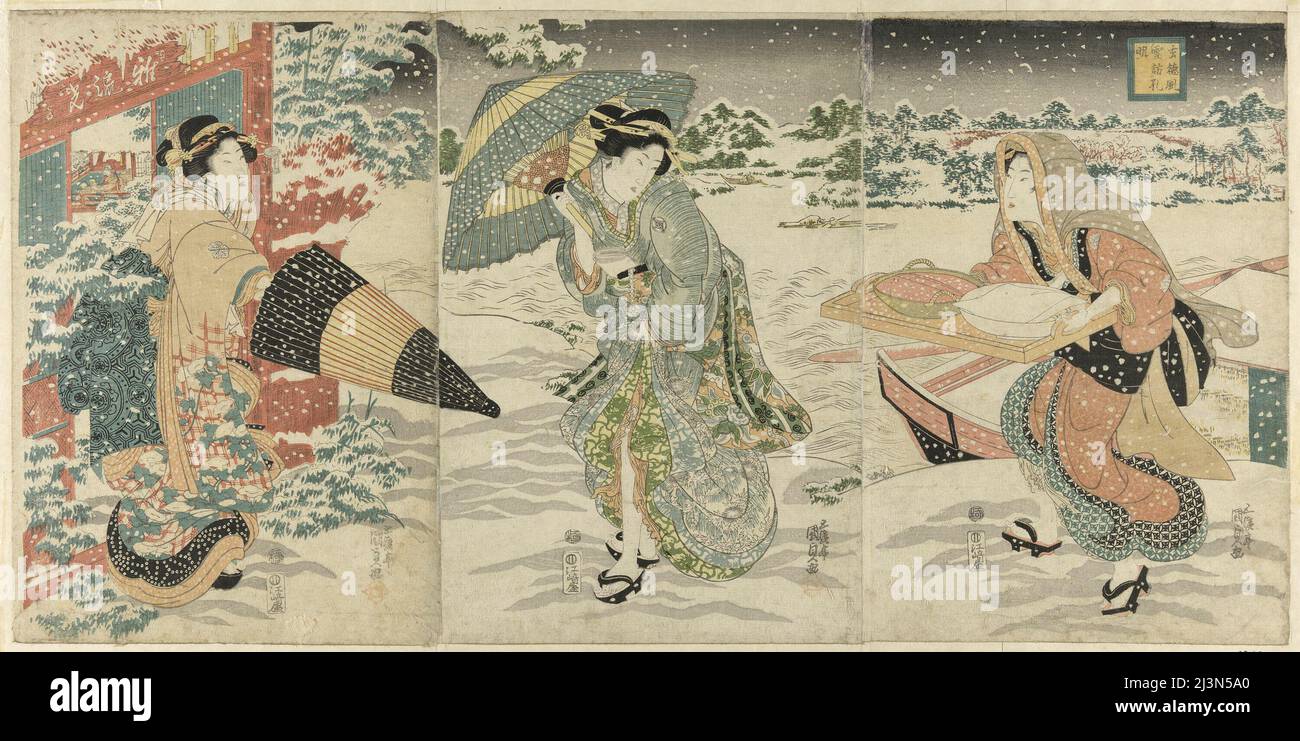 Parody of Liu Bei (J: Gentoku) Visiting Zhuge Liang (J: Komei) in Wind and Snow (Gentoku fusetsu ni Komei o tazureru), c. 1844. Stock Photohttps://www.alamy.com/image-license-details/?v=1https://www.alamy.com/parody-of-liu-bei-j-gentoku-visiting-zhuge-liang-j-komei-in-wind-and-snow-gentoku-fusetsu-ni-komei-o-tazureru-c-1844-image466989096.html
Parody of Liu Bei (J: Gentoku) Visiting Zhuge Liang (J: Komei) in Wind and Snow (Gentoku fusetsu ni Komei o tazureru), c. 1844. Stock Photohttps://www.alamy.com/image-license-details/?v=1https://www.alamy.com/parody-of-liu-bei-j-gentoku-visiting-zhuge-liang-j-komei-in-wind-and-snow-gentoku-fusetsu-ni-komei-o-tazureru-c-1844-image466989096.htmlRM2J3N5A0–Parody of Liu Bei (J: Gentoku) Visiting Zhuge Liang (J: Komei) in Wind and Snow (Gentoku fusetsu ni Komei o tazureru), c. 1844.
 Lucy Liu bei der „Red One - Alarmstufe Weihnachten“ Film Premiere am 3.11.2024 in Berlin Stock Photohttps://www.alamy.com/image-license-details/?v=1https://www.alamy.com/lucy-liu-bei-der-red-one-alarmstufe-weihnachten-film-premiere-am-3112024-in-berlin-image628961193.html
Lucy Liu bei der „Red One - Alarmstufe Weihnachten“ Film Premiere am 3.11.2024 in Berlin Stock Photohttps://www.alamy.com/image-license-details/?v=1https://www.alamy.com/lucy-liu-bei-der-red-one-alarmstufe-weihnachten-film-premiere-am-3112024-in-berlin-image628961193.htmlRF2YF7JBN–Lucy Liu bei der „Red One - Alarmstufe Weihnachten“ Film Premiere am 3.11.2024 in Berlin
 Lucy Liu bei der Premiere des Kinofilms 'Red One' im UCI Luxe. Berlin, 03.11.2024 Stock Photohttps://www.alamy.com/image-license-details/?v=1https://www.alamy.com/lucy-liu-bei-der-premiere-des-kinofilms-red-one-im-uci-luxe-berlin-03112024-image629002807.html
Lucy Liu bei der Premiere des Kinofilms 'Red One' im UCI Luxe. Berlin, 03.11.2024 Stock Photohttps://www.alamy.com/image-license-details/?v=1https://www.alamy.com/lucy-liu-bei-der-premiere-des-kinofilms-red-one-im-uci-luxe-berlin-03112024-image629002807.htmlRM2YF9FDY–Lucy Liu bei der Premiere des Kinofilms 'Red One' im UCI Luxe. Berlin, 03.11.2024
 Pair of dishes with scenes from Romance of the Three Kingdoms late 14th century China The narrative scenes on this pair of dishes probably derive from woodblock-print illustrations of the popular Chinese historical novel, Romance of the Three Kingdoms (Sanguo Yanyi). One vignette depicts General Liu Bei and his two sworn brothers at the house of Zhuge Liang, the scholar and strategist who helped Liu win many battles and found the Shu State during the Three Kingdoms period (220–65). The scene on the other dish has yet to be identified.. Pair of dishes with scenes from Romance of the Three Kingd Stock Photohttps://www.alamy.com/image-license-details/?v=1https://www.alamy.com/pair-of-dishes-with-scenes-from-romance-of-the-three-kingdoms-late-14th-century-china-the-narrative-scenes-on-this-pair-of-dishes-probably-derive-from-woodblock-print-illustrations-of-the-popular-chinese-historical-novel-romance-of-the-three-kingdoms-sanguo-yanyi-one-vignette-depicts-general-liu-bei-and-his-two-sworn-brothers-at-the-house-of-zhuge-liang-the-scholar-and-strategist-who-helped-liu-win-many-battles-and-found-the-shu-state-during-the-three-kingdoms-period-22065-the-scene-on-the-other-dish-has-yet-to-be-identified-pair-of-dishes-with-scenes-from-romance-of-the-three-kingd-image457926666.html
Pair of dishes with scenes from Romance of the Three Kingdoms late 14th century China The narrative scenes on this pair of dishes probably derive from woodblock-print illustrations of the popular Chinese historical novel, Romance of the Three Kingdoms (Sanguo Yanyi). One vignette depicts General Liu Bei and his two sworn brothers at the house of Zhuge Liang, the scholar and strategist who helped Liu win many battles and found the Shu State during the Three Kingdoms period (220–65). The scene on the other dish has yet to be identified.. Pair of dishes with scenes from Romance of the Three Kingd Stock Photohttps://www.alamy.com/image-license-details/?v=1https://www.alamy.com/pair-of-dishes-with-scenes-from-romance-of-the-three-kingdoms-late-14th-century-china-the-narrative-scenes-on-this-pair-of-dishes-probably-derive-from-woodblock-print-illustrations-of-the-popular-chinese-historical-novel-romance-of-the-three-kingdoms-sanguo-yanyi-one-vignette-depicts-general-liu-bei-and-his-two-sworn-brothers-at-the-house-of-zhuge-liang-the-scholar-and-strategist-who-helped-liu-win-many-battles-and-found-the-shu-state-during-the-three-kingdoms-period-22065-the-scene-on-the-other-dish-has-yet-to-be-identified-pair-of-dishes-with-scenes-from-romance-of-the-three-kingd-image457926666.htmlRM2HH0A3P–Pair of dishes with scenes from Romance of the Three Kingdoms late 14th century China The narrative scenes on this pair of dishes probably derive from woodblock-print illustrations of the popular Chinese historical novel, Romance of the Three Kingdoms (Sanguo Yanyi). One vignette depicts General Liu Bei and his two sworn brothers at the house of Zhuge Liang, the scholar and strategist who helped Liu win many battles and found the Shu State during the Three Kingdoms period (220–65). The scene on the other dish has yet to be identified.. Pair of dishes with scenes from Romance of the Three Kingd
 Wolong Hill, Supposed site in Nanyang, Henan Province, China, where Zhuge Liang was visited by Liu Bei three times before he accepted Liu Bei's offer to be his Prime Minister. Another city makes the same claim Stock Photohttps://www.alamy.com/image-license-details/?v=1https://www.alamy.com/wolong-hill-supposed-site-in-nanyang-henan-province-china-where-zhuge-liang-was-visited-by-liu-bei-three-times-before-he-accepted-liu-beis-offer-to-be-his-prime-minister-another-city-makes-the-same-claim-image573369439.html
Wolong Hill, Supposed site in Nanyang, Henan Province, China, where Zhuge Liang was visited by Liu Bei three times before he accepted Liu Bei's offer to be his Prime Minister. Another city makes the same claim Stock Photohttps://www.alamy.com/image-license-details/?v=1https://www.alamy.com/wolong-hill-supposed-site-in-nanyang-henan-province-china-where-zhuge-liang-was-visited-by-liu-bei-three-times-before-he-accepted-liu-beis-offer-to-be-his-prime-minister-another-city-makes-the-same-claim-image573369439.htmlRM2T8R6FY–Wolong Hill, Supposed site in Nanyang, Henan Province, China, where Zhuge Liang was visited by Liu Bei three times before he accepted Liu Bei's offer to be his Prime Minister. Another city makes the same claim
 Lucy Liu bei der Premiere des Kinofilms Red One im UCI Luxe. Berlin, 03.11.2024 *** Lucy Liu at the premiere of the movie Red One at UCI Luxe Berlin, 03 11 2024 Foto:xD.xHerrickx/xFuturexImagex red 4180 Stock Photohttps://www.alamy.com/image-license-details/?v=1https://www.alamy.com/lucy-liu-bei-der-premiere-des-kinofilms-red-one-im-uci-luxe-berlin-03112024-lucy-liu-at-the-premiere-of-the-movie-red-one-at-uci-luxe-berlin-03-11-2024-fotoxdxherrickxxfutureximagex-red-4180-image628998050.html
Lucy Liu bei der Premiere des Kinofilms Red One im UCI Luxe. Berlin, 03.11.2024 *** Lucy Liu at the premiere of the movie Red One at UCI Luxe Berlin, 03 11 2024 Foto:xD.xHerrickx/xFuturexImagex red 4180 Stock Photohttps://www.alamy.com/image-license-details/?v=1https://www.alamy.com/lucy-liu-bei-der-premiere-des-kinofilms-red-one-im-uci-luxe-berlin-03112024-lucy-liu-at-the-premiere-of-the-movie-red-one-at-uci-luxe-berlin-03-11-2024-fotoxdxherrickxxfutureximagex-red-4180-image628998050.htmlRM2YF99C2–Lucy Liu bei der Premiere des Kinofilms Red One im UCI Luxe. Berlin, 03.11.2024 *** Lucy Liu at the premiere of the movie Red One at UCI Luxe Berlin, 03 11 2024 Foto:xD.xHerrickx/xFuturexImagex red 4180
 Liu Bei, Lau Pei,dancing,Nian,Spring festival,zheng,Chinese New Year, celebrations, Manchester,event,Chinatown,performers,music Stock Photohttps://www.alamy.com/image-license-details/?v=1https://www.alamy.com/stock-photo-liu-bei-lau-peidancingnianspring-festivalzhengchinese-new-year-celebrations-130401978.html
Liu Bei, Lau Pei,dancing,Nian,Spring festival,zheng,Chinese New Year, celebrations, Manchester,event,Chinatown,performers,music Stock Photohttps://www.alamy.com/image-license-details/?v=1https://www.alamy.com/stock-photo-liu-bei-lau-peidancingnianspring-festivalzhengchinese-new-year-celebrations-130401978.htmlRMHG491E–Liu Bei, Lau Pei,dancing,Nian,Spring festival,zheng,Chinese New Year, celebrations, Manchester,event,Chinatown,performers,music
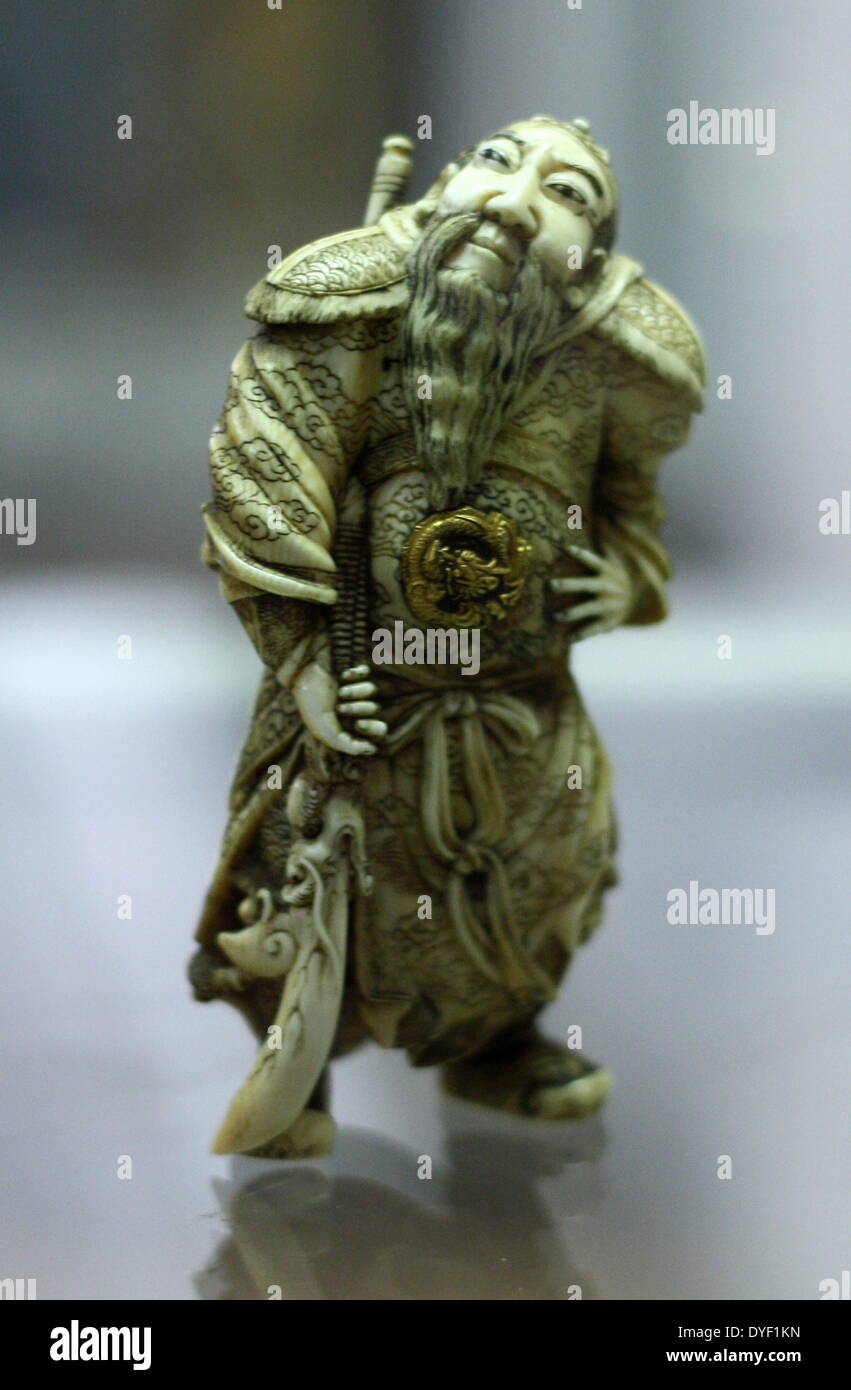 Japanese okimono representing legendary Chinese general Kanyu. Made from Ivory. Kanyu lived between 160-219 AD and was a general during the Three Kingdoms period in Chinese history. Stories of Kanyu (AKA Gaun Yu) are told in the 14th century novel 'Romance of the Three Kingdoms'. Was instrumental in helping Liu Bei to become the first emperor of the Kingdom of Shu. The artefact is highly detailed, and shows the artist had a great degree of skill. Stock Photohttps://www.alamy.com/image-license-details/?v=1https://www.alamy.com/japanese-okimono-representing-legendary-chinese-general-kanyu-made-image68557433.html
Japanese okimono representing legendary Chinese general Kanyu. Made from Ivory. Kanyu lived between 160-219 AD and was a general during the Three Kingdoms period in Chinese history. Stories of Kanyu (AKA Gaun Yu) are told in the 14th century novel 'Romance of the Three Kingdoms'. Was instrumental in helping Liu Bei to become the first emperor of the Kingdom of Shu. The artefact is highly detailed, and shows the artist had a great degree of skill. Stock Photohttps://www.alamy.com/image-license-details/?v=1https://www.alamy.com/japanese-okimono-representing-legendary-chinese-general-kanyu-made-image68557433.htmlRMDYF1KN–Japanese okimono representing legendary Chinese general Kanyu. Made from Ivory. Kanyu lived between 160-219 AD and was a general during the Three Kingdoms period in Chinese history. Stories of Kanyu (AKA Gaun Yu) are told in the 14th century novel 'Romance of the Three Kingdoms'. Was instrumental in helping Liu Bei to become the first emperor of the Kingdom of Shu. The artefact is highly detailed, and shows the artist had a great degree of skill.
 Vector illustration of ancient warrior series, Guan Yu was a Chinese military general serving under the warlord Liu Bei during the late Eastern Han dy Stock Vectorhttps://www.alamy.com/image-license-details/?v=1https://www.alamy.com/vector-illustration-of-ancient-warrior-series-guan-yu-was-a-chinese-military-general-serving-under-the-warlord-liu-bei-during-the-late-eastern-han-dy-image594099318.html
Vector illustration of ancient warrior series, Guan Yu was a Chinese military general serving under the warlord Liu Bei during the late Eastern Han dy Stock Vectorhttps://www.alamy.com/image-license-details/?v=1https://www.alamy.com/vector-illustration-of-ancient-warrior-series-guan-yu-was-a-chinese-military-general-serving-under-the-warlord-liu-bei-during-the-late-eastern-han-dy-image594099318.htmlRF2WEFFMP–Vector illustration of ancient warrior series, Guan Yu was a Chinese military general serving under the warlord Liu Bei during the late Eastern Han dy
 Wushi. Chinese New Year Celebration. Liu Bei Lion performs acrobatics to scare away demons in Chinatown. Stock Photohttps://www.alamy.com/image-license-details/?v=1https://www.alamy.com/stock-photo-wushi-chinese-new-year-celebration-liu-bei-lion-performs-acrobatics-22028037.html
Wushi. Chinese New Year Celebration. Liu Bei Lion performs acrobatics to scare away demons in Chinatown. Stock Photohttps://www.alamy.com/image-license-details/?v=1https://www.alamy.com/stock-photo-wushi-chinese-new-year-celebration-liu-bei-lion-performs-acrobatics-22028037.htmlRMB7RCYH–Wushi. Chinese New Year Celebration. Liu Bei Lion performs acrobatics to scare away demons in Chinatown.
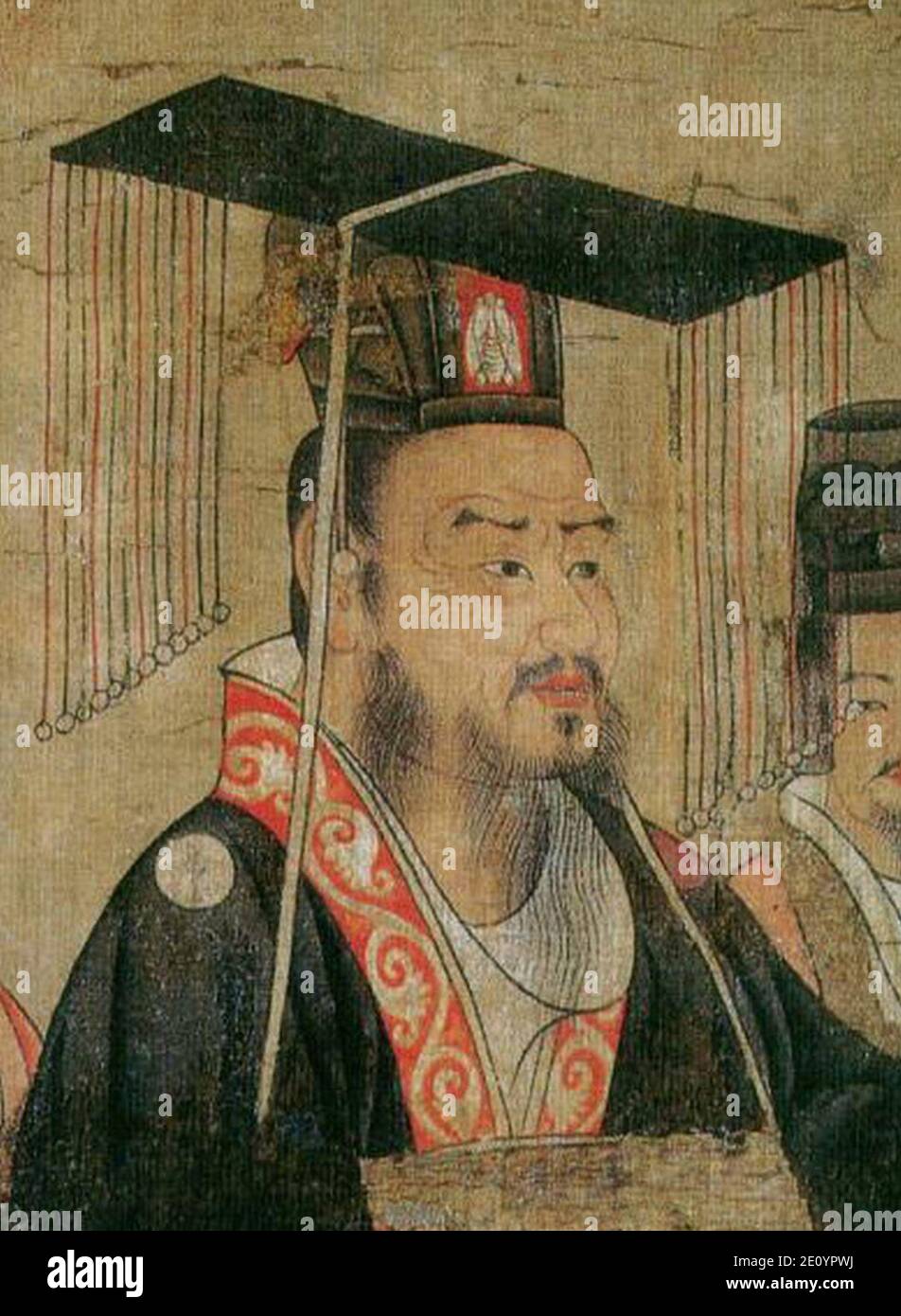 Liu Bei Tang-detail. Stock Photohttps://www.alamy.com/image-license-details/?v=1https://www.alamy.com/liu-bei-tang-detail-image396449134.html
Liu Bei Tang-detail. Stock Photohttps://www.alamy.com/image-license-details/?v=1https://www.alamy.com/liu-bei-tang-detail-image396449134.htmlRM2E0YPWJ–Liu Bei Tang-detail.
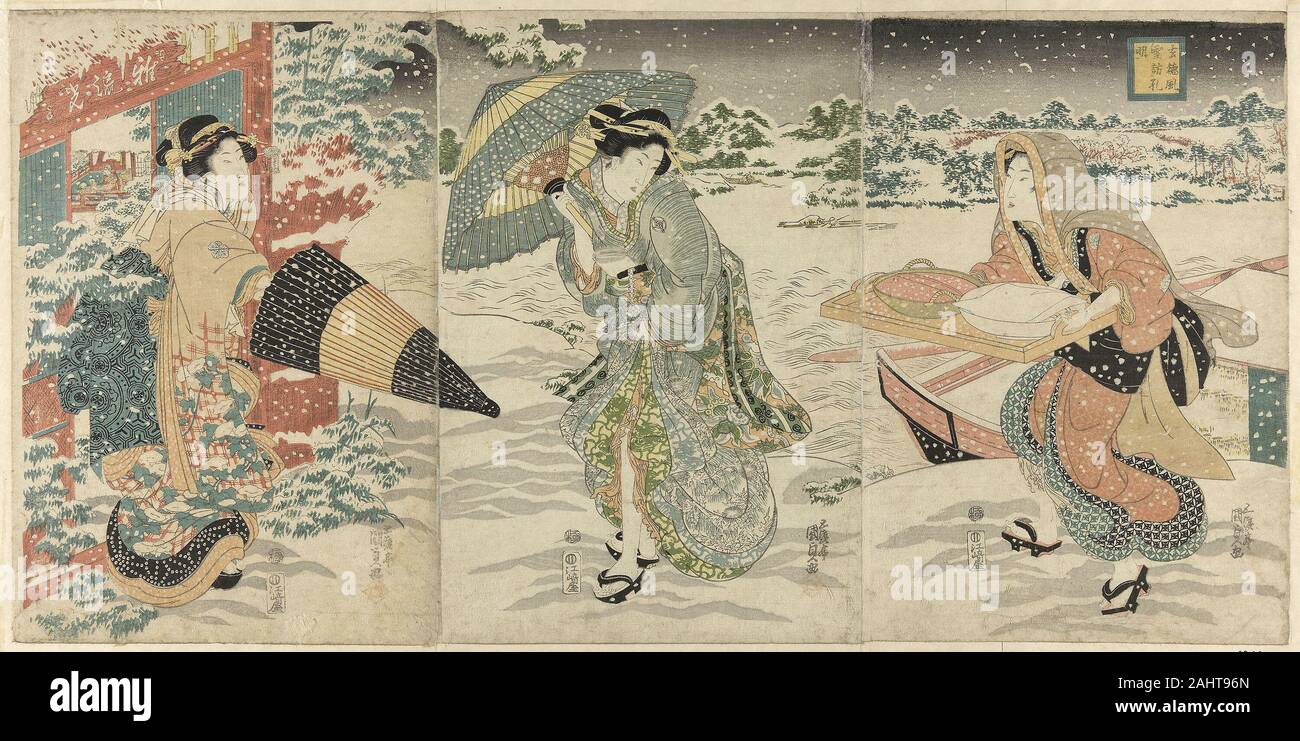 Utagawa Kunisada I (Toyokuni III). Parody of Liu Bei (J Gentoku) Visiting Zhuge Liang (J Komei) in Wind and Snow (Gentoku fusetsu ni Komei o tazureru). 1839–1849. Japan. Color woodblock print; oban triptych Stock Photohttps://www.alamy.com/image-license-details/?v=1https://www.alamy.com/utagawa-kunisada-i-toyokuni-iii-parody-of-liu-bei-j-gentoku-visiting-zhuge-liang-j-komei-in-wind-and-snow-gentoku-fusetsu-ni-komei-o-tazureru-18391849-japan-color-woodblock-print-oban-triptych-image337980237.html
Utagawa Kunisada I (Toyokuni III). Parody of Liu Bei (J Gentoku) Visiting Zhuge Liang (J Komei) in Wind and Snow (Gentoku fusetsu ni Komei o tazureru). 1839–1849. Japan. Color woodblock print; oban triptych Stock Photohttps://www.alamy.com/image-license-details/?v=1https://www.alamy.com/utagawa-kunisada-i-toyokuni-iii-parody-of-liu-bei-j-gentoku-visiting-zhuge-liang-j-komei-in-wind-and-snow-gentoku-fusetsu-ni-komei-o-tazureru-18391849-japan-color-woodblock-print-oban-triptych-image337980237.htmlRM2AHT96N–Utagawa Kunisada I (Toyokuni III). Parody of Liu Bei (J Gentoku) Visiting Zhuge Liang (J Komei) in Wind and Snow (Gentoku fusetsu ni Komei o tazureru). 1839–1849. Japan. Color woodblock print; oban triptych
 Linyi, Shandong, China. 18th July, 2014. A woman walks past a 'transformer' which is designed to be an image of Guan Yu, a Chinese general serving under the warlord Liu Bei in the late Eastern Han Dynasty (A.D. 25-220), in Linyi, east China's Shandong Province, July 18, 2014. The transformer, made of a veteran truck, is a works of Biheng, a contemporary young artist of China Central Academy of Fine Arts. It is 9.7 meters high and six meters wide, weighs about 10 metric tons. Credit: Xinhua/Alamy Live News Stock Photohttps://www.alamy.com/image-license-details/?v=1https://www.alamy.com/stock-photo-linyi-shandong-china-18th-july-2014-a-woman-walks-past-a-transformer-71964440.html
Linyi, Shandong, China. 18th July, 2014. A woman walks past a 'transformer' which is designed to be an image of Guan Yu, a Chinese general serving under the warlord Liu Bei in the late Eastern Han Dynasty (A.D. 25-220), in Linyi, east China's Shandong Province, July 18, 2014. The transformer, made of a veteran truck, is a works of Biheng, a contemporary young artist of China Central Academy of Fine Arts. It is 9.7 meters high and six meters wide, weighs about 10 metric tons. Credit: Xinhua/Alamy Live News Stock Photohttps://www.alamy.com/image-license-details/?v=1https://www.alamy.com/stock-photo-linyi-shandong-china-18th-july-2014-a-woman-walks-past-a-transformer-71964440.htmlRME527AG–Linyi, Shandong, China. 18th July, 2014. A woman walks past a 'transformer' which is designed to be an image of Guan Yu, a Chinese general serving under the warlord Liu Bei in the late Eastern Han Dynasty (A.D. 25-220), in Linyi, east China's Shandong Province, July 18, 2014. The transformer, made of a veteran truck, is a works of Biheng, a contemporary young artist of China Central Academy of Fine Arts. It is 9.7 meters high and six meters wide, weighs about 10 metric tons. Credit: Xinhua/Alamy Live News
 Beijing, Beijing, China. 10th Aug, 2018. Beijing, CHINA-A giant 'transformer' with the head of Guan Yu can be seen on street in Beijing, China.Guan Yu was a general serving under the warlord Liu Bei in the late Eastern Han dynasty. He played a significant role in the events that led to the end of the dynasty and the establishment of the state of Shu Han in the Three Kingdoms period. Credit: SIPA Asia/ZUMA Wire/Alamy Live News Stock Photohttps://www.alamy.com/image-license-details/?v=1https://www.alamy.com/beijing-beijing-china-10th-aug-2018-beijing-china-a-giant-transformer-with-the-head-of-guan-yu-can-be-seen-on-street-in-beijing-chinaguan-yu-was-a-general-serving-under-the-warlord-liu-bei-in-the-late-eastern-han-dynasty-he-played-a-significant-role-in-the-events-that-led-to-the-end-of-the-dynasty-and-the-establishment-of-the-state-of-shu-han-in-the-three-kingdoms-period-credit-sipa-asiazuma-wirealamy-live-news-image214899184.html
Beijing, Beijing, China. 10th Aug, 2018. Beijing, CHINA-A giant 'transformer' with the head of Guan Yu can be seen on street in Beijing, China.Guan Yu was a general serving under the warlord Liu Bei in the late Eastern Han dynasty. He played a significant role in the events that led to the end of the dynasty and the establishment of the state of Shu Han in the Three Kingdoms period. Credit: SIPA Asia/ZUMA Wire/Alamy Live News Stock Photohttps://www.alamy.com/image-license-details/?v=1https://www.alamy.com/beijing-beijing-china-10th-aug-2018-beijing-china-a-giant-transformer-with-the-head-of-guan-yu-can-be-seen-on-street-in-beijing-chinaguan-yu-was-a-general-serving-under-the-warlord-liu-bei-in-the-late-eastern-han-dynasty-he-played-a-significant-role-in-the-events-that-led-to-the-end-of-the-dynasty-and-the-establishment-of-the-state-of-shu-han-in-the-three-kingdoms-period-credit-sipa-asiazuma-wirealamy-live-news-image214899184.htmlRMPDHE2T–Beijing, Beijing, China. 10th Aug, 2018. Beijing, CHINA-A giant 'transformer' with the head of Guan Yu can be seen on street in Beijing, China.Guan Yu was a general serving under the warlord Liu Bei in the late Eastern Han dynasty. He played a significant role in the events that led to the end of the dynasty and the establishment of the state of Shu Han in the Three Kingdoms period. Credit: SIPA Asia/ZUMA Wire/Alamy Live News
 The statue of Liu Bei in the Wuhou Temple in Chengdu Stock Photohttps://www.alamy.com/image-license-details/?v=1https://www.alamy.com/the-statue-of-liu-bei-in-the-wuhou-temple-in-chengdu-image248414490.html
The statue of Liu Bei in the Wuhou Temple in Chengdu Stock Photohttps://www.alamy.com/image-license-details/?v=1https://www.alamy.com/the-statue-of-liu-bei-in-the-wuhou-temple-in-chengdu-image248414490.htmlRFTC4762–The statue of Liu Bei in the Wuhou Temple in Chengdu
 China: Rare bronze drum, Wuhou Ci (Wuhou Ancestral or Memorial Hall), Chengdu, Sichuan Province. Wuhou Ci is dedicated to Zhuge Liang, hero of the classic 'The Romance of the Three Kingdoms' and his emperor, Liu Bei. Zhuge Liang (181–234) was a chancellor of Shu Han during the Three Kingdoms period of Chinese history. He is often recognised as the greatest and most accomplished strategist of his era. Chengdu, known formerly as Chengtu, is the capital of Sichuan province in Southwest China. Stock Photohttps://www.alamy.com/image-license-details/?v=1https://www.alamy.com/china-rare-bronze-drum-wuhou-ci-wuhou-ancestral-or-memorial-hall-chengdu-sichuan-province-wuhou-ci-is-dedicated-to-zhuge-liang-hero-of-the-classic-the-romance-of-the-three-kingdoms-and-his-emperor-liu-bei-zhuge-liang-181234-was-a-chancellor-of-shu-han-during-the-three-kingdoms-period-of-chinese-history-he-is-often-recognised-as-the-greatest-and-most-accomplished-strategist-of-his-era-chengdu-known-formerly-as-chengtu-is-the-capital-of-sichuan-province-in-southwest-china-image344233043.html
China: Rare bronze drum, Wuhou Ci (Wuhou Ancestral or Memorial Hall), Chengdu, Sichuan Province. Wuhou Ci is dedicated to Zhuge Liang, hero of the classic 'The Romance of the Three Kingdoms' and his emperor, Liu Bei. Zhuge Liang (181–234) was a chancellor of Shu Han during the Three Kingdoms period of Chinese history. He is often recognised as the greatest and most accomplished strategist of his era. Chengdu, known formerly as Chengtu, is the capital of Sichuan province in Southwest China. Stock Photohttps://www.alamy.com/image-license-details/?v=1https://www.alamy.com/china-rare-bronze-drum-wuhou-ci-wuhou-ancestral-or-memorial-hall-chengdu-sichuan-province-wuhou-ci-is-dedicated-to-zhuge-liang-hero-of-the-classic-the-romance-of-the-three-kingdoms-and-his-emperor-liu-bei-zhuge-liang-181234-was-a-chancellor-of-shu-han-during-the-three-kingdoms-period-of-chinese-history-he-is-often-recognised-as-the-greatest-and-most-accomplished-strategist-of-his-era-chengdu-known-formerly-as-chengtu-is-the-capital-of-sichuan-province-in-southwest-china-image344233043.htmlRM2B014N7–China: Rare bronze drum, Wuhou Ci (Wuhou Ancestral or Memorial Hall), Chengdu, Sichuan Province. Wuhou Ci is dedicated to Zhuge Liang, hero of the classic 'The Romance of the Three Kingdoms' and his emperor, Liu Bei. Zhuge Liang (181–234) was a chancellor of Shu Han during the Three Kingdoms period of Chinese history. He is often recognised as the greatest and most accomplished strategist of his era. Chengdu, known formerly as Chengtu, is the capital of Sichuan province in Southwest China.
 Liu Bei Zhuge Liang Stock Photohttps://www.alamy.com/image-license-details/?v=1https://www.alamy.com/stock-photo-liu-bei-zhuge-liang-140155275.html
Liu Bei Zhuge Liang Stock Photohttps://www.alamy.com/image-license-details/?v=1https://www.alamy.com/stock-photo-liu-bei-zhuge-liang-140155275.htmlRMJ40HDF–Liu Bei Zhuge Liang
 Number One- Liu Bei; Number Two- Guan Yu; Number Three- Zhang Fei (5758870483) Stock Photohttps://www.alamy.com/image-license-details/?v=1https://www.alamy.com/stock-photo-number-one-liu-bei-number-two-guan-yu-number-three-zhang-fei-5758870483-134708125.html
Number One- Liu Bei; Number Two- Guan Yu; Number Three- Zhang Fei (5758870483) Stock Photohttps://www.alamy.com/image-license-details/?v=1https://www.alamy.com/stock-photo-number-one-liu-bei-number-two-guan-yu-number-three-zhang-fei-5758870483-134708125.htmlRMHR4DGD–Number One- Liu Bei; Number Two- Guan Yu; Number Three- Zhang Fei (5758870483)
 . Deutsch: Lü Bu kämpft in der Schlacht am Hulao-Pass gegen die Drei Brüder: Liu Bei (mit Schwertern), Guan Yu (mit Hellebarde) und Zhang Fei (mit Speer). English: Lü Bu fighting the Three Brothers at Hulao Pass: Liu Bei (swords), Guan Yu (halberd), and Zhang Fei (spear). العربية: لو بو يقاتل الأخوة الثلاثة عند معركة بوابة هولاو: ليو باي (السيوف)، وكوان يو (المطرد)، وجانغ فاي (الرمح). 1940. The picture above is a print from a Qing Dynasty edition of Luo Guanzhongs Romance of the Three Kingdoms 380 Lu Bu at Hulao Stock Photohttps://www.alamy.com/image-license-details/?v=1https://www.alamy.com/deutsch-l-bu-kmpft-in-der-schlacht-am-hulao-pass-gegen-die-drei-brder-liu-bei-mit-schwertern-guan-yu-mit-hellebarde-und-zhang-fei-mit-speer-english-l-bu-fighting-the-three-brothers-at-hulao-pass-liu-bei-swords-guan-yu-halberd-and-zhang-fei-spear-1940-the-picture-above-is-a-print-from-a-qing-dynasty-edition-of-luo-guanzhongs-romance-of-the-three-kingdoms-380-lu-bu-at-hulao-image188361614.html
. Deutsch: Lü Bu kämpft in der Schlacht am Hulao-Pass gegen die Drei Brüder: Liu Bei (mit Schwertern), Guan Yu (mit Hellebarde) und Zhang Fei (mit Speer). English: Lü Bu fighting the Three Brothers at Hulao Pass: Liu Bei (swords), Guan Yu (halberd), and Zhang Fei (spear). العربية: لو بو يقاتل الأخوة الثلاثة عند معركة بوابة هولاو: ليو باي (السيوف)، وكوان يو (المطرد)، وجانغ فاي (الرمح). 1940. The picture above is a print from a Qing Dynasty edition of Luo Guanzhongs Romance of the Three Kingdoms 380 Lu Bu at Hulao Stock Photohttps://www.alamy.com/image-license-details/?v=1https://www.alamy.com/deutsch-l-bu-kmpft-in-der-schlacht-am-hulao-pass-gegen-die-drei-brder-liu-bei-mit-schwertern-guan-yu-mit-hellebarde-und-zhang-fei-mit-speer-english-l-bu-fighting-the-three-brothers-at-hulao-pass-liu-bei-swords-guan-yu-halberd-and-zhang-fei-spear-1940-the-picture-above-is-a-print-from-a-qing-dynasty-edition-of-luo-guanzhongs-romance-of-the-three-kingdoms-380-lu-bu-at-hulao-image188361614.htmlRMMXCH4E–. Deutsch: Lü Bu kämpft in der Schlacht am Hulao-Pass gegen die Drei Brüder: Liu Bei (mit Schwertern), Guan Yu (mit Hellebarde) und Zhang Fei (mit Speer). English: Lü Bu fighting the Three Brothers at Hulao Pass: Liu Bei (swords), Guan Yu (halberd), and Zhang Fei (spear). العربية: لو بو يقاتل الأخوة الثلاثة عند معركة بوابة هولاو: ليو باي (السيوف)، وكوان يو (المطرد)، وجانغ فاي (الرمح). 1940. The picture above is a print from a Qing Dynasty edition of Luo Guanzhongs Romance of the Three Kingdoms 380 Lu Bu at Hulao
 LUCY LIU 2000 VANITY FAIR OSCAR PARTY LOS ANGELES USA 26 March 2000 Stock Photohttps://www.alamy.com/image-license-details/?v=1https://www.alamy.com/stock-photo-lucy-liu-2000-vanity-fair-oscar-party-los-angeles-usa-26-march-2000-125441460.html
LUCY LIU 2000 VANITY FAIR OSCAR PARTY LOS ANGELES USA 26 March 2000 Stock Photohttps://www.alamy.com/image-license-details/?v=1https://www.alamy.com/stock-photo-lucy-liu-2000-vanity-fair-oscar-party-los-angeles-usa-26-march-2000-125441460.htmlRMH829T4–LUCY LIU 2000 VANITY FAIR OSCAR PARTY LOS ANGELES USA 26 March 2000
 Lucy Liu bei der „Red One - Alarmstufe Weihnachten“ Film Premiere am 3.11.2024 in Berlin Stock Photohttps://www.alamy.com/image-license-details/?v=1https://www.alamy.com/lucy-liu-bei-der-red-one-alarmstufe-weihnachten-film-premiere-am-3112024-in-berlin-image628961202.html
Lucy Liu bei der „Red One - Alarmstufe Weihnachten“ Film Premiere am 3.11.2024 in Berlin Stock Photohttps://www.alamy.com/image-license-details/?v=1https://www.alamy.com/lucy-liu-bei-der-red-one-alarmstufe-weihnachten-film-premiere-am-3112024-in-berlin-image628961202.htmlRF2YF7JC2–Lucy Liu bei der „Red One - Alarmstufe Weihnachten“ Film Premiere am 3.11.2024 in Berlin
 Lucy Liu bei der Premiere des Kinofilms 'Red One' im UCI Luxe. Berlin, 03.11.2024 Stock Photohttps://www.alamy.com/image-license-details/?v=1https://www.alamy.com/lucy-liu-bei-der-premiere-des-kinofilms-red-one-im-uci-luxe-berlin-03112024-image629002784.html
Lucy Liu bei der Premiere des Kinofilms 'Red One' im UCI Luxe. Berlin, 03.11.2024 Stock Photohttps://www.alamy.com/image-license-details/?v=1https://www.alamy.com/lucy-liu-bei-der-premiere-des-kinofilms-red-one-im-uci-luxe-berlin-03112024-image629002784.htmlRM2YF9FD4–Lucy Liu bei der Premiere des Kinofilms 'Red One' im UCI Luxe. Berlin, 03.11.2024
 STOCKHOLM 20111130 Bei Ling, chinese poet and essayist. Bei Ling wrote the biography about the author and Nobel laureate Liu Xiaobo. Photo: Henrik Montgomery / SCANPIX kod 10060 Stock Photohttps://www.alamy.com/image-license-details/?v=1https://www.alamy.com/stockholm-20111130-bei-ling-chinese-poet-and-essayist-bei-ling-wrote-the-biography-about-the-author-and-nobel-laureate-liu-xiaobo-photo-henrik-montgomery-scanpix-kod-10060-image441483008.html
STOCKHOLM 20111130 Bei Ling, chinese poet and essayist. Bei Ling wrote the biography about the author and Nobel laureate Liu Xiaobo. Photo: Henrik Montgomery / SCANPIX kod 10060 Stock Photohttps://www.alamy.com/image-license-details/?v=1https://www.alamy.com/stockholm-20111130-bei-ling-chinese-poet-and-essayist-bei-ling-wrote-the-biography-about-the-author-and-nobel-laureate-liu-xiaobo-photo-henrik-montgomery-scanpix-kod-10060-image441483008.htmlRM2GJ7828–STOCKHOLM 20111130 Bei Ling, chinese poet and essayist. Bei Ling wrote the biography about the author and Nobel laureate Liu Xiaobo. Photo: Henrik Montgomery / SCANPIX kod 10060
 Wolong Hill, Supposed site in Nanyang, Henan Province, China, where Zhuge Liang was visited by Liu Bei three times before he accepted Liu Bei's offer to be his Prime Minister. Another city makes the same claim Stock Photohttps://www.alamy.com/image-license-details/?v=1https://www.alamy.com/wolong-hill-supposed-site-in-nanyang-henan-province-china-where-zhuge-liang-was-visited-by-liu-bei-three-times-before-he-accepted-liu-beis-offer-to-be-his-prime-minister-another-city-makes-the-same-claim-image573369432.html
Wolong Hill, Supposed site in Nanyang, Henan Province, China, where Zhuge Liang was visited by Liu Bei three times before he accepted Liu Bei's offer to be his Prime Minister. Another city makes the same claim Stock Photohttps://www.alamy.com/image-license-details/?v=1https://www.alamy.com/wolong-hill-supposed-site-in-nanyang-henan-province-china-where-zhuge-liang-was-visited-by-liu-bei-three-times-before-he-accepted-liu-beis-offer-to-be-his-prime-minister-another-city-makes-the-same-claim-image573369432.htmlRM2T8R6FM–Wolong Hill, Supposed site in Nanyang, Henan Province, China, where Zhuge Liang was visited by Liu Bei three times before he accepted Liu Bei's offer to be his Prime Minister. Another city makes the same claim
 Lucy Liu bei der Premiere des Kinofilms Red One im UCI Luxe. Berlin, 03.11.2024 *** Lucy Liu at the premiere of the movie Red One at UCI Luxe Berlin, 03 11 2024 Foto:xD.xHerrickx/xFuturexImagex red 4178 Stock Photohttps://www.alamy.com/image-license-details/?v=1https://www.alamy.com/lucy-liu-bei-der-premiere-des-kinofilms-red-one-im-uci-luxe-berlin-03112024-lucy-liu-at-the-premiere-of-the-movie-red-one-at-uci-luxe-berlin-03-11-2024-fotoxdxherrickxxfutureximagex-red-4178-image628998042.html
Lucy Liu bei der Premiere des Kinofilms Red One im UCI Luxe. Berlin, 03.11.2024 *** Lucy Liu at the premiere of the movie Red One at UCI Luxe Berlin, 03 11 2024 Foto:xD.xHerrickx/xFuturexImagex red 4178 Stock Photohttps://www.alamy.com/image-license-details/?v=1https://www.alamy.com/lucy-liu-bei-der-premiere-des-kinofilms-red-one-im-uci-luxe-berlin-03112024-lucy-liu-at-the-premiere-of-the-movie-red-one-at-uci-luxe-berlin-03-11-2024-fotoxdxherrickxxfutureximagex-red-4178-image628998042.htmlRM2YF99BP–Lucy Liu bei der Premiere des Kinofilms Red One im UCI Luxe. Berlin, 03.11.2024 *** Lucy Liu at the premiere of the movie Red One at UCI Luxe Berlin, 03 11 2024 Foto:xD.xHerrickx/xFuturexImagex red 4178
 Alysa Liu (USA), FEBRUARY 20, 2022 - Figure Skating : Gala Exhibition during the Beijing 2022 Olympic Winter Games at Capital Indoor Stadium in Bei Stock Photohttps://www.alamy.com/image-license-details/?v=1https://www.alamy.com/alysa-liu-usa-february-20-2022-figure-skating-gala-exhibition-during-the-beijing-2022-olympic-winter-games-at-capital-indoor-stadium-in-bei-image462765275.html
Alysa Liu (USA), FEBRUARY 20, 2022 - Figure Skating : Gala Exhibition during the Beijing 2022 Olympic Winter Games at Capital Indoor Stadium in Bei Stock Photohttps://www.alamy.com/image-license-details/?v=1https://www.alamy.com/alysa-liu-usa-february-20-2022-figure-skating-gala-exhibition-during-the-beijing-2022-olympic-winter-games-at-capital-indoor-stadium-in-bei-image462765275.htmlRM2HTTNR7–Alysa Liu (USA), FEBRUARY 20, 2022 - Figure Skating : Gala Exhibition during the Beijing 2022 Olympic Winter Games at Capital Indoor Stadium in Bei
 Japanese okimono representing legendary Chinese general Kanyu. Made from Ivory. Kanyu lived between 160-219 AD and was a general during the Three Kingdoms period in Chinese history. Stories of Kanyu (AKA Gaun Yu) are told in the 14th century novel 'Romance of the Three Kingdoms'. Was instrumental in helping Liu Bei to become the first emperor of the Kingdom of Shu. The artefact is highly detailed, and shows the artist had a great degree of skill. Stock Photohttps://www.alamy.com/image-license-details/?v=1https://www.alamy.com/japanese-okimono-representing-legendary-chinese-general-kanyu-made-image68557432.html
Japanese okimono representing legendary Chinese general Kanyu. Made from Ivory. Kanyu lived between 160-219 AD and was a general during the Three Kingdoms period in Chinese history. Stories of Kanyu (AKA Gaun Yu) are told in the 14th century novel 'Romance of the Three Kingdoms'. Was instrumental in helping Liu Bei to become the first emperor of the Kingdom of Shu. The artefact is highly detailed, and shows the artist had a great degree of skill. Stock Photohttps://www.alamy.com/image-license-details/?v=1https://www.alamy.com/japanese-okimono-representing-legendary-chinese-general-kanyu-made-image68557432.htmlRMDYF1KM–Japanese okimono representing legendary Chinese general Kanyu. Made from Ivory. Kanyu lived between 160-219 AD and was a general during the Three Kingdoms period in Chinese history. Stories of Kanyu (AKA Gaun Yu) are told in the 14th century novel 'Romance of the Three Kingdoms'. Was instrumental in helping Liu Bei to become the first emperor of the Kingdom of Shu. The artefact is highly detailed, and shows the artist had a great degree of skill.
 The Wu Hou Shrine, city of Chengdu, Sichuan Province, China. Roof tile motifs in the forecourt to Liu Bei's Mausoleum Stock Photohttps://www.alamy.com/image-license-details/?v=1https://www.alamy.com/stock-photo-the-wu-hou-shrine-city-of-chengdu-sichuan-province-china-roof-tile-112755647.html
The Wu Hou Shrine, city of Chengdu, Sichuan Province, China. Roof tile motifs in the forecourt to Liu Bei's Mausoleum Stock Photohttps://www.alamy.com/image-license-details/?v=1https://www.alamy.com/stock-photo-the-wu-hou-shrine-city-of-chengdu-sichuan-province-china-roof-tile-112755647.htmlRMGFCCYB–The Wu Hou Shrine, city of Chengdu, Sichuan Province, China. Roof tile motifs in the forecourt to Liu Bei's Mausoleum
 Le temple de Shaolin ou le temple des arts martiaux Nan bei Shao Lin Year: 1986 - hong kong affiche, poster Jet Li Director: Chia-Liang Liu Stock Photohttps://www.alamy.com/image-license-details/?v=1https://www.alamy.com/stock-photo-le-temple-de-shaolin-ou-le-temple-des-arts-martiaux-nan-bei-shao-lin-22073276.html
Le temple de Shaolin ou le temple des arts martiaux Nan bei Shao Lin Year: 1986 - hong kong affiche, poster Jet Li Director: Chia-Liang Liu Stock Photohttps://www.alamy.com/image-license-details/?v=1https://www.alamy.com/stock-photo-le-temple-de-shaolin-ou-le-temple-des-arts-martiaux-nan-bei-shao-lin-22073276.htmlRMB7WEK8–Le temple de Shaolin ou le temple des arts martiaux Nan bei Shao Lin Year: 1986 - hong kong affiche, poster Jet Li Director: Chia-Liang Liu
 Liu Bei Portrait 2. Stock Photohttps://www.alamy.com/image-license-details/?v=1https://www.alamy.com/liu-bei-portrait-2-image396449124.html
Liu Bei Portrait 2. Stock Photohttps://www.alamy.com/image-license-details/?v=1https://www.alamy.com/liu-bei-portrait-2-image396449124.htmlRM2E0YPW8–Liu Bei Portrait 2.
 Mitsogushi, der 'Futon-König', ist bei Anita zu Gast und besteht darauf, japanisch zu kochen. Das Ende ist tödlich für Mitsogushi. Darauf beschließt Anita, die ihr Ende nahen sieht, der Familie noch einmal so richtig die Meinung zu sagen. Szene mit ANITA KUPSCH, CHRISTOPH SCHOBESBERGER, WEIJIAN LIU, CORNELIUS OBONYA Regie: Uli MÜller aka. Anitas letzter Tag / Überschrift: Anitas Welt / Deutschland 1997 Stock Photohttps://www.alamy.com/image-license-details/?v=1https://www.alamy.com/mitsogushi-der-futon-knig-ist-bei-anita-zu-gast-und-besteht-darauf-japanisch-zu-kochen-das-ende-ist-tdlich-fr-mitsogushi-darauf-beschliet-anita-die-ihr-ende-nahen-sieht-der-familie-noch-einmal-so-richtig-die-meinung-zu-sagen-szene-mit-anita-kupsch-christoph-schobesberger-weijian-liu-cornelius-obonya-regie-uli-mller-aka-anitas-letzter-tag-berschrift-anitas-welt-deutschland-1997-image238118256.html
Mitsogushi, der 'Futon-König', ist bei Anita zu Gast und besteht darauf, japanisch zu kochen. Das Ende ist tödlich für Mitsogushi. Darauf beschließt Anita, die ihr Ende nahen sieht, der Familie noch einmal so richtig die Meinung zu sagen. Szene mit ANITA KUPSCH, CHRISTOPH SCHOBESBERGER, WEIJIAN LIU, CORNELIUS OBONYA Regie: Uli MÜller aka. Anitas letzter Tag / Überschrift: Anitas Welt / Deutschland 1997 Stock Photohttps://www.alamy.com/image-license-details/?v=1https://www.alamy.com/mitsogushi-der-futon-knig-ist-bei-anita-zu-gast-und-besteht-darauf-japanisch-zu-kochen-das-ende-ist-tdlich-fr-mitsogushi-darauf-beschliet-anita-die-ihr-ende-nahen-sieht-der-familie-noch-einmal-so-richtig-die-meinung-zu-sagen-szene-mit-anita-kupsch-christoph-schobesberger-weijian-liu-cornelius-obonya-regie-uli-mller-aka-anitas-letzter-tag-berschrift-anitas-welt-deutschland-1997-image238118256.htmlRMRRB67C–Mitsogushi, der 'Futon-König', ist bei Anita zu Gast und besteht darauf, japanisch zu kochen. Das Ende ist tödlich für Mitsogushi. Darauf beschließt Anita, die ihr Ende nahen sieht, der Familie noch einmal so richtig die Meinung zu sagen. Szene mit ANITA KUPSCH, CHRISTOPH SCHOBESBERGER, WEIJIAN LIU, CORNELIUS OBONYA Regie: Uli MÜller aka. Anitas letzter Tag / Überschrift: Anitas Welt / Deutschland 1997
 Linyi, Shandong, China. 18th July, 2014. A woman takes photo of a 'transformer' which is designed to be an image of Guan Yu, a Chinese general serving under the warlord Liu Bei in the late Eastern Han Dynasty (A.D. 25-220), in Linyi, east China's Shandong Province, July 18, 2014. The transformer, made of a veteran truck, is a works of Biheng, a contemporary young artist of China Central Academy of Fine Arts. It is 9.7 meters high and six meters wide, weighs about 10 metric tons. Credit: Xinhua/Alamy Live News Stock Photohttps://www.alamy.com/image-license-details/?v=1https://www.alamy.com/stock-photo-linyi-shandong-china-18th-july-2014-a-woman-takes-photo-of-a-transformer-71964439.html
Linyi, Shandong, China. 18th July, 2014. A woman takes photo of a 'transformer' which is designed to be an image of Guan Yu, a Chinese general serving under the warlord Liu Bei in the late Eastern Han Dynasty (A.D. 25-220), in Linyi, east China's Shandong Province, July 18, 2014. The transformer, made of a veteran truck, is a works of Biheng, a contemporary young artist of China Central Academy of Fine Arts. It is 9.7 meters high and six meters wide, weighs about 10 metric tons. Credit: Xinhua/Alamy Live News Stock Photohttps://www.alamy.com/image-license-details/?v=1https://www.alamy.com/stock-photo-linyi-shandong-china-18th-july-2014-a-woman-takes-photo-of-a-transformer-71964439.htmlRME527AF–Linyi, Shandong, China. 18th July, 2014. A woman takes photo of a 'transformer' which is designed to be an image of Guan Yu, a Chinese general serving under the warlord Liu Bei in the late Eastern Han Dynasty (A.D. 25-220), in Linyi, east China's Shandong Province, July 18, 2014. The transformer, made of a veteran truck, is a works of Biheng, a contemporary young artist of China Central Academy of Fine Arts. It is 9.7 meters high and six meters wide, weighs about 10 metric tons. Credit: Xinhua/Alamy Live News
 Beijing, Beijing, China. 10th Aug, 2018. Beijing, CHINA-A giant 'transformer' with the head of Guan Yu can be seen on street in Beijing, China.Guan Yu was a general serving under the warlord Liu Bei in the late Eastern Han dynasty. He played a significant role in the events that led to the end of the dynasty and the establishment of the state of Shu Han in the Three Kingdoms period. Credit: SIPA Asia/ZUMA Wire/Alamy Live News Stock Photohttps://www.alamy.com/image-license-details/?v=1https://www.alamy.com/beijing-beijing-china-10th-aug-2018-beijing-china-a-giant-transformer-with-the-head-of-guan-yu-can-be-seen-on-street-in-beijing-chinaguan-yu-was-a-general-serving-under-the-warlord-liu-bei-in-the-late-eastern-han-dynasty-he-played-a-significant-role-in-the-events-that-led-to-the-end-of-the-dynasty-and-the-establishment-of-the-state-of-shu-han-in-the-three-kingdoms-period-credit-sipa-asiazuma-wirealamy-live-news-image214899189.html
Beijing, Beijing, China. 10th Aug, 2018. Beijing, CHINA-A giant 'transformer' with the head of Guan Yu can be seen on street in Beijing, China.Guan Yu was a general serving under the warlord Liu Bei in the late Eastern Han dynasty. He played a significant role in the events that led to the end of the dynasty and the establishment of the state of Shu Han in the Three Kingdoms period. Credit: SIPA Asia/ZUMA Wire/Alamy Live News Stock Photohttps://www.alamy.com/image-license-details/?v=1https://www.alamy.com/beijing-beijing-china-10th-aug-2018-beijing-china-a-giant-transformer-with-the-head-of-guan-yu-can-be-seen-on-street-in-beijing-chinaguan-yu-was-a-general-serving-under-the-warlord-liu-bei-in-the-late-eastern-han-dynasty-he-played-a-significant-role-in-the-events-that-led-to-the-end-of-the-dynasty-and-the-establishment-of-the-state-of-shu-han-in-the-three-kingdoms-period-credit-sipa-asiazuma-wirealamy-live-news-image214899189.htmlRMPDHE31–Beijing, Beijing, China. 10th Aug, 2018. Beijing, CHINA-A giant 'transformer' with the head of Guan Yu can be seen on street in Beijing, China.Guan Yu was a general serving under the warlord Liu Bei in the late Eastern Han dynasty. He played a significant role in the events that led to the end of the dynasty and the establishment of the state of Shu Han in the Three Kingdoms period. Credit: SIPA Asia/ZUMA Wire/Alamy Live News
 The statue of Liu Bei in the Wuhou Temple in Chengdu Stock Photohttps://www.alamy.com/image-license-details/?v=1https://www.alamy.com/the-statue-of-liu-bei-in-the-wuhou-temple-in-chengdu-image248829733.html
The statue of Liu Bei in the Wuhou Temple in Chengdu Stock Photohttps://www.alamy.com/image-license-details/?v=1https://www.alamy.com/the-statue-of-liu-bei-in-the-wuhou-temple-in-chengdu-image248829733.htmlRFTCR4T5–The statue of Liu Bei in the Wuhou Temple in Chengdu
 China: Wuhou Ci (Wuhou Ancestral or Memorial Hall), Chengdu, Sichuan Province. Wuhou Ci is dedicated to Zhuge Liang, hero of the classic 'The Romance of the Three Kingdoms' and his emperor, Liu Bei. Zhuge Liang (181–234) was a chancellor of Shu Han during the Three Kingdoms period of Chinese history. He is often recognised as the greatest and most accomplished strategist of his era. Chengdu, known formerly as Chengtu, is the capital of Sichuan province in Southwest China. In the early 4th century BC, the 9th Kaiming king of the ancient Shu moved his capital to the city's current location. Stock Photohttps://www.alamy.com/image-license-details/?v=1https://www.alamy.com/china-wuhou-ci-wuhou-ancestral-or-memorial-hall-chengdu-sichuan-province-wuhou-ci-is-dedicated-to-zhuge-liang-hero-of-the-classic-the-romance-of-the-three-kingdoms-and-his-emperor-liu-bei-zhuge-liang-181234-was-a-chancellor-of-shu-han-during-the-three-kingdoms-period-of-chinese-history-he-is-often-recognised-as-the-greatest-and-most-accomplished-strategist-of-his-era-chengdu-known-formerly-as-chengtu-is-the-capital-of-sichuan-province-in-southwest-china-in-the-early-4th-century-bc-the-9th-kaiming-king-of-the-ancient-shu-moved-his-capital-to-the-citys-current-location-image344233025.html
China: Wuhou Ci (Wuhou Ancestral or Memorial Hall), Chengdu, Sichuan Province. Wuhou Ci is dedicated to Zhuge Liang, hero of the classic 'The Romance of the Three Kingdoms' and his emperor, Liu Bei. Zhuge Liang (181–234) was a chancellor of Shu Han during the Three Kingdoms period of Chinese history. He is often recognised as the greatest and most accomplished strategist of his era. Chengdu, known formerly as Chengtu, is the capital of Sichuan province in Southwest China. In the early 4th century BC, the 9th Kaiming king of the ancient Shu moved his capital to the city's current location. Stock Photohttps://www.alamy.com/image-license-details/?v=1https://www.alamy.com/china-wuhou-ci-wuhou-ancestral-or-memorial-hall-chengdu-sichuan-province-wuhou-ci-is-dedicated-to-zhuge-liang-hero-of-the-classic-the-romance-of-the-three-kingdoms-and-his-emperor-liu-bei-zhuge-liang-181234-was-a-chancellor-of-shu-han-during-the-three-kingdoms-period-of-chinese-history-he-is-often-recognised-as-the-greatest-and-most-accomplished-strategist-of-his-era-chengdu-known-formerly-as-chengtu-is-the-capital-of-sichuan-province-in-southwest-china-in-the-early-4th-century-bc-the-9th-kaiming-king-of-the-ancient-shu-moved-his-capital-to-the-citys-current-location-image344233025.htmlRM2B014MH–China: Wuhou Ci (Wuhou Ancestral or Memorial Hall), Chengdu, Sichuan Province. Wuhou Ci is dedicated to Zhuge Liang, hero of the classic 'The Romance of the Three Kingdoms' and his emperor, Liu Bei. Zhuge Liang (181–234) was a chancellor of Shu Han during the Three Kingdoms period of Chinese history. He is often recognised as the greatest and most accomplished strategist of his era. Chengdu, known formerly as Chengtu, is the capital of Sichuan province in Southwest China. In the early 4th century BC, the 9th Kaiming king of the ancient Shu moved his capital to the city's current location.

